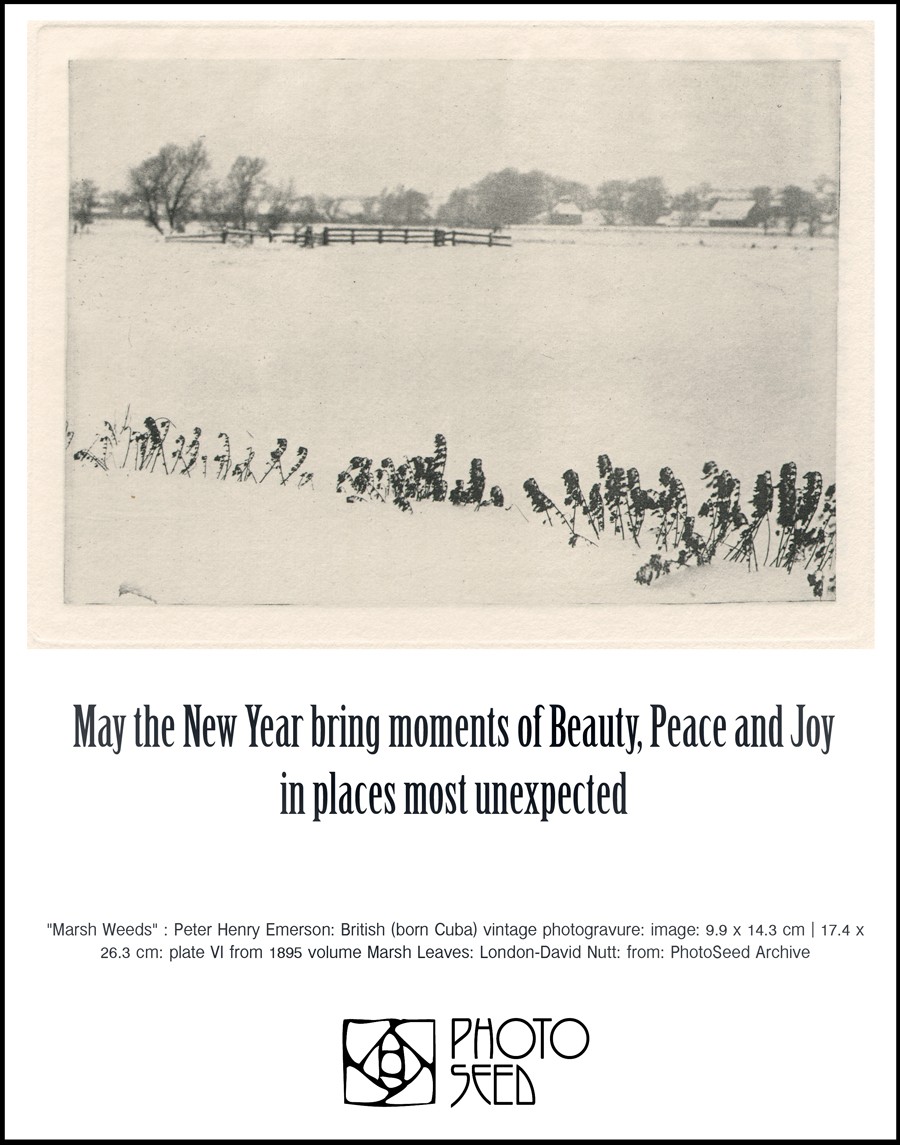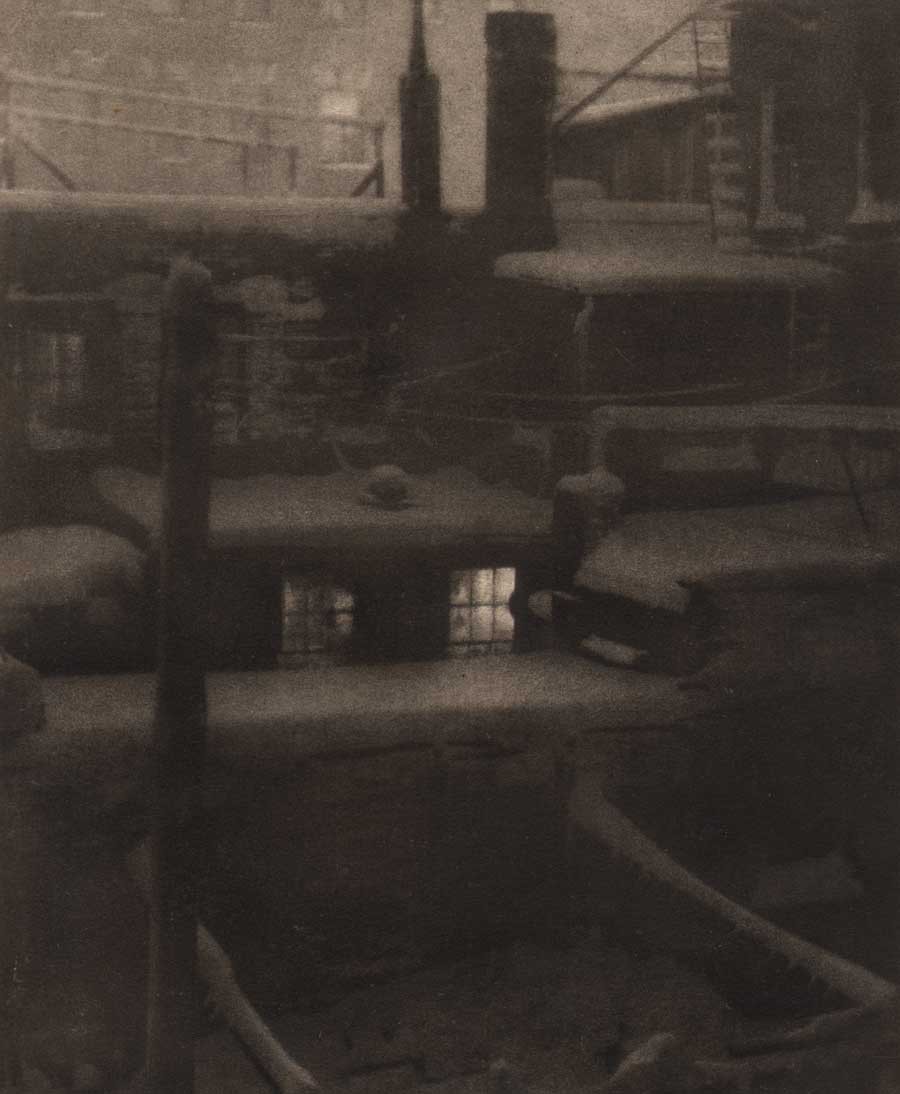Category
Significant Photographs
19 entries in this category | view all categories
Deep Holbein
Posted March 2021 in Alternate Processes, Color Photography, New Additions, Significant Photographers, Significant Photographs
A reappraisal of old photos has recently invaded the public conversation of late. Artificial intelligence, in the form of video driver technology invented by Israeli company D-ID, was licensed earlier this year to genealogy and DNA company MyHeritage with the moniker Deep Nostalgia™. Old photographs, no matter their original medium, are brought to life as short animated video clips, and may never be seen in the same way again.
 Screenshot: Animated “A Holbein Woman” from YouTube. Cropped image of the same by American photographers Frances & Mary Electa Allen, ca. 1890 using the Deep Nostalgia™ app licensed to genealogy and DNA company MyHeritage. Original source photograph from PhotoSeed Archive.
Screenshot: Animated “A Holbein Woman” from YouTube. Cropped image of the same by American photographers Frances & Mary Electa Allen, ca. 1890 using the Deep Nostalgia™ app licensed to genealogy and DNA company MyHeritage. Original source photograph from PhotoSeed Archive.
Taking up the company’s free offer to try out the technology, I applied it to a recent archive acquisition, A Holbein Woman, taken in the very early 1890’s by Deerfield, Massachusetts sister photographers Frances Stebbins and Mary Electa Allen. You can see the result in a short 12 second video posted to YouTube embedded above in this post.
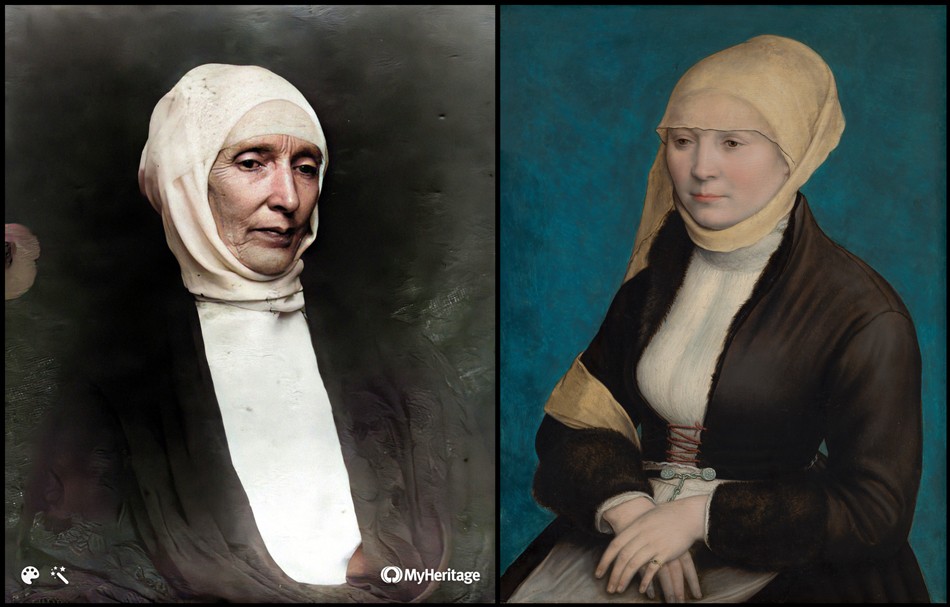 Left: Colorized version of “A Holbein Woman” by American photographers Frances & Mary Electa Allen, ca. 1890. Created by DeOldify deep learning experts Jason Antic and Dana Kelley, this colorizing technology has been licensed from DeOldify by DNA company MyHeritage, with their branding of MyHeritage In Color™. Source photograph from PhotoSeed Archive. Right: “Portrait of a Woman from Southern Germany”: c. 1520-25: Formerly attributed to Hans Holbein the Younger, Germany: (1497/1498-1543): Oil on panel: 45 x 34 cm: Courtesy: collection of the Mauritshuis museum in The Hague.
Left: Colorized version of “A Holbein Woman” by American photographers Frances & Mary Electa Allen, ca. 1890. Created by DeOldify deep learning experts Jason Antic and Dana Kelley, this colorizing technology has been licensed from DeOldify by DNA company MyHeritage, with their branding of MyHeritage In Color™. Source photograph from PhotoSeed Archive. Right: “Portrait of a Woman from Southern Germany”: c. 1520-25: Formerly attributed to Hans Holbein the Younger, Germany: (1497/1498-1543): Oil on panel: 45 x 34 cm: Courtesy: collection of the Mauritshuis museum in The Hague.
The photograph, considered a masterwork of early genre pictorialist portrait photography, is of their mother Mary Stebbins Allen, (1819-1903) and in itself done after the then fashionable practice (1.) of an imitation painting: in this case, a Renaissance portrait by Bavarian artist Hans Holbein the Elder. (c. 1460-1524) To add another layer of mystery, research I did last year revealed the primary source portrait- the oil painting (c.1520-1525) known as “Portrait of a Woman from Southern Germany” in the collection of the Mauritshuis museum in The Hague, was originally attributed to Holbein’s son “The Younger”, (c. 1497-1543) with the now updated disclaimer by the museum’s curators as being “formerly attributed” to this artist. This painting can be seen at upper right, with a colorized version of the Allen sisters portrait run through remarkable colorization technology MyHeritage In Color™ at left.
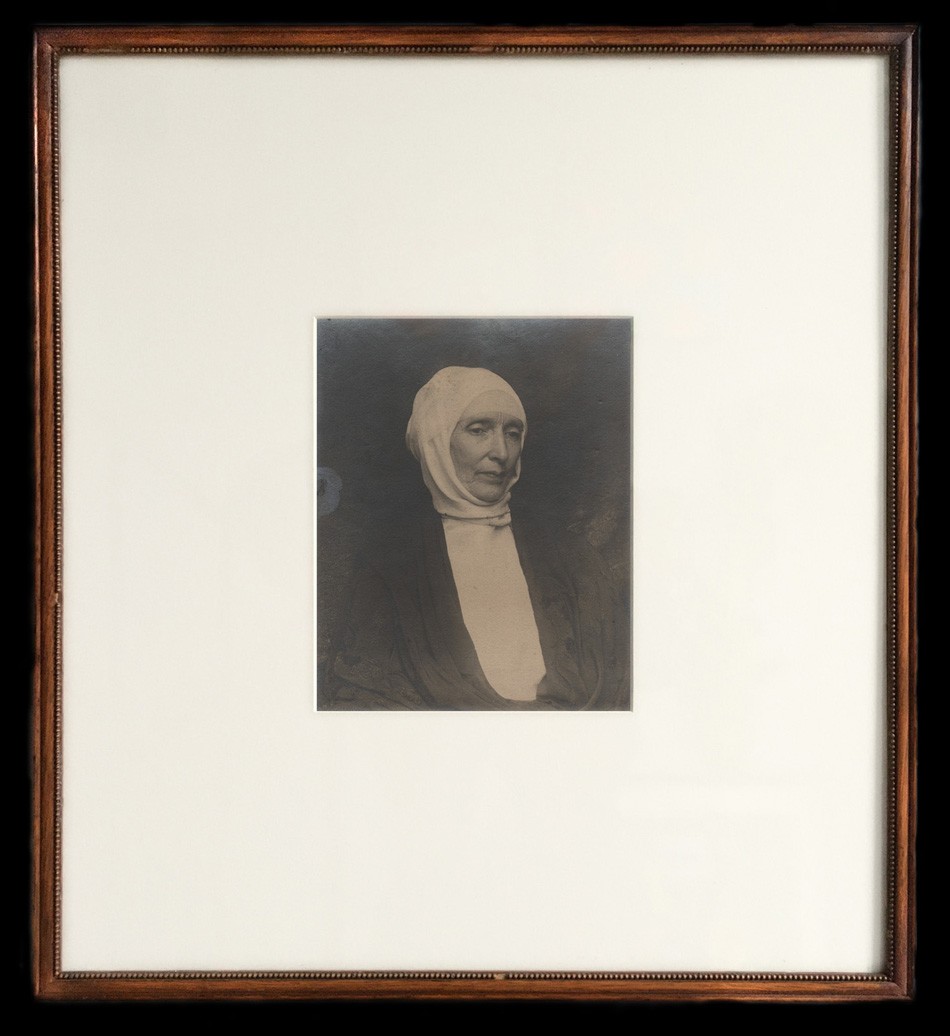 “A Holbein Woman”: Frances Stebbins & Mary Electa Allen, American: 1854-1941 & 1858–1941. Gelatin silver print ca. 1890: 20.1 x 16.3 cm laid down on light gray card mount 35.2 x 27.8 cm: presented here in original ca. 1896 beaded wood frame by Greenfield, MA framer Dunklee & Freeman with original overmat replaced. Done with the intent of being a tribute imitation painting to Hans Holbein’s “Portrait of a Woman from Southern Germany”, the subject of this portrait is the photographer’s mother Mary Stebbins Allen. (1819-1903) The result: “A Holbein Woman”, was one of the earliest and most successful examples of portraiture done by the Deerfield, MA sisters. From: PhotoSeed Archive.
“A Holbein Woman”: Frances Stebbins & Mary Electa Allen, American: 1854-1941 & 1858–1941. Gelatin silver print ca. 1890: 20.1 x 16.3 cm laid down on light gray card mount 35.2 x 27.8 cm: presented here in original ca. 1896 beaded wood frame by Greenfield, MA framer Dunklee & Freeman with original overmat replaced. Done with the intent of being a tribute imitation painting to Hans Holbein’s “Portrait of a Woman from Southern Germany”, the subject of this portrait is the photographer’s mother Mary Stebbins Allen. (1819-1903) The result: “A Holbein Woman”, was one of the earliest and most successful examples of portraiture done by the Deerfield, MA sisters. From: PhotoSeed Archive.
Another words, if being accurate to revisionist history but without the convenient addition of a famous name, (2.) the Allen sisters efforts in the modern day might conceivably be retitled “A Formerly Attributed Woman” rather than “A Holbein Woman”.
And although it is but one example reanimated from that era using new technology, it seems reasonable to conclude 21st Century progress courtesy of Deep Nostalgia™ may only reinforce and belie a continuation of certain prejudices and expectations from the past, the same criticism that could be leveled at video driver technology being only an approximation of humanity, leaving us devoid of the true mannerisms of those who actually lived.
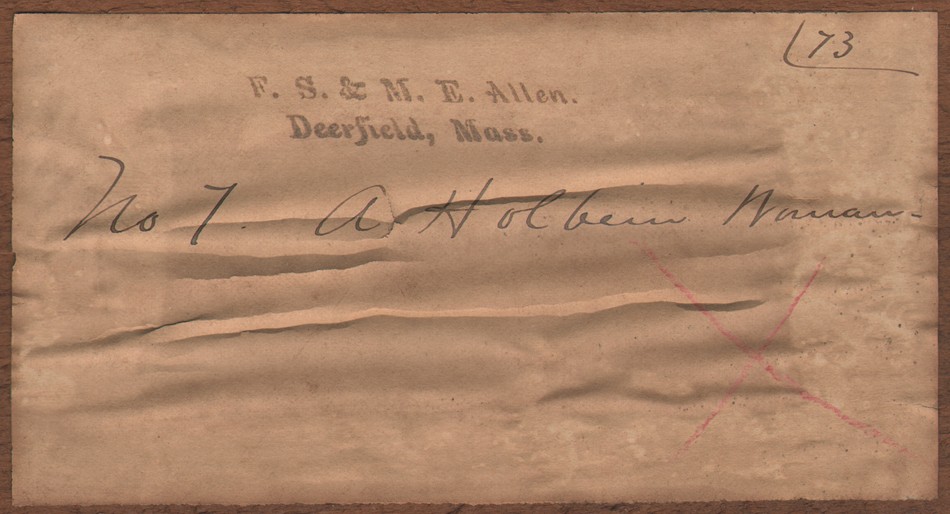 Exhibition label: “A Holbein Woman”: ca. 1896. Pasted white-paper label (7.2 x 13.6 cm) (preserved and cut out from) wood backing board with black ink photographers stamp: F.S. & M.E. Allen. Deerfield, Mass.; in black ink believed to be in the hand of the photographers: No 7 A Holbein Woman: 73 to upper right corner, faint X mark in red ink in lower right. From: PhotoSeed Archive
Exhibition label: “A Holbein Woman”: ca. 1896. Pasted white-paper label (7.2 x 13.6 cm) (preserved and cut out from) wood backing board with black ink photographers stamp: F.S. & M.E. Allen. Deerfield, Mass.; in black ink believed to be in the hand of the photographers: No 7 A Holbein Woman: 73 to upper right corner, faint X mark in red ink in lower right. From: PhotoSeed Archive
“Creepy” is one online descriptor I kept encountering in people’s reactions to this new technology, but when has that ever stopped “progress”? (3.) Are we doomed or can fleeting perceptions of the past in old photographs brought to “life” change our future for the better, our marveling reactions to it as incidental as the new shiny object of the here and now? Only time will tell. (4.) David Spencer-
Notes:
1. The worldwide pandemic brought on by COVID-19 lockdowns inspired a massive revival of imitation paintings and other works of art including photography. Amsterdam’s Rijksmuseum in March, 2020 promoted their Stay at Home Challenge!, inviting people to recreate modern day reinterpretations from masterworks in their collection. This was soon followed by the Getty museum in California. One of the very first “challenge” accounts to promote this revived genre was the Netherlands Instagram account Tussen Kunst & Quarantaine- translating to “between art and quarantine” which first inspired the Rijksmuseum challenge.
2. This would never happen.
3. An examination of ethical concerns as a result of so-called Deepfake technology contained within Deep Nostalgia™ is explored in a New York Times article written by Daniel Victor from March 10, 2021: Your Loved Ones, and Eerie Tom Cruise Videos, Reanimate Unease With Deepfakes.
4. That shiny object has been here since February, 2021. Care to upload a selfie, historical photograph or stock pic of Kim Jong-un, Mao Zedong or Joe Biden and see yourself or them “sing” to popular music? Then download the WOMBO app here. Guardian technology columnist Helen Sullivan reports on March 12, 2021 the app just might be giving competition to Deep Nostalgia™.
Heaven on Earth
Posted July 2020 in New Additions, Significant Photographers, Significant Photographs
America’s birthday is best defined by the natural beauty of her National Parks, undisturbed by man’s folly.
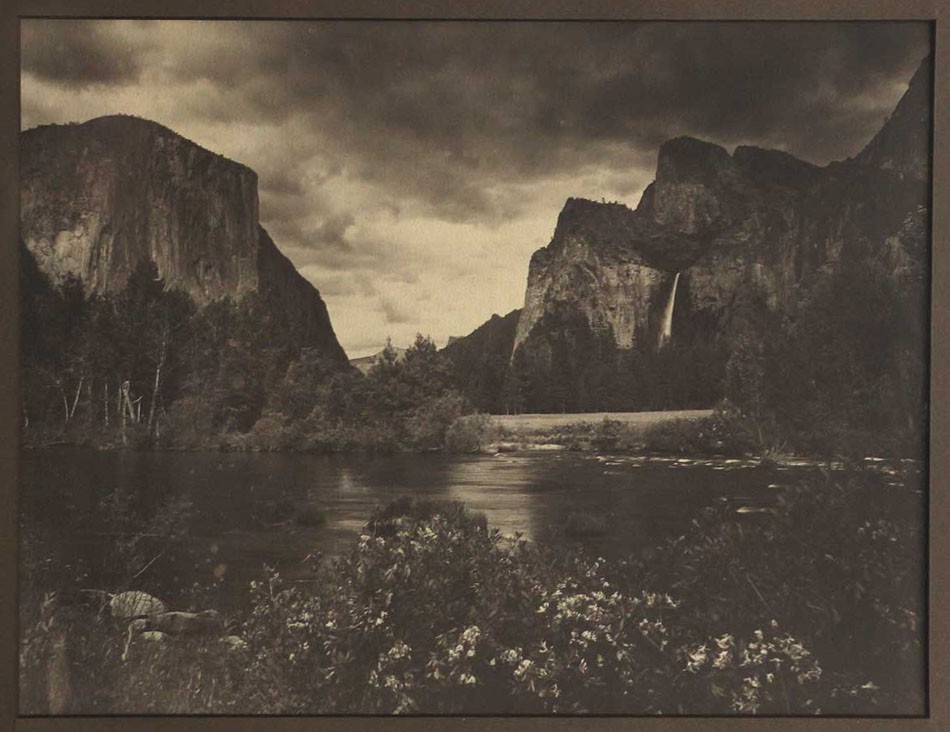 “The Gates of Yosemite”: Arthur C. Pillsbury, American: 1870-1946. Vintage bromide print c. 1915-20 (from original negative c. 1906-10) Image: 26.4 x 34.1 | 27.2 x 35.0 cm. Support: original framing: 37.9 x 45.8 hardboard primary mount | frame: stained hardwood: 40.7 x 48.5 x 1.5 cm. From the 1914 volume Yosemite and its High Sierra by John H. Williams, the following passage is reproduced along with this photograph “The Gates of Yosemite”: “Soon, quitting the narrow, cluttered wildness of the lower river, the newcomer is face to face with the ordered peace and glory of Yosemite itself. Gratefully, silently, he breathes the very magic of the Enchanted Valley. For here, fully spread before him, is that combination of sylvan charm with stupendous natural phenomena which makes Yosemite unique among Earth’s great pictures. He sees the cañon’s level floor, telling of an ancient glacial lake that has given place to wide, grassy meadows; fields of glad mountain flowers; forests of many greens and lavenders; the fascination of the winding Merced, and, gleaming high above this world of gentle loveliness, the amazing gray face of El Capitan, while Pohono drops from a ‘hanging valley’ superbly sculptured, and so beautiful that he may well deem it the noblest setting Nature has given to any of her famous waterfalls.” From: PhotoSeed Archive
“The Gates of Yosemite”: Arthur C. Pillsbury, American: 1870-1946. Vintage bromide print c. 1915-20 (from original negative c. 1906-10) Image: 26.4 x 34.1 | 27.2 x 35.0 cm. Support: original framing: 37.9 x 45.8 hardboard primary mount | frame: stained hardwood: 40.7 x 48.5 x 1.5 cm. From the 1914 volume Yosemite and its High Sierra by John H. Williams, the following passage is reproduced along with this photograph “The Gates of Yosemite”: “Soon, quitting the narrow, cluttered wildness of the lower river, the newcomer is face to face with the ordered peace and glory of Yosemite itself. Gratefully, silently, he breathes the very magic of the Enchanted Valley. For here, fully spread before him, is that combination of sylvan charm with stupendous natural phenomena which makes Yosemite unique among Earth’s great pictures. He sees the cañon’s level floor, telling of an ancient glacial lake that has given place to wide, grassy meadows; fields of glad mountain flowers; forests of many greens and lavenders; the fascination of the winding Merced, and, gleaming high above this world of gentle loveliness, the amazing gray face of El Capitan, while Pohono drops from a ‘hanging valley’ superbly sculptured, and so beautiful that he may well deem it the noblest setting Nature has given to any of her famous waterfalls.” From: PhotoSeed Archive
I am America
Posted June 2020 in Significant Photographers, Significant Photographs, Sports Photography
“I am America. I am the part you won’t recognize. But get used to me—black, confident, cocky; my name, not yours; my religion, not yours; my goals, my own. Get used to me.” ― Muhammad Ali
Remember his name: George Floyd
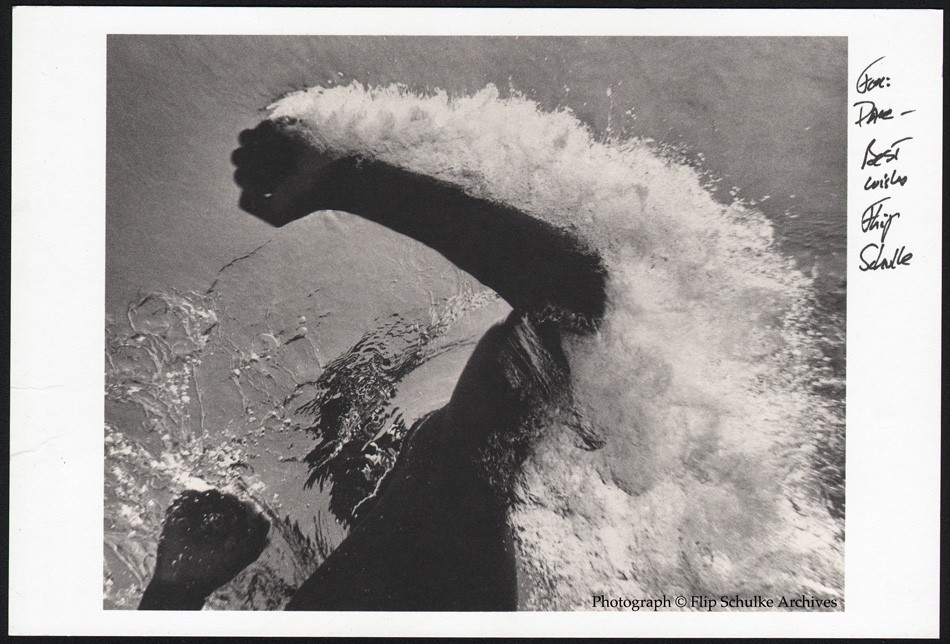 “Left Hook” (Muhammad Ali training underwater): Graeme Phelps "Flip" Schulke, American: 1930-2008: Fine Halftone ca. 1994 on manilla cardstock from original 1961 copy or source negative or print: 14.6 x 21.6 cm. (overall) Used here as a promotional gallery card for the New York City based James Danziger show: “Sport Stories: Sports photographs from 1900 to today”- February 18 - March 12, 1994. “Left Hook” was one of a series of photographs of boxer Muhammad Ali (then known as Cassius Clay) training underwater taken by American photojournalist Flip Schulke in the swimming pool of Miami’s Sir John Hotel in August, 1961. The photograph was first published of the then 19 year-old fighter in the September 8, 1961 weekly issue of Life magazine as part of a two-page spread titled “A Wet Way to Train for a Fight”. Schulke, an accomplished underwater photographer, donned Scuba gear and an underwater camera to make these photographs, learning three years later to his delight that Ali did not know how to swim at the time: “Boy, to con Life magazine! I never had an inkling that I had been taken. …To me, it shows his genius.” the photographer said for his volume “Muhammad Ali: the Birth of a Legend, Miami, 1961-1964” published in 2000. Photograph © Flip Schulke Archives. Gallery card from collection of PhotoSeed site owner signed by Schulke in 1999.
“Left Hook” (Muhammad Ali training underwater): Graeme Phelps "Flip" Schulke, American: 1930-2008: Fine Halftone ca. 1994 on manilla cardstock from original 1961 copy or source negative or print: 14.6 x 21.6 cm. (overall) Used here as a promotional gallery card for the New York City based James Danziger show: “Sport Stories: Sports photographs from 1900 to today”- February 18 - March 12, 1994. “Left Hook” was one of a series of photographs of boxer Muhammad Ali (then known as Cassius Clay) training underwater taken by American photojournalist Flip Schulke in the swimming pool of Miami’s Sir John Hotel in August, 1961. The photograph was first published of the then 19 year-old fighter in the September 8, 1961 weekly issue of Life magazine as part of a two-page spread titled “A Wet Way to Train for a Fight”. Schulke, an accomplished underwater photographer, donned Scuba gear and an underwater camera to make these photographs, learning three years later to his delight that Ali did not know how to swim at the time: “Boy, to con Life magazine! I never had an inkling that I had been taken. …To me, it shows his genius.” the photographer said for his volume “Muhammad Ali: the Birth of a Legend, Miami, 1961-1964” published in 2000. Photograph © Flip Schulke Archives. Gallery card from collection of PhotoSeed site owner signed by Schulke in 1999.
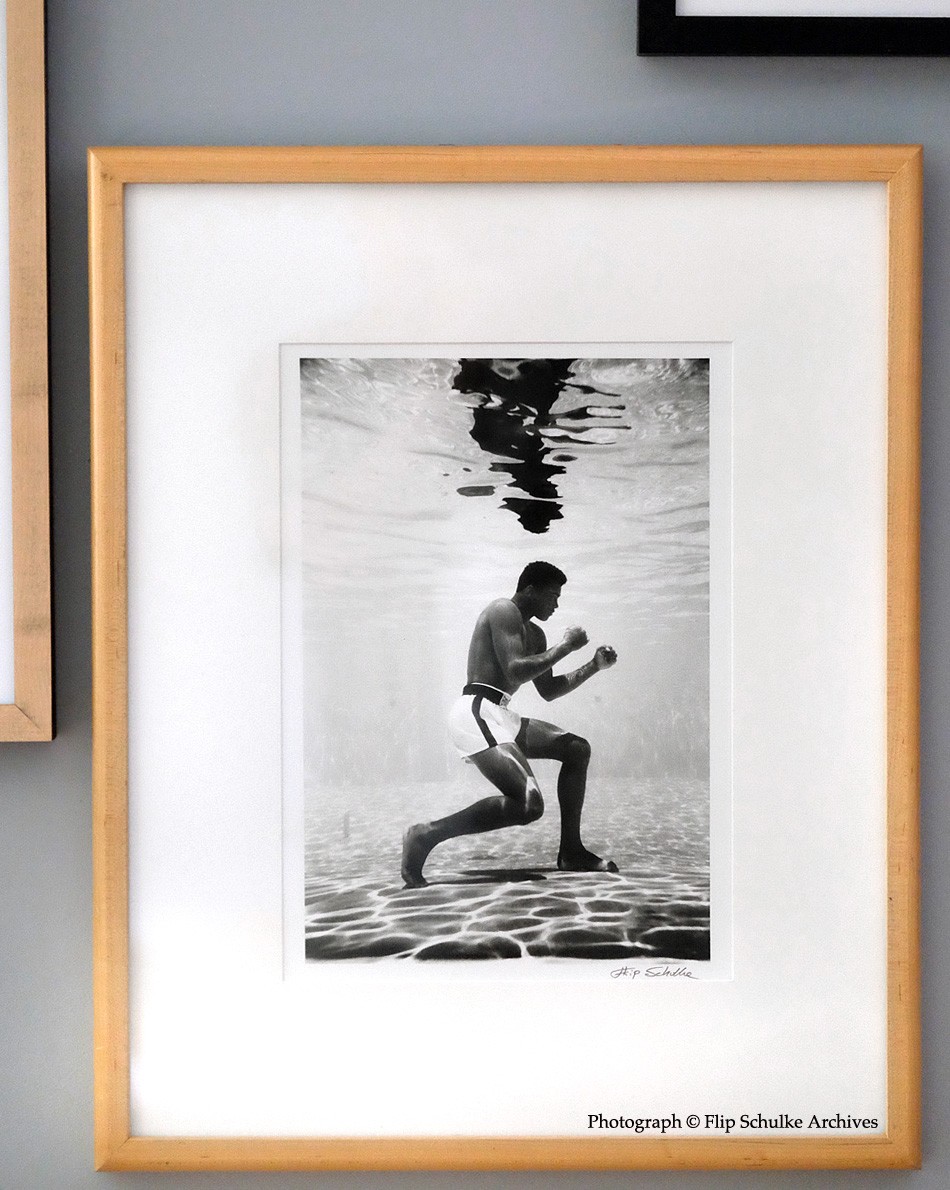 “Ali Underwater”: Graeme Phelps "Flip" Schulke, American: 1930-2008: Gelatin Silver print ca. 1999 from original 1961 source negative: 31.5 x 21.1 | 35.2 x 27.9 cm. Flip Schulke’s iconic photograph of boxer Muhammad Ali holding his breath while assuming a traditional boxing stance was one of a series of the world champion (then known as Cassius Clay) training underwater in the swimming pool of Miami’s Sir John Hotel in August, 1961. “For the picture of him standing on the bottom of the pool, he just sank down and stood on the bottom. It’s hard to do. I didn’t ask him to do it, I didn’t put any weights on him or anything. He exhaled all of his air-that’s the only way you can sink down.” the photographer said for his volume “Muhammad Ali: the Birth of a Legend, Miami, 1961-1964” published in 2000. Flip Schulke was a close friend of American Civil Rights icon Dr. Martin Luther King Jr. , and he spent more than a decade covering the movement for national magazines including Life, Time and Newsweek. These photographs were featured in three volumes by him: "Martin Luther King, Jr.: A Documentary, Montgomery to Memphis" (1976); "King Remembered" (1986); and "He Had A Dream" (1995). Other volumes by the photographer include "Underwater Photography for Everyone" (1979); "Your Future in Space: The U.S. Space Camp Training Program" (1986); "Muhammad Ali: the Birth of a Legend, Miami, 1961-1964" (2000); and "Witness to Our Times: My Life as a Photojournalist" (2003). Photograph © Flip Schulke Archives. Framed photograph from PhotoSeed Archive.
“Ali Underwater”: Graeme Phelps "Flip" Schulke, American: 1930-2008: Gelatin Silver print ca. 1999 from original 1961 source negative: 31.5 x 21.1 | 35.2 x 27.9 cm. Flip Schulke’s iconic photograph of boxer Muhammad Ali holding his breath while assuming a traditional boxing stance was one of a series of the world champion (then known as Cassius Clay) training underwater in the swimming pool of Miami’s Sir John Hotel in August, 1961. “For the picture of him standing on the bottom of the pool, he just sank down and stood on the bottom. It’s hard to do. I didn’t ask him to do it, I didn’t put any weights on him or anything. He exhaled all of his air-that’s the only way you can sink down.” the photographer said for his volume “Muhammad Ali: the Birth of a Legend, Miami, 1961-1964” published in 2000. Flip Schulke was a close friend of American Civil Rights icon Dr. Martin Luther King Jr. , and he spent more than a decade covering the movement for national magazines including Life, Time and Newsweek. These photographs were featured in three volumes by him: "Martin Luther King, Jr.: A Documentary, Montgomery to Memphis" (1976); "King Remembered" (1986); and "He Had A Dream" (1995). Other volumes by the photographer include "Underwater Photography for Everyone" (1979); "Your Future in Space: The U.S. Space Camp Training Program" (1986); "Muhammad Ali: the Birth of a Legend, Miami, 1961-1964" (2000); and "Witness to Our Times: My Life as a Photojournalist" (2003). Photograph © Flip Schulke Archives. Framed photograph from PhotoSeed Archive.American Love Story
Posted August 2019 in New Additions, Publishing, Significant Photographs
“And I never saw that love did any harm anywhere or was complained about O my brothers when you understood it:
For that’s about all life comes to anyhow—comes to the love we can put into it:
I just give you what I’ve got, dear comrades.” -Horace Traubel
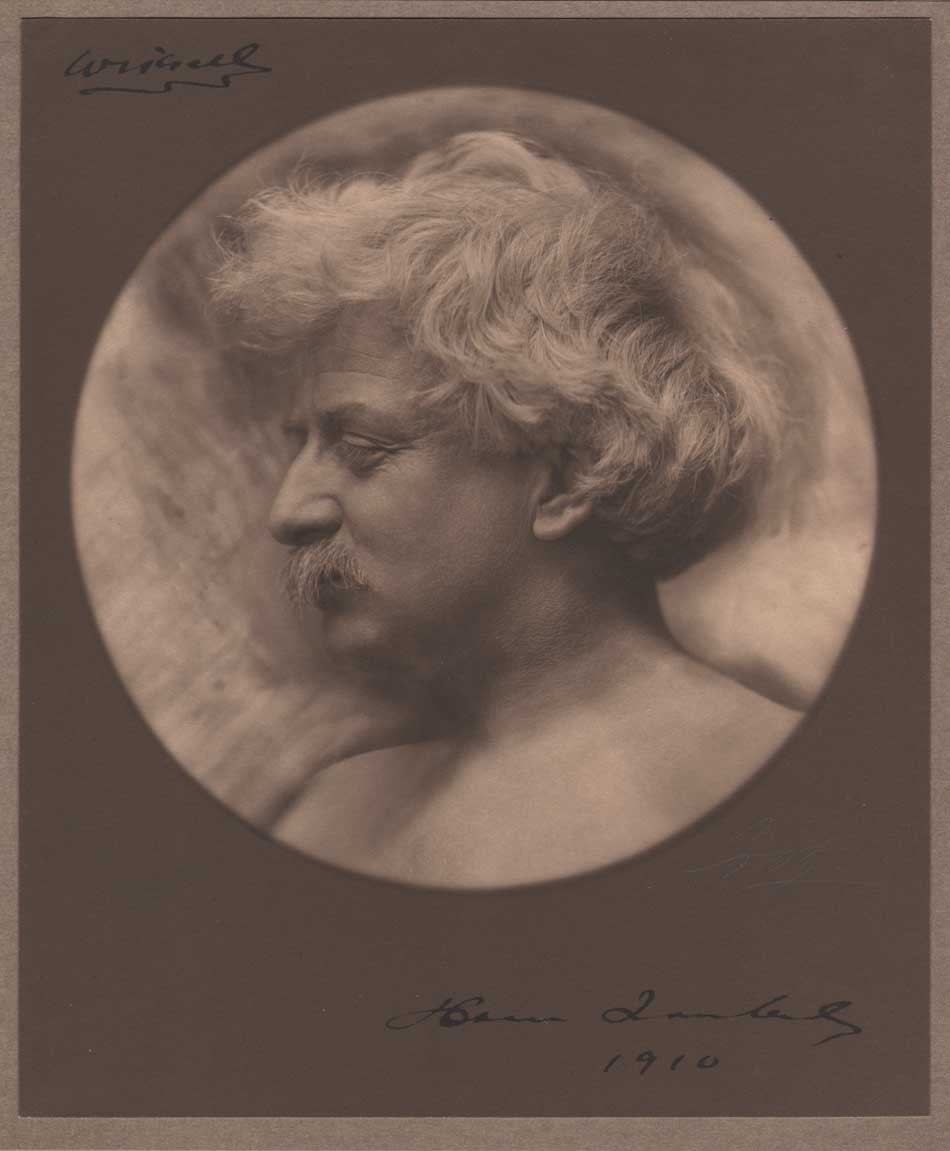 “Horace Traubel: Roundel Portrait” : Allen Drew Cook, American (1871-1923): 1910: mounted platinum print contained within folder: 17.4” roundel on paper 23.7 x 19.6 cm; supports: 24.8 x 20.6 | 28.4 x 23.9 cm. Folder: 29.4 x 48.8 cm. This print dedicated to Gustave Percival Wiksell (1863-1940): “Wiksell” in upper left corner of print recto; signed “Horace Traubel 1910” at lower right. Best remembered as the literary executor and biographer extraordinaire of America’s first national poet Walt Whitman, this uncommon profile portrait features the American editor and poet Horace Logo Traubel. (1858-1919) Traubel, a magazine publisher and committed socialist who held Whitman’s hand on his deathbed and earlier compiled nearly two million words over the the last four years in daily conversations with the poet, later transcribed and ultimately published what would become the nine volume opus: “With Walt Whitman in Camden”. From: PhotoSeed Archive
“Horace Traubel: Roundel Portrait” : Allen Drew Cook, American (1871-1923): 1910: mounted platinum print contained within folder: 17.4” roundel on paper 23.7 x 19.6 cm; supports: 24.8 x 20.6 | 28.4 x 23.9 cm. Folder: 29.4 x 48.8 cm. This print dedicated to Gustave Percival Wiksell (1863-1940): “Wiksell” in upper left corner of print recto; signed “Horace Traubel 1910” at lower right. Best remembered as the literary executor and biographer extraordinaire of America’s first national poet Walt Whitman, this uncommon profile portrait features the American editor and poet Horace Logo Traubel. (1858-1919) Traubel, a magazine publisher and committed socialist who held Whitman’s hand on his deathbed and earlier compiled nearly two million words over the the last four years in daily conversations with the poet, later transcribed and ultimately published what would become the nine volume opus: “With Walt Whitman in Camden”. From: PhotoSeed Archive
In this 200th anniversary year of American poet Walt Whitman’s birth, articles and exhibitions abound, celebrating the continuing relevance of America’s “Bard of Democracy”. But who was largely responsible for initially preserving, and thus memorializing for a larger audience this most important literary voice? A gentleman by the name of Horace Traubel. (1858-1919)
Three years ago I had the good fortune of purchasing a heraldic roundel portrait of Traubel, the one featured above taken by a fellow Philadelphian, pictorialist photographer Allen Drew Cook. (1871-1923)
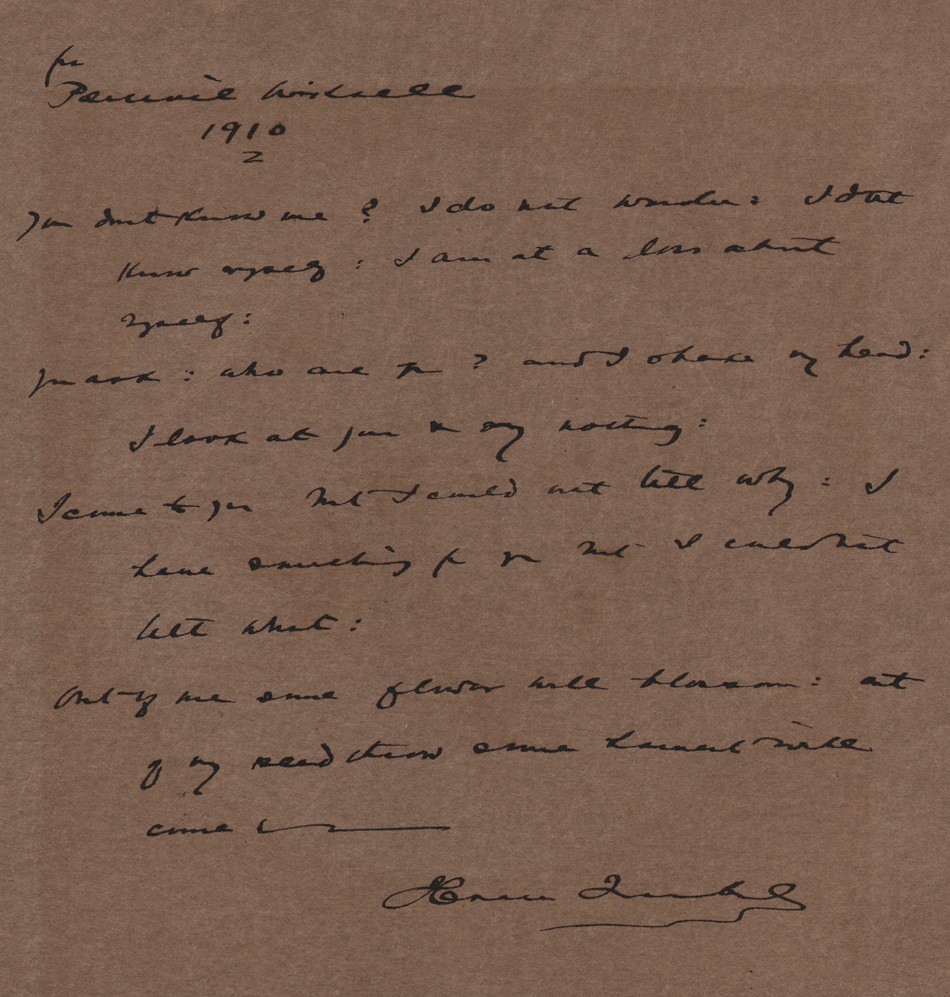 Lines addressed to Gustave Percival Wiksell (1863-1940) from the Horace Traubel poem “I Just Give You What I’ve Got” (from “Optimos”- 1910) in hand of author on inside front cover to folder containing photograph “Horace Traubel: Roundel Portrait”. Wiksell was a Boston dentist who served as president of the Walt Whitman Fellowship from 1903-1919. “You don't know me? I do not wonder: I dont know myself: I am at a loss about myself: You ask: who are you? and I shake my head : I look at you and say nothing: I come to you but I could not tell why: I have something for you but I could not tell what: Out of me some flower will blossom out of my seedthrow some harvest will come. - Horace Traubel”. Writing in the Mickle Street Review No. 16, (2004) U.S. scholar Michael Robertson’s article “The Gospel According To Horace: Horace Traubel And The Walt Whitman Fellowship” outlines Traubel’s and Wiksell’s relationship: “However, Traubel’s letters to Wiksell move beyond comradeship into physically explicit expressions of desire. “I dream of … the little bed in your paradise and the two arms of a brother that accept me in their divine partnership,”(114) Traubel wrote shortly before traveling to Boston. After his visit, he wrote longingly, “I sit here and write you a letter. It is not a pen that is writing. It is the lips that you have kissed. It is the body that you have traversed over and over with your consecrating palm. Do you not feel that body? Do you not feel the return?”(115) These and other letters leave little doubt that the two men had a sexual love affair, an affair that seems to have been remarkably guilt-free. Wiksell’s letters to Traubel refer to his own wife and child and mix heavy-breathing passion with cheery greetings to “Annie and Gertrude,”(116) Traubel’s wife and daughter.”(114-“I dream of”: Traubel to Wiksell, 3 Jan. 1904, WC.; 115-“I sit here”: Traubel to Wiksell, 12 May 1904, WC.; 116-“Annie and Gertrude”: Wiksell to Traubel, 30 Dec. 1901, TC.) From: PhotoSeed Archive
Lines addressed to Gustave Percival Wiksell (1863-1940) from the Horace Traubel poem “I Just Give You What I’ve Got” (from “Optimos”- 1910) in hand of author on inside front cover to folder containing photograph “Horace Traubel: Roundel Portrait”. Wiksell was a Boston dentist who served as president of the Walt Whitman Fellowship from 1903-1919. “You don't know me? I do not wonder: I dont know myself: I am at a loss about myself: You ask: who are you? and I shake my head : I look at you and say nothing: I come to you but I could not tell why: I have something for you but I could not tell what: Out of me some flower will blossom out of my seedthrow some harvest will come. - Horace Traubel”. Writing in the Mickle Street Review No. 16, (2004) U.S. scholar Michael Robertson’s article “The Gospel According To Horace: Horace Traubel And The Walt Whitman Fellowship” outlines Traubel’s and Wiksell’s relationship: “However, Traubel’s letters to Wiksell move beyond comradeship into physically explicit expressions of desire. “I dream of … the little bed in your paradise and the two arms of a brother that accept me in their divine partnership,”(114) Traubel wrote shortly before traveling to Boston. After his visit, he wrote longingly, “I sit here and write you a letter. It is not a pen that is writing. It is the lips that you have kissed. It is the body that you have traversed over and over with your consecrating palm. Do you not feel that body? Do you not feel the return?”(115) These and other letters leave little doubt that the two men had a sexual love affair, an affair that seems to have been remarkably guilt-free. Wiksell’s letters to Traubel refer to his own wife and child and mix heavy-breathing passion with cheery greetings to “Annie and Gertrude,”(116) Traubel’s wife and daughter.”(114-“I dream of”: Traubel to Wiksell, 3 Jan. 1904, WC.; 115-“I sit here”: Traubel to Wiksell, 12 May 1904, WC.; 116-“Annie and Gertrude”: Wiksell to Traubel, 30 Dec. 1901, TC.) From: PhotoSeed Archive
Best remembered as the literary executor and biographer extraordinaire of Walt Whitman, Horace Traubel was also a magazine publisher and committed socialist who held the poet’s hand on his deathbed and compiled nearly two million words over the last four years in daily conversations with him, later transcribing and publishing in his lifetime the first three volumes of what would become his nine volume opus: With Walt Whitman in Camden. (completed 1996)
Unlike Whitman, whom The Guardian newspaper notes in an article published this year “was also the 19th century’s most photographed American writer”, (1.) there are only a smattering of photographs featuring Traubel-most being credited to Cook. By and large, Horace Traubel is a figure in American letters most people have never heard of.
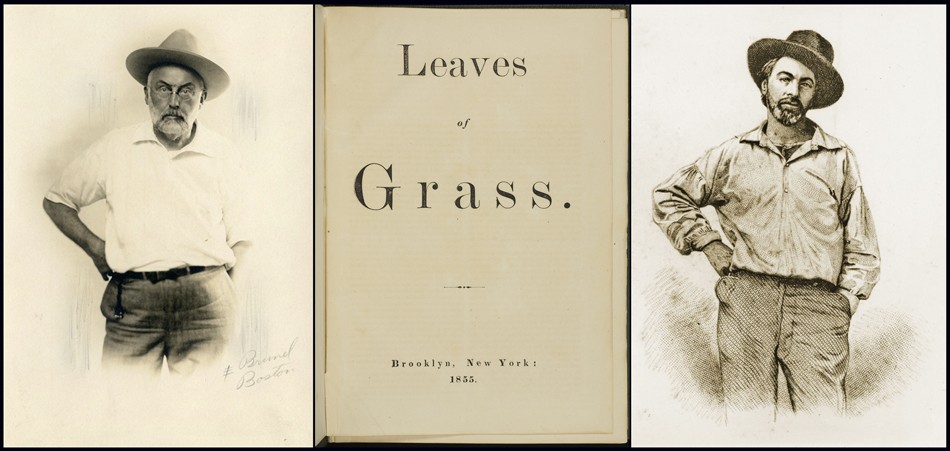 Left: “Gustave Percival Wiksell as Walt Whitman”: Undated gelatin-silver print by Emile Brunel Studio, Boston, ca. 1915-25?: Wearing similar clothing, Wiksell strikes a pose similar to one Whitman made from a lost daguerreotype by Gabriel Harrison later made into a steel engraving by Samuel Hollyer. Boston dentist Gustave Percival Wiksell was an ardent devotee to Walt Whitman and president of the Whitman Fellowship from 1903-19. Photograph © All rights reserved by tackyspoons/flickr. Middle: 1855 first edition title page to Leaves of Grass, Brooklyn, New York. Courtesy The Lilly Library, Indiana University. Right: Original Samuel Hollyer steel engraving of frontispiece portrait of Walt Whitman used for the 1855 and 1856 editions of Leaves of Grass.,Gabriel Harrison’s original 1854 daguerreotype showed the 35-year-old Whitman wearing laborer’s clothing. The Whitman Archive provides the following description of the original sitting: “Of the day the original daguerreotype was taken, Whitman remembered, "I was sauntering along the street: the day was hot: I was dressed just as you see me there. A friend of mine—”Gabriel Harrison (you know him? ah! yes!—”he has always been a good friend!)—”stood at the door of his place looking at the passers-by. He cried out to me at once: 'Old man!—”old man!—”come here: come right up stairs with me this minute'—”and when he noticed that I hesitated cried still more emphatically: 'Do come: come: I'm dying for something to do.' This picture was the result." Engraving courtesy Bayley Collection: Ohio Wesleyan via Walt Whitman Archive.
Left: “Gustave Percival Wiksell as Walt Whitman”: Undated gelatin-silver print by Emile Brunel Studio, Boston, ca. 1915-25?: Wearing similar clothing, Wiksell strikes a pose similar to one Whitman made from a lost daguerreotype by Gabriel Harrison later made into a steel engraving by Samuel Hollyer. Boston dentist Gustave Percival Wiksell was an ardent devotee to Walt Whitman and president of the Whitman Fellowship from 1903-19. Photograph © All rights reserved by tackyspoons/flickr. Middle: 1855 first edition title page to Leaves of Grass, Brooklyn, New York. Courtesy The Lilly Library, Indiana University. Right: Original Samuel Hollyer steel engraving of frontispiece portrait of Walt Whitman used for the 1855 and 1856 editions of Leaves of Grass.,Gabriel Harrison’s original 1854 daguerreotype showed the 35-year-old Whitman wearing laborer’s clothing. The Whitman Archive provides the following description of the original sitting: “Of the day the original daguerreotype was taken, Whitman remembered, "I was sauntering along the street: the day was hot: I was dressed just as you see me there. A friend of mine—”Gabriel Harrison (you know him? ah! yes!—”he has always been a good friend!)—”stood at the door of his place looking at the passers-by. He cried out to me at once: 'Old man!—”old man!—”come here: come right up stairs with me this minute'—”and when he noticed that I hesitated cried still more emphatically: 'Do come: come: I'm dying for something to do.' This picture was the result." Engraving courtesy Bayley Collection: Ohio Wesleyan via Walt Whitman Archive.
But concerning the roundel portrait of Traubel, what a difference between it and the staid portraits published during his lifetime! The seller described it thus: “Vintage Risque Photo Handsome Shirtless Man w/ Love Poem c. 1910 Gay Interest”. If you are a collector like me, the proverbial eye roll is something experienced practically every day in the course of searches for new treasure. To wit: if it’s a photo depicting two men together- or for that matter, two women- a seller might add the descriptor of “Gay Interest” to the listing. This is laughable on the face of it, as to my mind there is often a complete disconnect between reality often taking over the minds of sellers intent on rewriting photographic evidence for the sole purpose of making a quick buck.
But not always. Fortunately for me, and unbeknownst to the seller, I had a hunch who the sitter of this portrait was. My offer accepted, I only later determined “gay interest” was only the tip of the iceberg.
After some sleuthing, I discovered this portrait had seemingly been published only one time in 1919: as the dust-jacket illustration to a limited-edition posthumous work on Traubel written by his biographer David Karsner, a close friend who describes him as part Karl Marx and Jesus of Nazareth, and “in possession of a point of view which issues a labor-conscious ‘warning and challenge.” (2.)
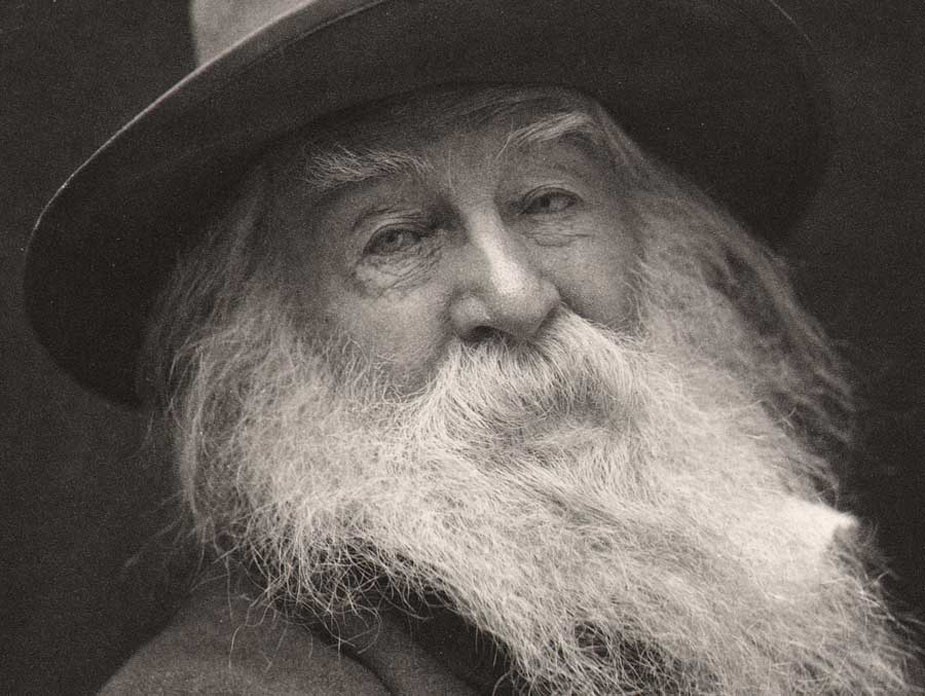 Detail: 1887: Walt Whitman-1819-1892 by George C. Cox: (portrait known as the "Laughing Philosopher") 23.9 x 18.8 cm | 45.2 x 33.3 cm: vintage large format, hand-pulled photogravure printed circa 1905-10 by the Photographische Gesellschaft in Berlin on Van Gelder Zonen plate paper. From: PhotoSeed Archive
Detail: 1887: Walt Whitman-1819-1892 by George C. Cox: (portrait known as the "Laughing Philosopher") 23.9 x 18.8 cm | 45.2 x 33.3 cm: vintage large format, hand-pulled photogravure printed circa 1905-10 by the Photographische Gesellschaft in Berlin on Van Gelder Zonen plate paper. From: PhotoSeed Archive
But unlike the aforementioned staid portraits, which always show him wearing a shirt or jacket- this profile view was unusual for the time in which it was made- 1910-bare-shouldered, and thus sans shirt. When I finally made out the signature of the person this particular print was dedicated to-personally inscribed by the sitter on the print surface recto to someone named “Wiksell” in the upper left corner, it all came together. For on the inside cover of the folder in which this portrait appears (when purchased it was framed) Traubel has inscribed several lines- a love poem, if you will, confirming the sellers hunch, “For Percival Wiksell- 1910” :
You don’t know me? I do not wonder: I dont know myself: I am at a loss about myself:
You ask: who are you? and I shake my head : I look at you and say nothing:
I come to you but I could not tell why: I have something for you but I could not tell what:
Out of me some flower will blossom out of my seedthrow some harvest will come. - Horace Traubel
(From Optimos: “I Just Give You What I’ve Got”- 1910)
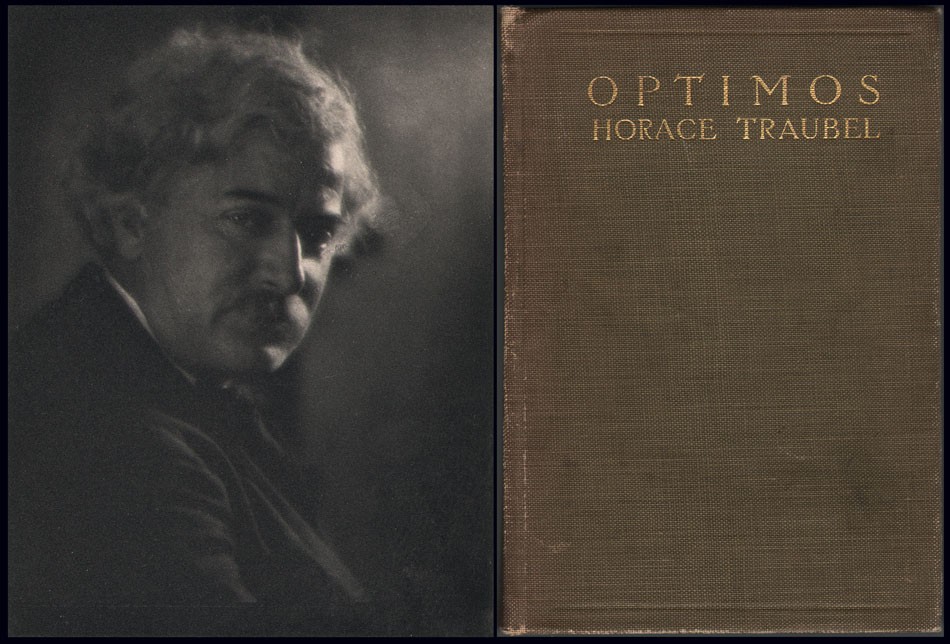 Left: “Frontispiece Portrait of Horace Traubel” (1909) from the book of poetry “Optimos”: Clarence H. White, American: 1910: photogravure: 11.4 x 8.7 | 18.7 x 12.5 cm. From scholar Anne McCauley’s 2017 volume “Clarence H. White and His World: the Art and Craft of Photography, 1895-1925 we learn” : “Reynold’s (Stephen Marion Reynolds (1854-1930) a lawyer who joined the Social Democratic Party in 1900-ed) and Traubel’s recognition of photography as a powerful tool in the class struggle, whether in the form of the dissemination of the fine arts or as a creative means of personal expression if transformed by hand manipulation, caused them to appreciate White’s skills as well as his openness to their political opinions.” (p. 178) Right: Front Cover of “Optimos”, the best-known volume of poetry by Horace Traubel: New York: 1910: B.W. Huebsch (8vo | olive green cloth) From the Walt Whitman Archive online resource, “His own books can be read as socialist refigurings of Whitman's work, each of his titles subtly adjusting Whitman's terminology: …Optimos (1910) redefined Whitman's "kosmos" as an optimized "cheerful whole" (qtd. in Bain 39). And although some in his day declared Traubel as a poet to be Whitman’s successor, there were plenty of critics. Writing in the pages of The Smart Set for July, 1911 under the heading “Novels for Hot Afternoons”, American critic H.L. Mencken, said of “Optimos”: “Horace Traubel fills the three hundred and more pages of his "optimos" (Huebsch) with dishwatery imitations of Walt Whitman, around whom Horace, in Walt's Camden days, revolved as an humble satellite. All of the faults of the master appear in the disciple. There is the same maudlin affection for the hewer of wood and drawer of water, the same frenzy for repeating banal ideas ad nauseam, the same inability to distinguish between a poem and a stump speech. Old Walt, for all his absurdities, was yet a poet at heart. Whenever he ceased, even for a brief moment, to emit his ethical and sociological rubbish, a strange beauty crept into his lines and his own deep emotion glorified them. But not so with Horace. His strophes have little more poetry in them than so many college yells, and the philosophy they voice is almost as bad as the English in which they are written.” From: PhotoSeed Archive
Left: “Frontispiece Portrait of Horace Traubel” (1909) from the book of poetry “Optimos”: Clarence H. White, American: 1910: photogravure: 11.4 x 8.7 | 18.7 x 12.5 cm. From scholar Anne McCauley’s 2017 volume “Clarence H. White and His World: the Art and Craft of Photography, 1895-1925 we learn” : “Reynold’s (Stephen Marion Reynolds (1854-1930) a lawyer who joined the Social Democratic Party in 1900-ed) and Traubel’s recognition of photography as a powerful tool in the class struggle, whether in the form of the dissemination of the fine arts or as a creative means of personal expression if transformed by hand manipulation, caused them to appreciate White’s skills as well as his openness to their political opinions.” (p. 178) Right: Front Cover of “Optimos”, the best-known volume of poetry by Horace Traubel: New York: 1910: B.W. Huebsch (8vo | olive green cloth) From the Walt Whitman Archive online resource, “His own books can be read as socialist refigurings of Whitman's work, each of his titles subtly adjusting Whitman's terminology: …Optimos (1910) redefined Whitman's "kosmos" as an optimized "cheerful whole" (qtd. in Bain 39). And although some in his day declared Traubel as a poet to be Whitman’s successor, there were plenty of critics. Writing in the pages of The Smart Set for July, 1911 under the heading “Novels for Hot Afternoons”, American critic H.L. Mencken, said of “Optimos”: “Horace Traubel fills the three hundred and more pages of his "optimos" (Huebsch) with dishwatery imitations of Walt Whitman, around whom Horace, in Walt's Camden days, revolved as an humble satellite. All of the faults of the master appear in the disciple. There is the same maudlin affection for the hewer of wood and drawer of water, the same frenzy for repeating banal ideas ad nauseam, the same inability to distinguish between a poem and a stump speech. Old Walt, for all his absurdities, was yet a poet at heart. Whenever he ceased, even for a brief moment, to emit his ethical and sociological rubbish, a strange beauty crept into his lines and his own deep emotion glorified them. But not so with Horace. His strophes have little more poetry in them than so many college yells, and the philosophy they voice is almost as bad as the English in which they are written.” From: PhotoSeed Archive
The recipient, Gustave Percival Wiksell, (1863-1940) was a Boston dentist who served as president of the Walt Whitman Fellowship from 1903-1919. So devoted was this disciple to the master that he went to the length of replicating the now famous pose Whitman took from a now lost 1854 daguerreotype by Gabriel Harrison made into an engraving and used as the frontispiece illustration for the 1855 & 1856 editions of Whitman’s masterpiece Leaves of Grass.
Wiksell’s papers are now in the Library of Congress in Washington and he was known to have eulogized Horace Traubell at his funeral in 1919. More than one Traubel scholar lays out the evidence that Wiksell and he were more than good friends, but I will leave that for your own further inquiries. (further attribution can be found in a cutline with this post)
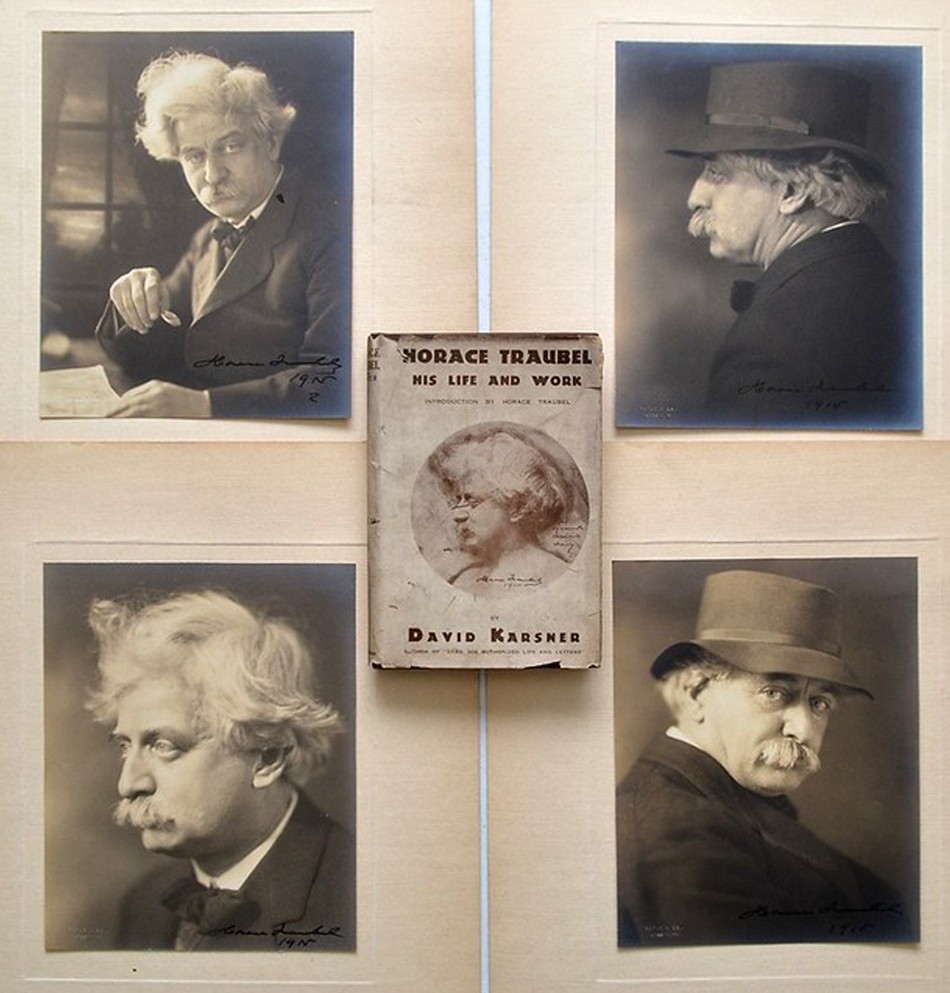 “Ca. 1915 signed and mounted portraits of Horace Traubel” (unknown photographer) surrounding at center: “Horace Traubel: His Life And Work” by David Karsner (New York: Egmont Arens, 1919) with elusive dust-jacket reproducing bare-shouldered 1910 portrait “Horace Traubel: Roundel Portrait”. Commentary on Traubel by Karsner appeared in the online resource Poetrybay in the Fall of 2009: “On the other hand David Karsner, Traubel's biographer… called him “a poet and prophet of the new democracy.” Traubel, suggests Karsner, is part Karl Marx and part Jesus of Nazareth, and in possession of a point of view which issues a labor-conscious ‘warning and challenge.” From Wikipedia: David Fulton "Dave" Karsner (1889–1941) was an American journalist, writer, and socialist political activist. Karsner is best remembered as a key member of the editorial staff of the New York Call and as an early biographer of Socialist Party of America leader Eugene V. Debs. Photographic grouping courtesy The Library of William F. Gable Auction: Savo Auctioneers, Archbald, PA: January 3, 2015.
“Ca. 1915 signed and mounted portraits of Horace Traubel” (unknown photographer) surrounding at center: “Horace Traubel: His Life And Work” by David Karsner (New York: Egmont Arens, 1919) with elusive dust-jacket reproducing bare-shouldered 1910 portrait “Horace Traubel: Roundel Portrait”. Commentary on Traubel by Karsner appeared in the online resource Poetrybay in the Fall of 2009: “On the other hand David Karsner, Traubel's biographer… called him “a poet and prophet of the new democracy.” Traubel, suggests Karsner, is part Karl Marx and part Jesus of Nazareth, and in possession of a point of view which issues a labor-conscious ‘warning and challenge.” From Wikipedia: David Fulton "Dave" Karsner (1889–1941) was an American journalist, writer, and socialist political activist. Karsner is best remembered as a key member of the editorial staff of the New York Call and as an early biographer of Socialist Party of America leader Eugene V. Debs. Photographic grouping courtesy The Library of William F. Gable Auction: Savo Auctioneers, Archbald, PA: January 3, 2015.
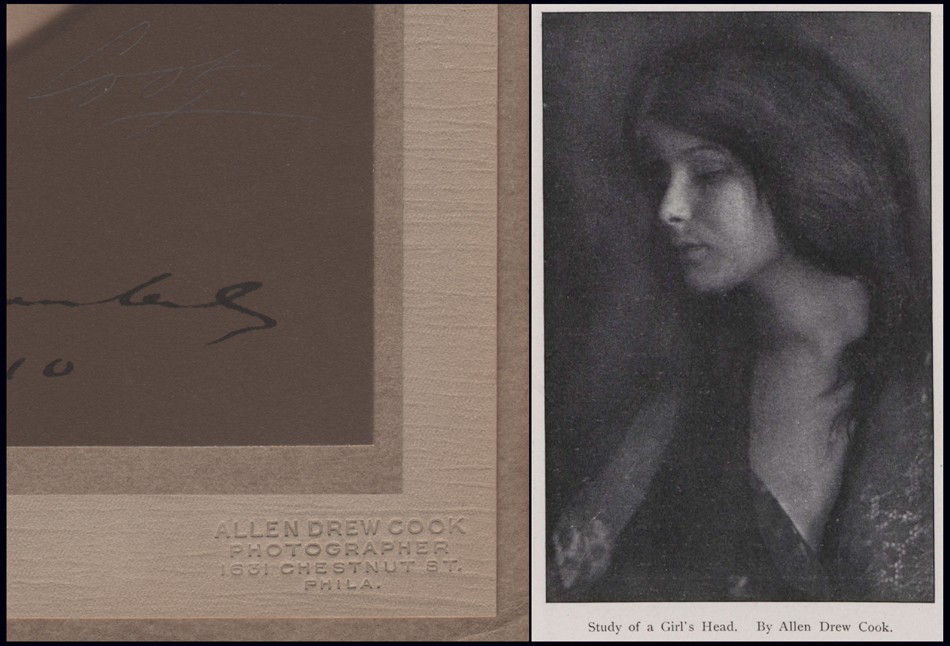 Left: Detail showing blind-stamp for photographer Allen Drew Cook on secondary mount to photograph “Horace Traubel: Roundel Portrait”: Allen Drew Cook, American (1871-1923): 1910: mounted platinum print contained within folder: 17.4” roundel on paper 23.7 x 19.6 cm; supports: 24.8 x 20.6 | 28.4 x 23.9 cm. In upper left of detail is seen graphite signature: “Cook”, underlined outside lower margin of roundel; the blind-stamp additionally lists his address as 1631 Chestnut St. in Philadelphia- the same as for the offices of the The Conservator, a monthly literary magazine edited and published by Horace Traubel beginning in October, 1910. (the magazine, which was started in 1890, previously lists its’ address as 1624 Walnut St. in Philadelphia.) Beginning In 1915 and running into 1916, an advertisement for “Photographic Portraits” by Allen Drew Cook of Eugene Debs, Clarence Darrow, J. William Lloyd and Traubel appeared on the back page of The Conservator. From: PhotoSeed Archive. Right: “Study of a Girl’s Head”, from around 1900, is an early example of a pictorialist photographic portrait entered by Cook in the Third Annual Philadelphia Photographic Salon and reproduced as a halftone in the Salon’s 1900 catalogue. Courtesy: Thomas J. Watson Library Digital Collections - The Metropolitan Museum of Art, New York.
Left: Detail showing blind-stamp for photographer Allen Drew Cook on secondary mount to photograph “Horace Traubel: Roundel Portrait”: Allen Drew Cook, American (1871-1923): 1910: mounted platinum print contained within folder: 17.4” roundel on paper 23.7 x 19.6 cm; supports: 24.8 x 20.6 | 28.4 x 23.9 cm. In upper left of detail is seen graphite signature: “Cook”, underlined outside lower margin of roundel; the blind-stamp additionally lists his address as 1631 Chestnut St. in Philadelphia- the same as for the offices of the The Conservator, a monthly literary magazine edited and published by Horace Traubel beginning in October, 1910. (the magazine, which was started in 1890, previously lists its’ address as 1624 Walnut St. in Philadelphia.) Beginning In 1915 and running into 1916, an advertisement for “Photographic Portraits” by Allen Drew Cook of Eugene Debs, Clarence Darrow, J. William Lloyd and Traubel appeared on the back page of The Conservator. From: PhotoSeed Archive. Right: “Study of a Girl’s Head”, from around 1900, is an early example of a pictorialist photographic portrait entered by Cook in the Third Annual Philadelphia Photographic Salon and reproduced as a halftone in the Salon’s 1900 catalogue. Courtesy: Thomas J. Watson Library Digital Collections - The Metropolitan Museum of Art, New York.
Five years ago on July 4th, America’s birthday, I published a post featuring several vintage likenesses of Walt Whitman- “Oh Say Can you See?” and his importance to capturing the enduring spirit of our country. In this, Traubel certainly will never be magically rediscovered as the good gray poet’s literary successor (none other than H.L. Mencken derided his poetry as “dishwatery imitations of Walt Whitman, around whom Horace, in Walt’s Camden days, revolved as an humble satellite.”) (3.) But his ideals as one spreading love as written in the lines at the top of this post-a socialist ideal in the vein of Whitman- are surely honorable and needed in the fractured American present. Instead of cleaved partisan camps and tribes seemingly taking over our national conversation, how about a bit more love comrades? Socialism has nothing to do with that last word, by the way. Instead, let’s celebrate the ideals of our national melting pot, and give all her citizenry power to the truth of her motto: “E Pluribus Unum” - Out of Many, One.
Just what Horace would have wanted.
Notes:
1. Excerpt: The Guardian (online): Julianne McShane: “Walt Whitman: celebrating an extraordinary life in his bicentennial”: June 12, 2019. One hundred thirty photographic portraits of Walt Whitman have been identified to date.
2. Excerpt: Online resource Poetrybay: Fall, 2009: commentary on Traubel by Karsner.
3. Excerpt: Review: “Optimos” : “Novels for Hot Afternoons”: H.L. Mencken: The Smart Set: July, 1911.
Summer Streams Wide & Small
Posted June 2019 in Alternate Processes, Childhood Photography, Color Photography, Documentary Photography, Journals, New Additions, Painters|Photographers, Scientific Photography, Significant Photographers, Significant Photographs, Unknown Photographers
Herein a summer interlude, if you will, of still, trickling and gushing streams from years past. And if they inspire and beckon for the present, find your own peace or wonderment in the mountains, valleys or pastures of summer wherever your own stream flows.
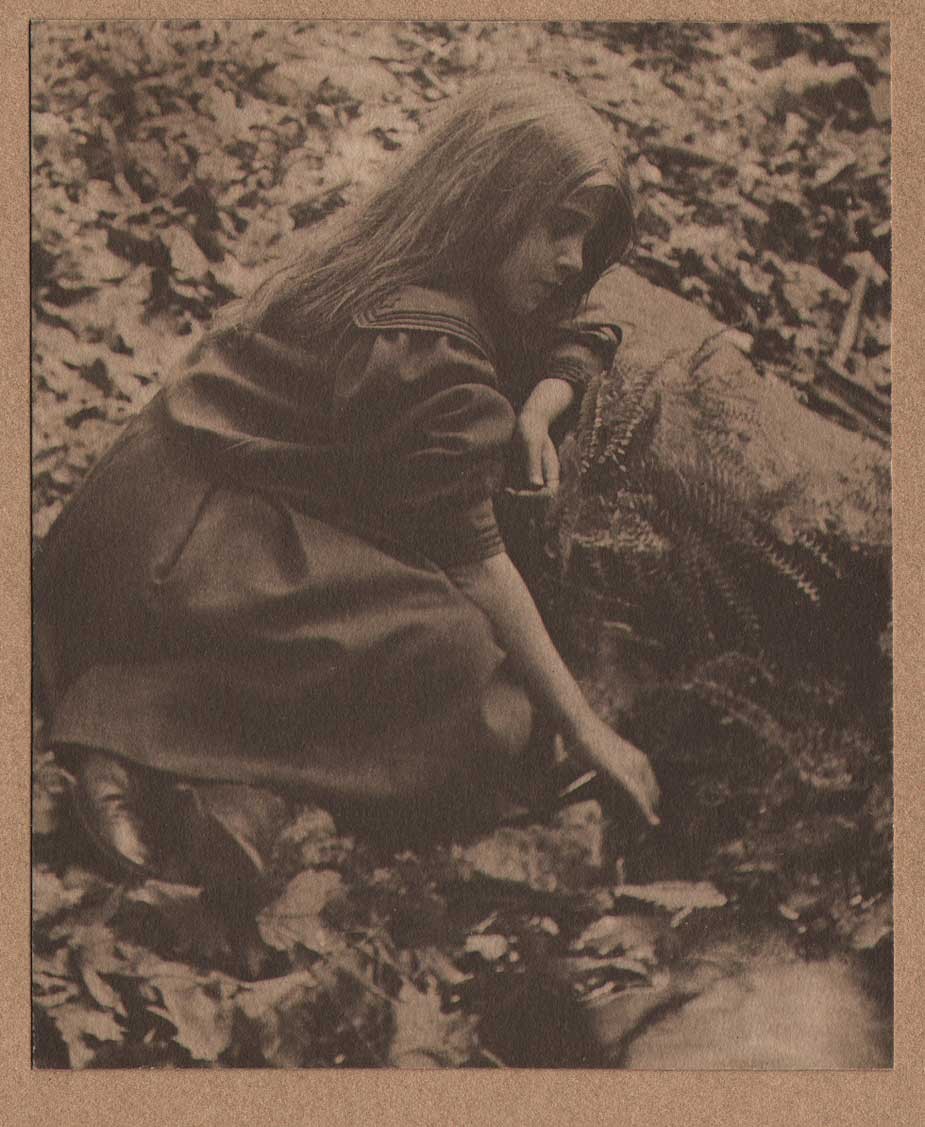 “Dorothy Tucker Gathering Ferns”: Charles Rollins Tucker, American (b. 1868): ca. 1910: mounted brown-toned platinum print: 9.4 x 7.7 cm | 31.2 x 16.0 cm. Born in August, 1899, Dorothy Tucker, a constant photographic subject for her father, then a high school physics teacher at Curtis High School on Staten Island, New York state, holds a spray of freshly-picked ferns while investigating the edge of a stream in the woods. From: PhotoSeed Archive
“Dorothy Tucker Gathering Ferns”: Charles Rollins Tucker, American (b. 1868): ca. 1910: mounted brown-toned platinum print: 9.4 x 7.7 cm | 31.2 x 16.0 cm. Born in August, 1899, Dorothy Tucker, a constant photographic subject for her father, then a high school physics teacher at Curtis High School on Staten Island, New York state, holds a spray of freshly-picked ferns while investigating the edge of a stream in the woods. From: PhotoSeed Archive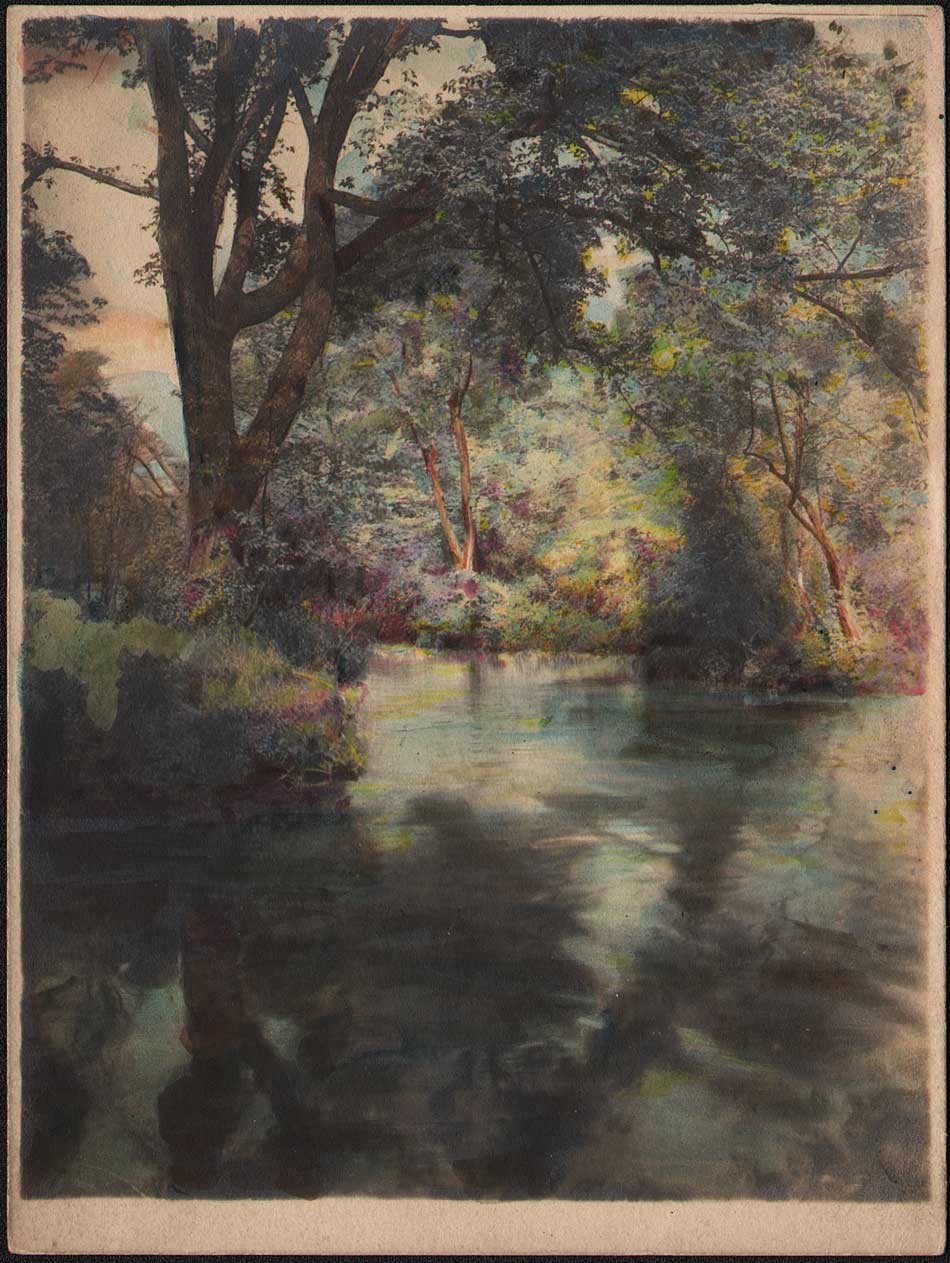 “Stream or Pond at Prospect Park"(Brooklyn, New York): ca. 1910-20: Unknown Brooklyn photographer: hand-colored gelatin silver print: 11.7 x 8.9 cm | 12.4 x 9.3 cm: From: PhotoSeed Archive
“Stream or Pond at Prospect Park"(Brooklyn, New York): ca. 1910-20: Unknown Brooklyn photographer: hand-colored gelatin silver print: 11.7 x 8.9 cm | 12.4 x 9.3 cm: From: PhotoSeed Archive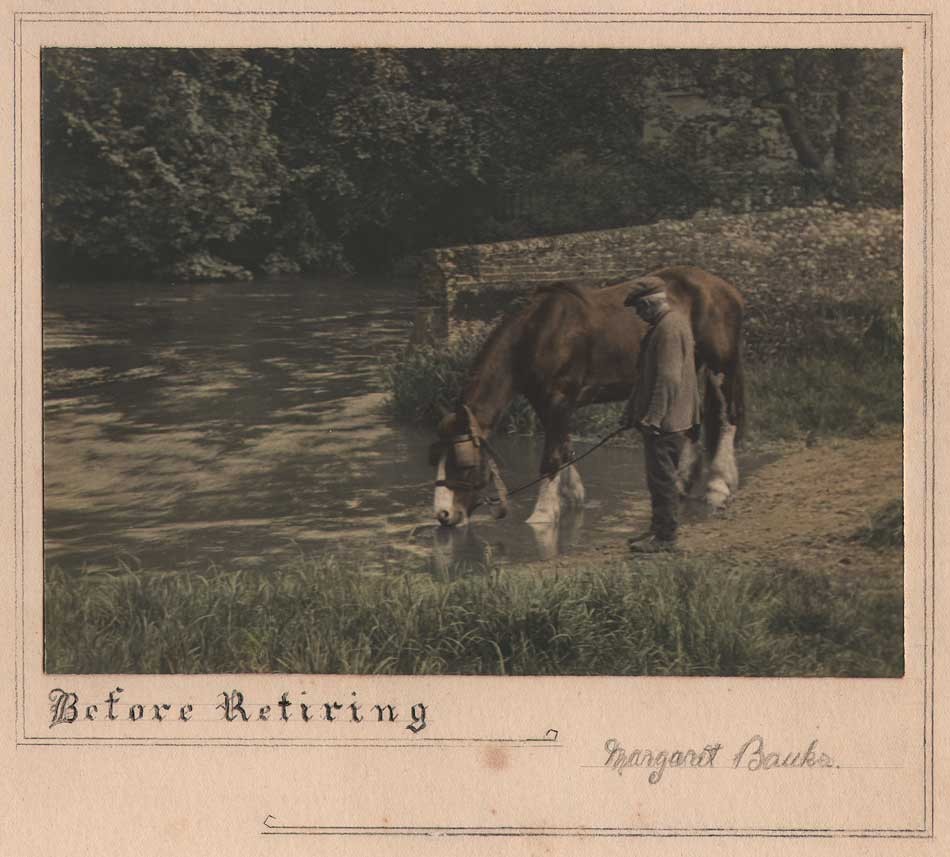 “Before Retiring”: ca. 1910-20: Margaret Bauks, British- (possibly Margaret Florence Bauks: b. 1872?) : hand-colored gelatin silver print: 11.6 x 15.9 cm | 27.8 x 22.8 cm: From: PhotoSeed Archive
“Before Retiring”: ca. 1910-20: Margaret Bauks, British- (possibly Margaret Florence Bauks: b. 1872?) : hand-colored gelatin silver print: 11.6 x 15.9 cm | 27.8 x 22.8 cm: From: PhotoSeed Archive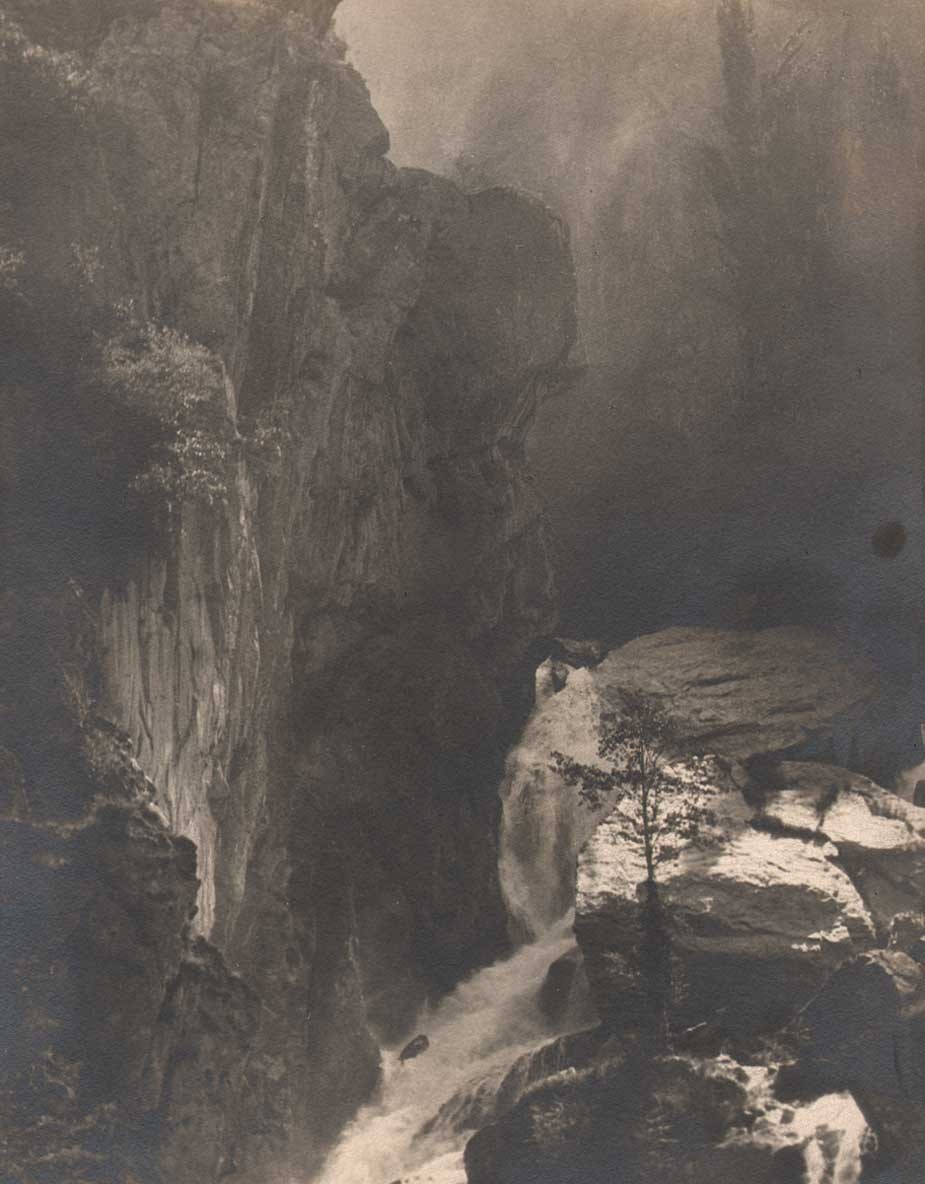 “A Stream of Savoy”: ca. 1927: this print exhibited 1935: Frank Roy Fraprie, American (1874-1951): vintage Bromide print: 24.0 x 18.6 cm | 30.5 x 25.4 cm: As noted in the 1946 American Annual of Photography, (p. 170) Fraprie had been taking photographs in June of 1926 in Eastern France. The area, located in the Haute-Savoie, or Upper Savoy, is a mountainous region of spectacular beauty which includes Lake Annecy, one of France’s largest freshwater lakes. Photographic historian Christian Peterson’s biography of Fraprie gives some background on this important photographer and editor: “Fraprie was the most influential author/publisher of American pictorial photography during the period following the Photo-Secession. From the 1910s to the 1940s, he wrote books and countless articles on all aspects of pictorialism. He edited photographic monthlies and annuals for nearly the entire first half of the twentieth century. In addition, he created his own highly successful pictorial photographs and exhibited them extensively.” From: PhotoSeed Archive
“A Stream of Savoy”: ca. 1927: this print exhibited 1935: Frank Roy Fraprie, American (1874-1951): vintage Bromide print: 24.0 x 18.6 cm | 30.5 x 25.4 cm: As noted in the 1946 American Annual of Photography, (p. 170) Fraprie had been taking photographs in June of 1926 in Eastern France. The area, located in the Haute-Savoie, or Upper Savoy, is a mountainous region of spectacular beauty which includes Lake Annecy, one of France’s largest freshwater lakes. Photographic historian Christian Peterson’s biography of Fraprie gives some background on this important photographer and editor: “Fraprie was the most influential author/publisher of American pictorial photography during the period following the Photo-Secession. From the 1910s to the 1940s, he wrote books and countless articles on all aspects of pictorialism. He edited photographic monthlies and annuals for nearly the entire first half of the twentieth century. In addition, he created his own highly successful pictorial photographs and exhibited them extensively.” From: PhotoSeed Archive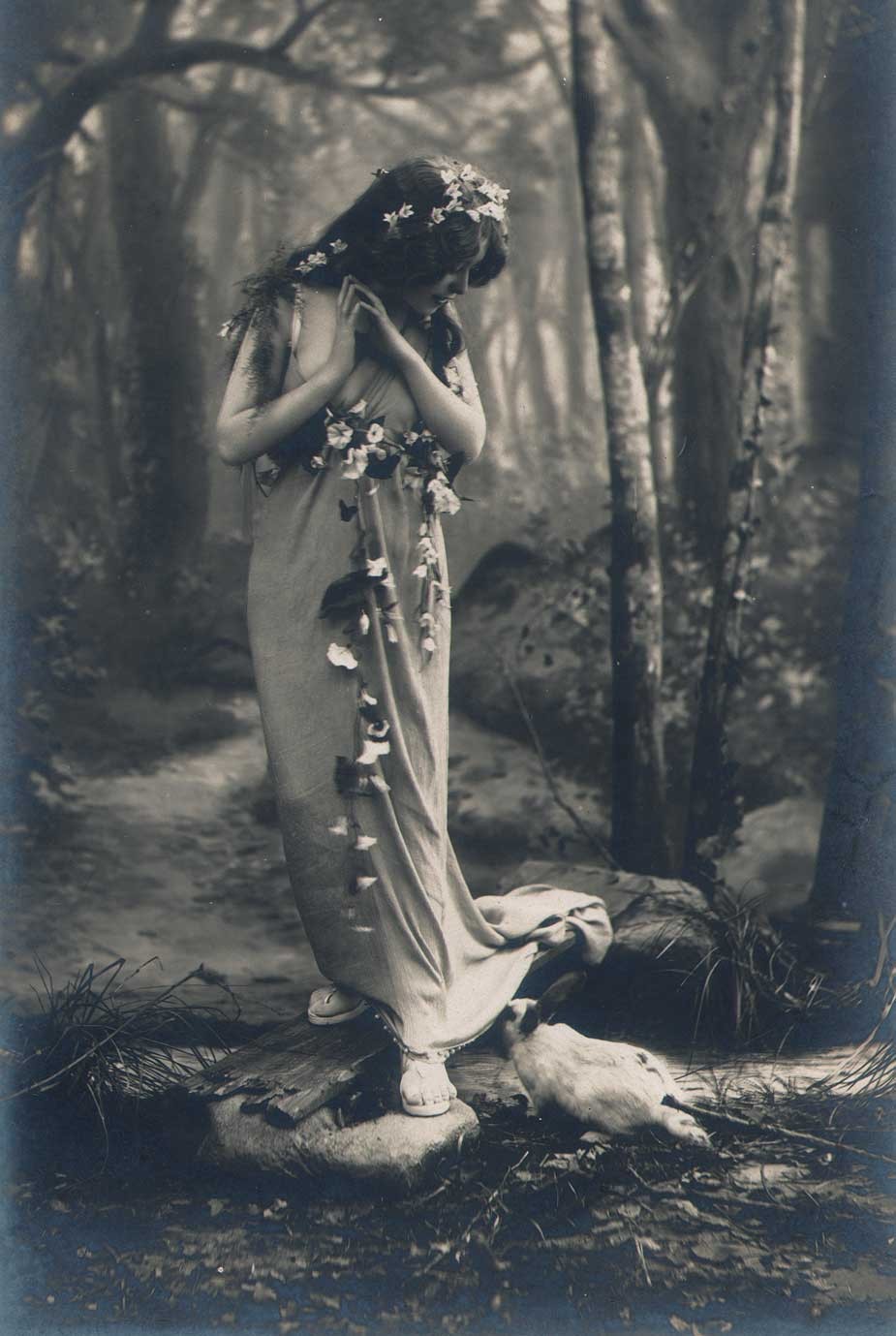 Detail: “Les Fleurs Dans Le Bois” : Léopold-Émile Reutlinger: French (1863-1937): vintage Bromide photograph, ca. 1905. 22.3 x 14.1 | 34.0 x 24.2 cm. Featuring a painted backdrop and wood board placed over a “stream”, this studio photograph features a white rabbit investigating the Belle Epoque era model identified from other variants as “Miss Doll”.(proper identification of this model would be of interest as she has remained a popular subject seen in countless vintage postcards, many hand-tinted) This example was printed by the Milan atelier Maison Tensi and included as a full-page plate in the February, 1905 issue of “La Fotographia Artistica”, a French/Italian photographic journal. From: PhotoSeed Archive
Detail: “Les Fleurs Dans Le Bois” : Léopold-Émile Reutlinger: French (1863-1937): vintage Bromide photograph, ca. 1905. 22.3 x 14.1 | 34.0 x 24.2 cm. Featuring a painted backdrop and wood board placed over a “stream”, this studio photograph features a white rabbit investigating the Belle Epoque era model identified from other variants as “Miss Doll”.(proper identification of this model would be of interest as she has remained a popular subject seen in countless vintage postcards, many hand-tinted) This example was printed by the Milan atelier Maison Tensi and included as a full-page plate in the February, 1905 issue of “La Fotographia Artistica”, a French/Italian photographic journal. From: PhotoSeed Archive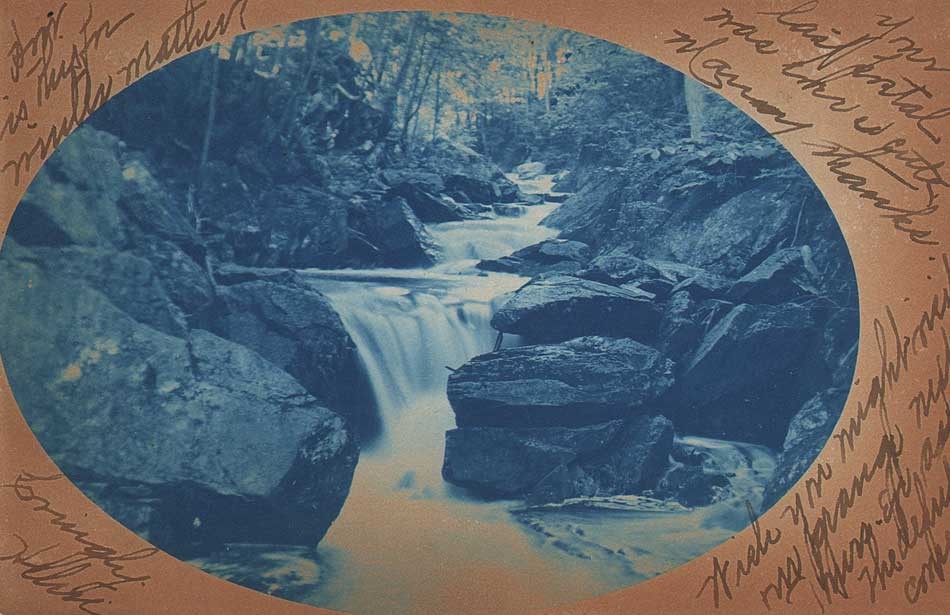 “A Rocky Brook” (New England?) : ca. 1906: Unknown American photographer: vintage cyanotype rppc: 8.9 x 13.8 cm. This idyllic cascading waterfall may depict the Minnewawa Glen in Marlborough, New Hampshire. Signed on the recto: “Lovingly Helen” in the lower left corner, it’s postmarked November 15, 1906 from Marlboro, N.H. addressed to Miss Nettie A. Hastings of East Sullivan, N.H. From: PhotoSeed Archive
“A Rocky Brook” (New England?) : ca. 1906: Unknown American photographer: vintage cyanotype rppc: 8.9 x 13.8 cm. This idyllic cascading waterfall may depict the Minnewawa Glen in Marlborough, New Hampshire. Signed on the recto: “Lovingly Helen” in the lower left corner, it’s postmarked November 15, 1906 from Marlboro, N.H. addressed to Miss Nettie A. Hastings of East Sullivan, N.H. From: PhotoSeed Archive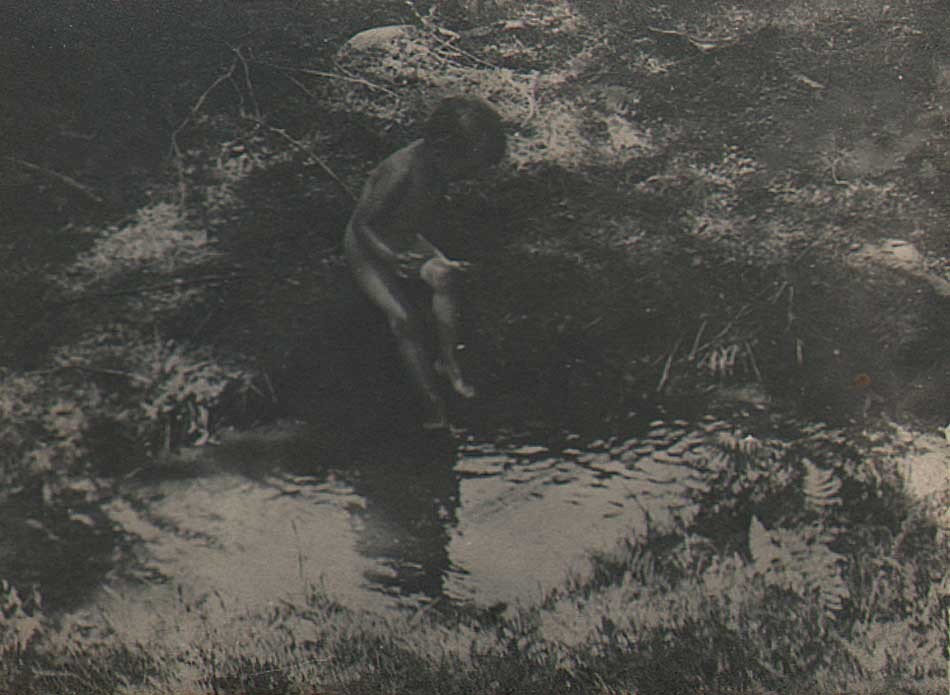 “John Robert Tucker Skinny Dipping”: Charles Rollins Tucker, American (b. 1868): ca. 1915: unmounted platinum print: 3.8 x 5.2 cm. Born in March, 1914, John Robert Tucker, was the second of three children born to the former Mary Carruthers and photographer Charles R. Tucker. Here, the young boy plays in a woodland stream, with the photograph most likely taken in New England. John, according to his 1941 marriage certificate, was an electrical engineer by training. He died in 1991 in La Habra, Orange County, CA. From: PhotoSeed Archive
“John Robert Tucker Skinny Dipping”: Charles Rollins Tucker, American (b. 1868): ca. 1915: unmounted platinum print: 3.8 x 5.2 cm. Born in March, 1914, John Robert Tucker, was the second of three children born to the former Mary Carruthers and photographer Charles R. Tucker. Here, the young boy plays in a woodland stream, with the photograph most likely taken in New England. John, according to his 1941 marriage certificate, was an electrical engineer by training. He died in 1991 in La Habra, Orange County, CA. From: PhotoSeed Archive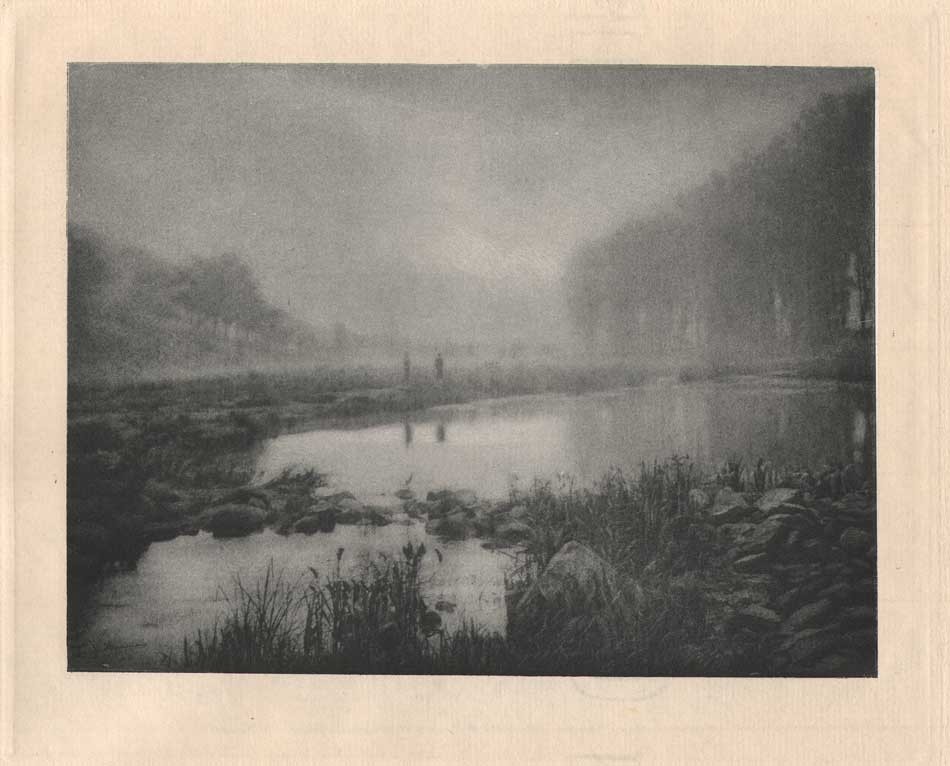 “Brume après la Pluie”: (1906) 1908: Gustave Marissiaux, Belgian (1872-1929) Photogravure on Van Gelder Zonen laid paper: 13.4 x 17.6 | 28.4 x 39.9 cm. Plate XXVI from Marissiaux’s tour-de-force gravure folio “Visions D’Artiste” comprised of 30 plates dating 1899-1908. Translating to “Mist after the Rain”, two figures in the distance stand looking out over an enlarged pond or stream located in "La Terre Wallonne” as identified in the portfolio index: more commonly known today as Wallonia- the southern region of Belgium. From: PhotoSeed Archive
“Brume après la Pluie”: (1906) 1908: Gustave Marissiaux, Belgian (1872-1929) Photogravure on Van Gelder Zonen laid paper: 13.4 x 17.6 | 28.4 x 39.9 cm. Plate XXVI from Marissiaux’s tour-de-force gravure folio “Visions D’Artiste” comprised of 30 plates dating 1899-1908. Translating to “Mist after the Rain”, two figures in the distance stand looking out over an enlarged pond or stream located in "La Terre Wallonne” as identified in the portfolio index: more commonly known today as Wallonia- the southern region of Belgium. From: PhotoSeed Archive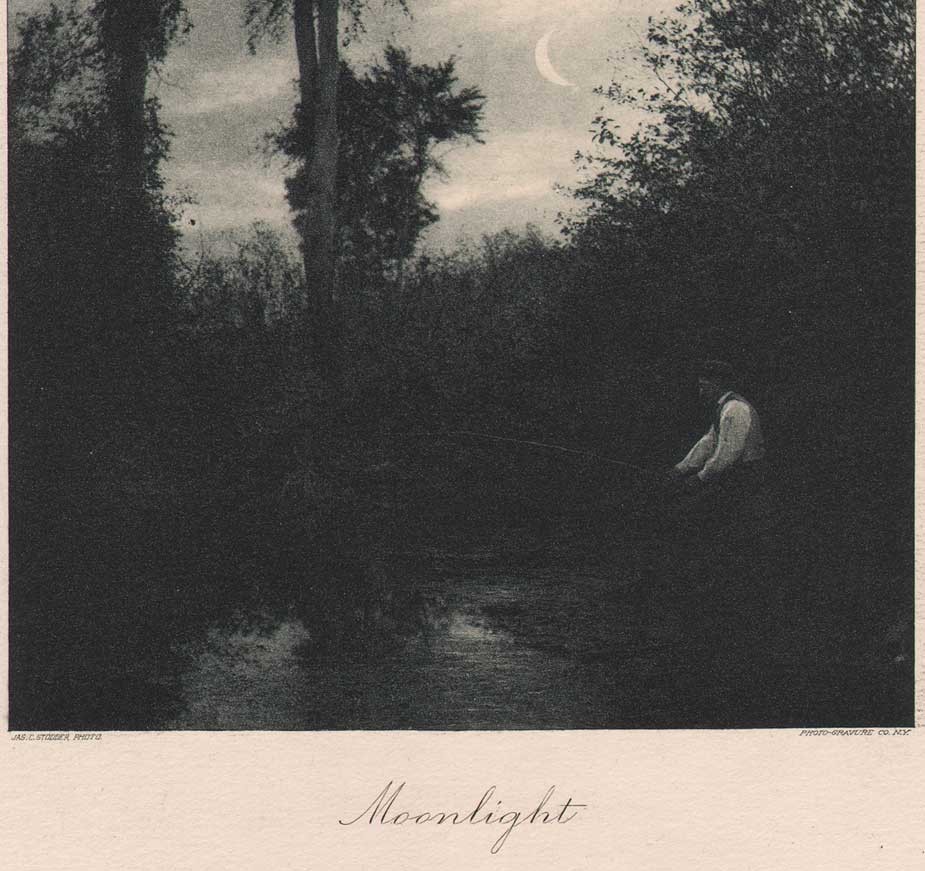 Detail: “Moonlight”: James C. Stodder, American: (1838-1917). 1890. Hand-pulled photogravure published in periodical "Sun & Shade”, New York: November, 1890: whole #27: N.Y. Photogravure Co.: 18.3 x 11.9 | 35.0 x 27.4 cm. A crescent moon rises above a wooded landscape at dusk while a gentleman fishes from the banks of a pond or stream. Stodder graduated from Rensselaer Polytechnic Institute in 1859 and moved to Bangor, Maine, where he first learned the wet-plate process of photography. A lawyer, he was son of a Boston jeweler, (obit) and financially well off. In 1876, he accompanied famed Hudson River School painter Frederic E. Church to the Mount Katahdin region of Maine. From: PhotoSeed Archive
Detail: “Moonlight”: James C. Stodder, American: (1838-1917). 1890. Hand-pulled photogravure published in periodical "Sun & Shade”, New York: November, 1890: whole #27: N.Y. Photogravure Co.: 18.3 x 11.9 | 35.0 x 27.4 cm. A crescent moon rises above a wooded landscape at dusk while a gentleman fishes from the banks of a pond or stream. Stodder graduated from Rensselaer Polytechnic Institute in 1859 and moved to Bangor, Maine, where he first learned the wet-plate process of photography. A lawyer, he was son of a Boston jeweler, (obit) and financially well off. In 1876, he accompanied famed Hudson River School painter Frederic E. Church to the Mount Katahdin region of Maine. From: PhotoSeed Archive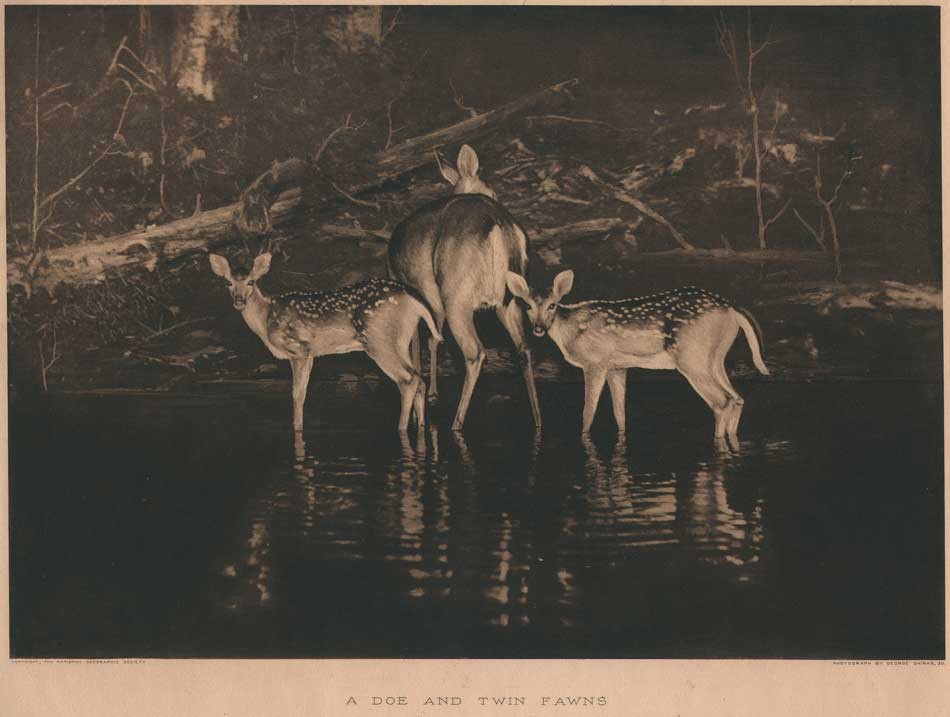 “A Doe and Twin Fawns” (taken 1896) 1916: George Shiras 3rd, American (1859-1942) Vintage photogravure published by the National Geographic Society, Washington, D.C. : 21.2 x 30.3 | 40.5 x 50.8 cm. A pioneer of using flashlight photography to record wildlife in their natural environments at night, Shiras used the method of “Jacklighting”, a form of hunting using a fixed continuous light source mounted in the bow of a canoe to draw the attention of wildlife: in this case three deer, while then utilizing magnesium flash-powder to freeze the scene in-camera. His series of twelve midnight views, including “A Doe and Twin Fawns”-also known as “Innocents Abroad” would earn Shiras international acclaim and many important awards. A one-term Congressman for the state of Michigan, (his father George Shiras Sr. was a former Justice of the U.S. Supreme Court) he was also an important naturalist who helped placed migratory birds and fish under Federal control. (The eventual 1918 Migratory Bird Treaty Act had groundings in legislation Shiras introduced to Congress in 1903 as the first comprehensive migratory bird law not voted on.) For additional background, see article by Matthew Brower in the journal History of Photography, Summer,2008: “George Shiras and the Circulation of Wildlife Photography”. From: PhotoSeed Archive
“A Doe and Twin Fawns” (taken 1896) 1916: George Shiras 3rd, American (1859-1942) Vintage photogravure published by the National Geographic Society, Washington, D.C. : 21.2 x 30.3 | 40.5 x 50.8 cm. A pioneer of using flashlight photography to record wildlife in their natural environments at night, Shiras used the method of “Jacklighting”, a form of hunting using a fixed continuous light source mounted in the bow of a canoe to draw the attention of wildlife: in this case three deer, while then utilizing magnesium flash-powder to freeze the scene in-camera. His series of twelve midnight views, including “A Doe and Twin Fawns”-also known as “Innocents Abroad” would earn Shiras international acclaim and many important awards. A one-term Congressman for the state of Michigan, (his father George Shiras Sr. was a former Justice of the U.S. Supreme Court) he was also an important naturalist who helped placed migratory birds and fish under Federal control. (The eventual 1918 Migratory Bird Treaty Act had groundings in legislation Shiras introduced to Congress in 1903 as the first comprehensive migratory bird law not voted on.) For additional background, see article by Matthew Brower in the journal History of Photography, Summer,2008: “George Shiras and the Circulation of Wildlife Photography”. From: PhotoSeed Archive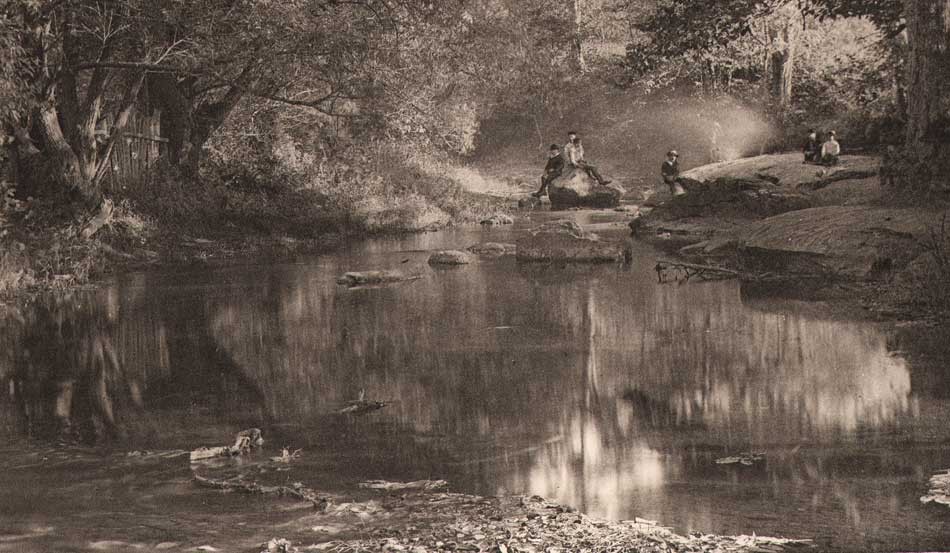 Detail: “A Corn Roast” Oliver Patterson Watts, American: (1865-1953). 1892. Hand-pulled photogravure published in periodical "Sun & Shade”, New York: June, 1892: whole #46: N.Y. Photogravure Co.: 14.7 x 23.2 | 34.6 x 27.4 cm. The index for the issue of Sun & Shade in which this photograph appears states: “Mr. Watts writes us that while wandering with his camera along “The Green,” a favorite picnic ground near Thomastown,(sic) Maine, he came upon this group of boys roasting corn and potatoes. At the sight of the camera they immediately grouped themselves, anxious to be “took.” The negative was made with a Scovill Favorite Camera, Waterbury lens, with an exposure of five seconds on a seed plate. It was developed with Pyro and Sodium Carbonate.” Dr. Oliver Patterson Watts was born in Thomaston, Maine, and graduated from Bowdoin College in 1889. Interestingly, in 1890, Potts and Dr. Julius Stieglitz, the brother of Alfred Stieglitz, were fellow scholars in chemistry at the newly opened Clark University in Worcester, MA. He later entered the University of Wisconsin in 1905 and took charge of the Carnegie Research on Electrolytic Iron under Dr. Charles F. Burgess. According to an Oct. 2009 article on Potts for the online resource Plating & Surface Finishing, the most important of his fifty-nine papers on plating and corrosion is probably “Rapid Nickel Plating,” presented before the Electrochemical Society in 1915. From: PhotoSeed Archive
Detail: “A Corn Roast” Oliver Patterson Watts, American: (1865-1953). 1892. Hand-pulled photogravure published in periodical "Sun & Shade”, New York: June, 1892: whole #46: N.Y. Photogravure Co.: 14.7 x 23.2 | 34.6 x 27.4 cm. The index for the issue of Sun & Shade in which this photograph appears states: “Mr. Watts writes us that while wandering with his camera along “The Green,” a favorite picnic ground near Thomastown,(sic) Maine, he came upon this group of boys roasting corn and potatoes. At the sight of the camera they immediately grouped themselves, anxious to be “took.” The negative was made with a Scovill Favorite Camera, Waterbury lens, with an exposure of five seconds on a seed plate. It was developed with Pyro and Sodium Carbonate.” Dr. Oliver Patterson Watts was born in Thomaston, Maine, and graduated from Bowdoin College in 1889. Interestingly, in 1890, Potts and Dr. Julius Stieglitz, the brother of Alfred Stieglitz, were fellow scholars in chemistry at the newly opened Clark University in Worcester, MA. He later entered the University of Wisconsin in 1905 and took charge of the Carnegie Research on Electrolytic Iron under Dr. Charles F. Burgess. According to an Oct. 2009 article on Potts for the online resource Plating & Surface Finishing, the most important of his fifty-nine papers on plating and corrosion is probably “Rapid Nickel Plating,” presented before the Electrochemical Society in 1915. From: PhotoSeed Archive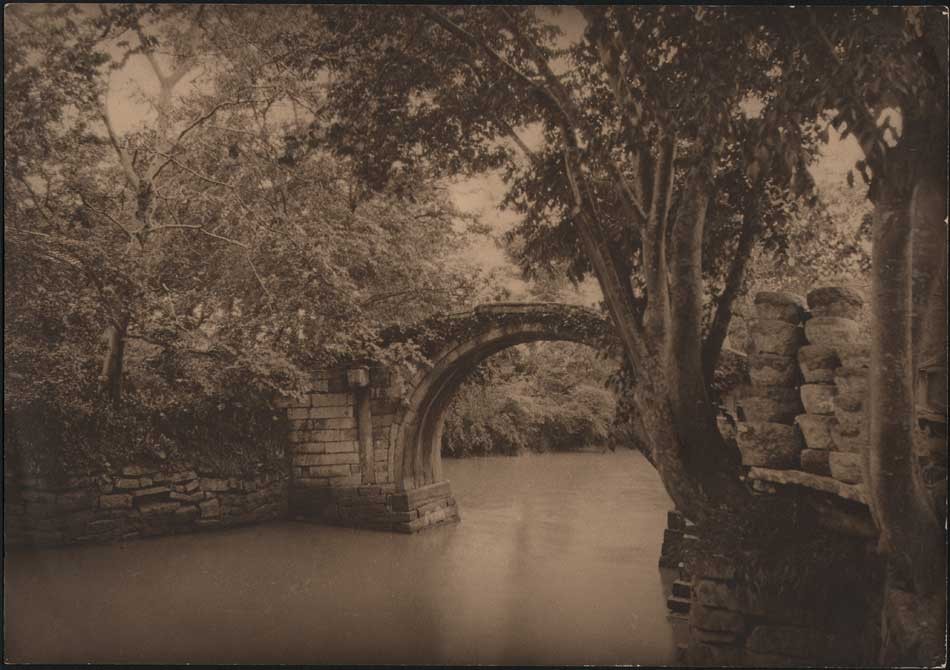 “Mutu Bridge”: Donald Mennie, Scottish (1875-1944) 1922: Vintage unmounted bromide print: 24.2 x 34.6 cm. This picturesque Chinese river scene first appeared as a full-page plate variant in the 1914 volume “My Lady of the Chinese Courtyard” (between pp. 254-5) by author Elizabeth Cooper and then as Plate #7 “Mutu Bridge” in the photographer’s ca. 1914 work “Picturesque China: A Series of Vandyck Photogravures illustrating Chinese Life and Surroundings”. From: PhotoSeed Archive
“Mutu Bridge”: Donald Mennie, Scottish (1875-1944) 1922: Vintage unmounted bromide print: 24.2 x 34.6 cm. This picturesque Chinese river scene first appeared as a full-page plate variant in the 1914 volume “My Lady of the Chinese Courtyard” (between pp. 254-5) by author Elizabeth Cooper and then as Plate #7 “Mutu Bridge” in the photographer’s ca. 1914 work “Picturesque China: A Series of Vandyck Photogravures illustrating Chinese Life and Surroundings”. From: PhotoSeed Archive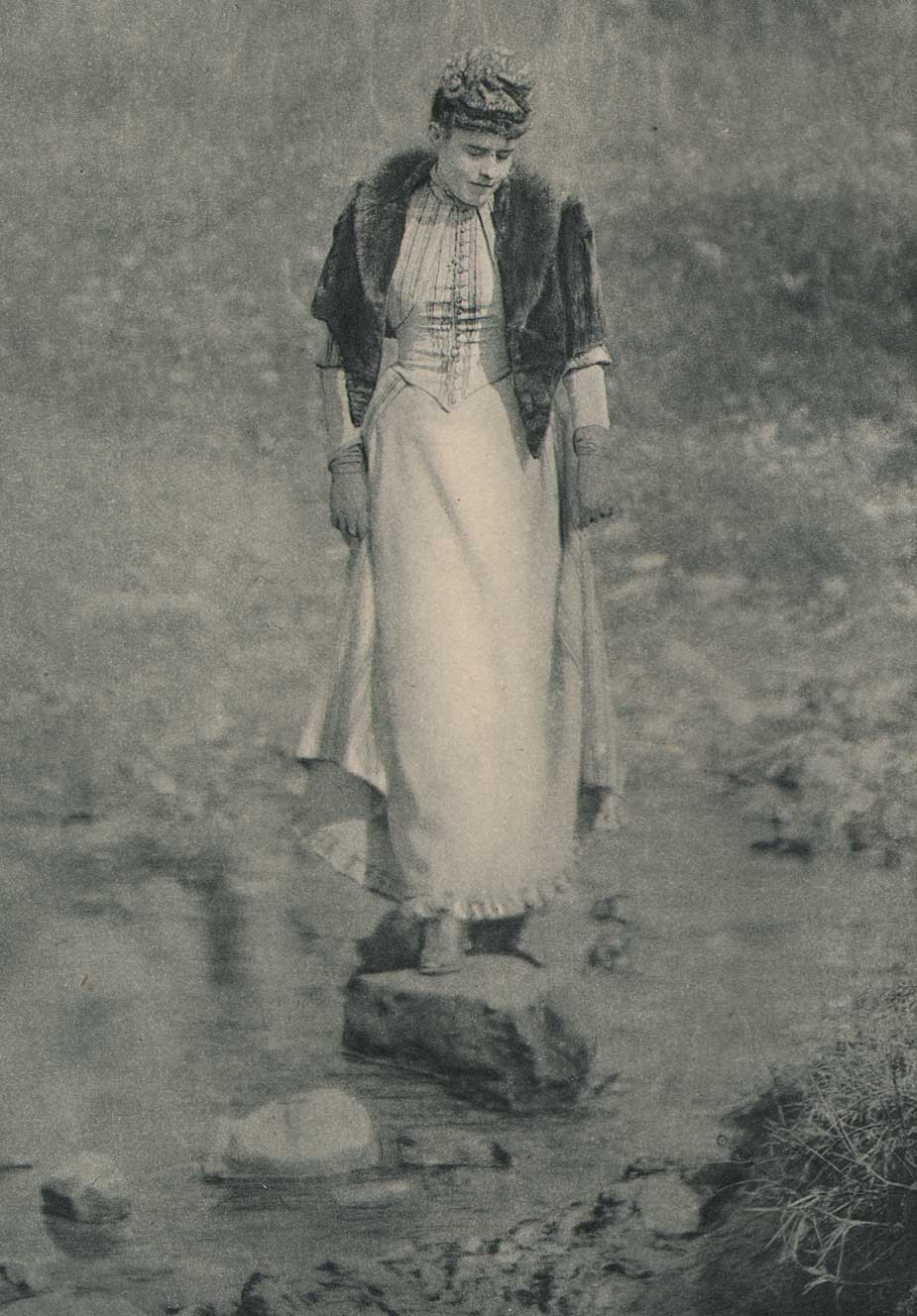 Detail: “Stepping Stones” George Bacon Wood Jr., American: (1832-1909). 1894. Hand-pulled photogravure published in periodical "Sun & Shade”, New York: January, 1894: whole #65: N.Y. Photogravure Co.: 20.5 x 11.7 | 34.9 x 27.5 cm. The index for the issue of Sun & Shade in which this photograph appears states: “To the meditative woman crossing the brook with careful steps upon the projecting stones, Oliver Wendell Holmes’ words, in his “Professor at the Breakfast Table,” can be appropriately applied: “The wisest woman you talk with is ignorant of something that you know, but an elegant woman never forgets her elegance.” With no eye to see her, as she crosses the woodland stream, the figure in the picture appears reposeful, full of thought, and unconsciously elegant in pose. This is a charming photograph from nature, simple, truthful and artistic.” From: PhotoSeed Archive
Detail: “Stepping Stones” George Bacon Wood Jr., American: (1832-1909). 1894. Hand-pulled photogravure published in periodical "Sun & Shade”, New York: January, 1894: whole #65: N.Y. Photogravure Co.: 20.5 x 11.7 | 34.9 x 27.5 cm. The index for the issue of Sun & Shade in which this photograph appears states: “To the meditative woman crossing the brook with careful steps upon the projecting stones, Oliver Wendell Holmes’ words, in his “Professor at the Breakfast Table,” can be appropriately applied: “The wisest woman you talk with is ignorant of something that you know, but an elegant woman never forgets her elegance.” With no eye to see her, as she crosses the woodland stream, the figure in the picture appears reposeful, full of thought, and unconsciously elegant in pose. This is a charming photograph from nature, simple, truthful and artistic.” From: PhotoSeed Archive “Derniers Rayons Dans la Forêt”: Guglielmo Oliaro, Italian: (1874 -1936) vintage Bromide photograph, ca. 1900? 1907: 16.6 x 22.5 | 23.5 x 32.7 cm. Translating to “Last Rays In The Forest”, this bucolic scene at dusk features a rushing stream and footbridge bisecting a a silhouetted line of Pollarded Willow trees. From Turin, amateur photographer Dr. Guglielmo Oliaro was very interested in the arts, founding a medical publishing house that survives to this day: From the InterFairs online resource: “Minerva Medica was the brainchild of a Turin GP (General Practitioner -ed.) Dr. Guglielmo Oliaro, a scientist with a passion for literature, art and music. It was on December 8 1925 that Dr. Oliaro got together with a small group of partners to set up the original company, Tipografia Editrice Minerva based in Turin. The creation of that company was a response to the growing success both in Italy and abroad, of Minerva Medica, a weekly journal for the general practitioner that first came out in 1909. Edizioni Minerva Medica S.p.A. was set up as a limited company by Dr. Guglielmo Oliaro on June 9 1934, for the purpose of supplying the Italian medical profession with text-books and scientific journals.” This example of Oliaro’s work was printed by the Milan atelier Maison Tensi and included as a full-page plate in the April, 1907 issue of “La Fotographia Artistica”, a French/Italian photographic journal. From: PhotoSeed Archive
“Derniers Rayons Dans la Forêt”: Guglielmo Oliaro, Italian: (1874 -1936) vintage Bromide photograph, ca. 1900? 1907: 16.6 x 22.5 | 23.5 x 32.7 cm. Translating to “Last Rays In The Forest”, this bucolic scene at dusk features a rushing stream and footbridge bisecting a a silhouetted line of Pollarded Willow trees. From Turin, amateur photographer Dr. Guglielmo Oliaro was very interested in the arts, founding a medical publishing house that survives to this day: From the InterFairs online resource: “Minerva Medica was the brainchild of a Turin GP (General Practitioner -ed.) Dr. Guglielmo Oliaro, a scientist with a passion for literature, art and music. It was on December 8 1925 that Dr. Oliaro got together with a small group of partners to set up the original company, Tipografia Editrice Minerva based in Turin. The creation of that company was a response to the growing success both in Italy and abroad, of Minerva Medica, a weekly journal for the general practitioner that first came out in 1909. Edizioni Minerva Medica S.p.A. was set up as a limited company by Dr. Guglielmo Oliaro on June 9 1934, for the purpose of supplying the Italian medical profession with text-books and scientific journals.” This example of Oliaro’s work was printed by the Milan atelier Maison Tensi and included as a full-page plate in the April, 1907 issue of “La Fotographia Artistica”, a French/Italian photographic journal. From: PhotoSeed Archive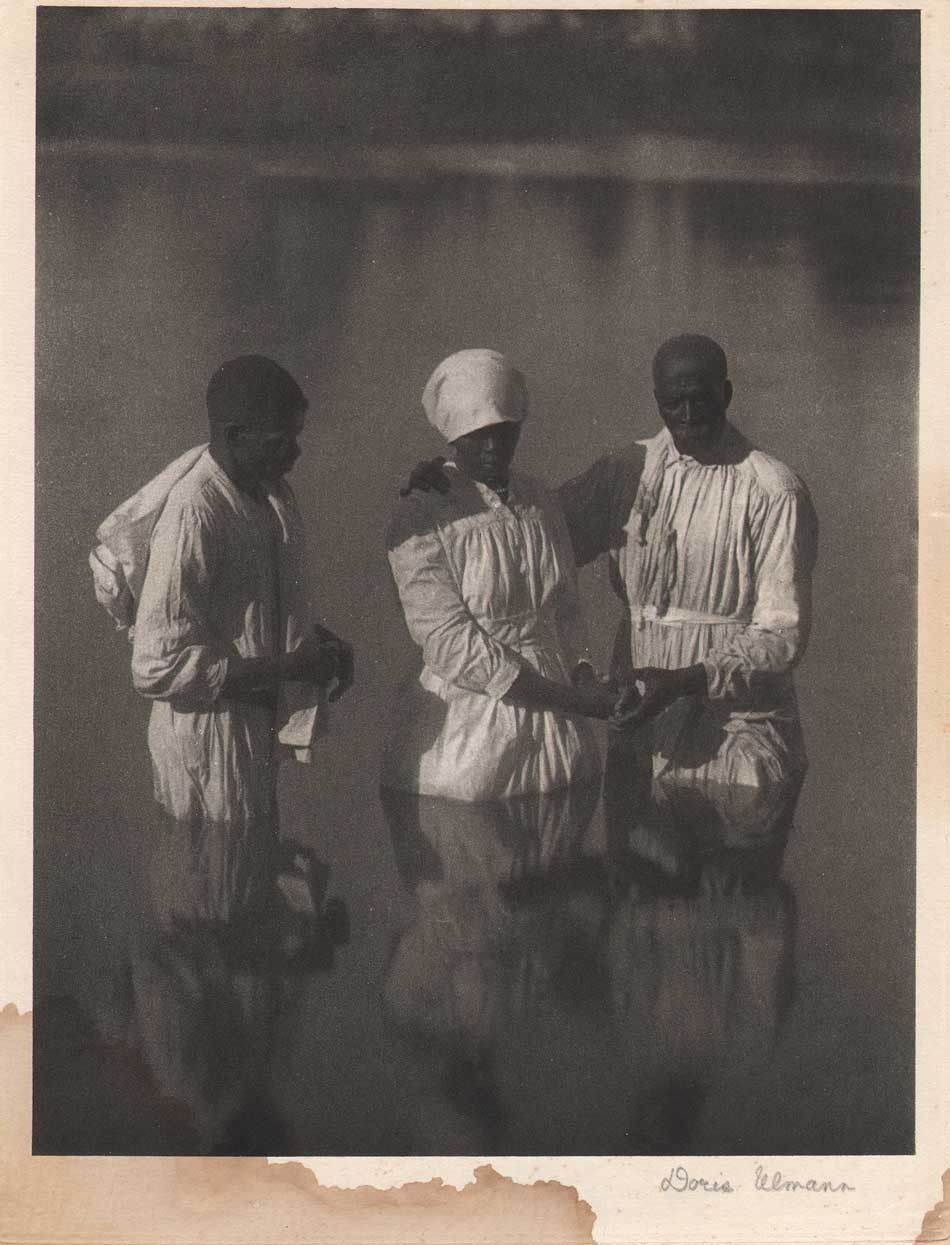 “Baptismal Scene” : Doris Ulmann, American: (1882 –1934) 1933: Signed, hand-pulled photogravure included as additional loose plate from deluxe edition of “Roll, Jordan, Roll”: 21.3 x 16.4 | 28.3 x 20.7 cm. In a rather interesting coincidence, this particular example of a summer stream showing a well-known river baptism by Ulmann has been partially immersed by moisture along the lower margin. From p. 116 of the volume: “A candidate for admission into the church must first be baptized. The Methodists have water sprinkled on their heads, but Baptists must be publicly immersed. These “baptisms” attract large crowds of onlookers. The candidates all arrive at the “pool” dressed in long white robes, which are carefully put away after the ceremony to serve as their shrouds some day. When they are assembled, the preacher and the leader, also dressed in white robes, lead the first candidate down into the water, where he is dipped three times, once in the name of the Father, once in the name of the Son, and once in the name of the Holy Ghost. As he is lead up out of the water, all his sins are left behind, drowned and buried in a watery grave. His soul is cleansed white as snow and he is ready to be received into full church membership. Unless he “falls” into sin and gets “turned out” of the church, he will some day be received into fellowship with God’s holy angels up in heaven.” The following review of Roll, Jordon, Roll comes from Steve Watson and was included on the Amon Carter Museum of American Art website, first published in 2016: Photographer Doris Ulmann came from an affluent white New York City family. She took teacher training with photographer Lewis Hine at the Ethical Culture School and subsequently studied psychology and law at Columbia University. She also studied photography with Clarence H. White, a founding member of the Photo-Secession movement known for teaching the Pictorialist style. Ulmann collaborated with novelist Julia Peterkin on a book project titled Roll, Jordan, Roll(New York: R.O. Ballou, 1933). The book focuses on the lives of former slaves and their descendants on a plantation in the Gullah coastal region of South Carolina. Peterkin, who won the Pulitzer Prize for her novel Scarlet Sister Mary (Indianapolis: Bobbs-Merrill, 1928), was born in South Carolina and raised by a black nursemaid who taught her the Gullah dialect. She married the heir to Lang Syne, a 2,000-acre cotton plantation, which became the setting for Roll, Jordan, Roll. Ulmann began photographing there in 1929. Roll, Jordan, Roll is titled after the spiritual written by English Methodist leader Charles Wesley in the 18th century which became well-known among slaves in the United States during the 19th century. Appropriated as a coded message for escape, by the end of the American Civil War it had become known through much of the eastern United States. In the 20th century it helped inspire the blues, and it remains a staple in gospel music. Roll, Jordan, Roll was illustrated with 90 photogravure plates made from Ulmann’s large-format negatives. Although they comprise an amazing ethnographic study, today Ulmann’s Pictorialist aesthetic seems a strange choice for making documentary images. The hazy, soft-focus photographs lend a sentimental, nostalgic impression that belies the underlying exploitative history of her subjects. From: PhotoSeed Archive
“Baptismal Scene” : Doris Ulmann, American: (1882 –1934) 1933: Signed, hand-pulled photogravure included as additional loose plate from deluxe edition of “Roll, Jordan, Roll”: 21.3 x 16.4 | 28.3 x 20.7 cm. In a rather interesting coincidence, this particular example of a summer stream showing a well-known river baptism by Ulmann has been partially immersed by moisture along the lower margin. From p. 116 of the volume: “A candidate for admission into the church must first be baptized. The Methodists have water sprinkled on their heads, but Baptists must be publicly immersed. These “baptisms” attract large crowds of onlookers. The candidates all arrive at the “pool” dressed in long white robes, which are carefully put away after the ceremony to serve as their shrouds some day. When they are assembled, the preacher and the leader, also dressed in white robes, lead the first candidate down into the water, where he is dipped three times, once in the name of the Father, once in the name of the Son, and once in the name of the Holy Ghost. As he is lead up out of the water, all his sins are left behind, drowned and buried in a watery grave. His soul is cleansed white as snow and he is ready to be received into full church membership. Unless he “falls” into sin and gets “turned out” of the church, he will some day be received into fellowship with God’s holy angels up in heaven.” The following review of Roll, Jordon, Roll comes from Steve Watson and was included on the Amon Carter Museum of American Art website, first published in 2016: Photographer Doris Ulmann came from an affluent white New York City family. She took teacher training with photographer Lewis Hine at the Ethical Culture School and subsequently studied psychology and law at Columbia University. She also studied photography with Clarence H. White, a founding member of the Photo-Secession movement known for teaching the Pictorialist style. Ulmann collaborated with novelist Julia Peterkin on a book project titled Roll, Jordan, Roll(New York: R.O. Ballou, 1933). The book focuses on the lives of former slaves and their descendants on a plantation in the Gullah coastal region of South Carolina. Peterkin, who won the Pulitzer Prize for her novel Scarlet Sister Mary (Indianapolis: Bobbs-Merrill, 1928), was born in South Carolina and raised by a black nursemaid who taught her the Gullah dialect. She married the heir to Lang Syne, a 2,000-acre cotton plantation, which became the setting for Roll, Jordan, Roll. Ulmann began photographing there in 1929. Roll, Jordan, Roll is titled after the spiritual written by English Methodist leader Charles Wesley in the 18th century which became well-known among slaves in the United States during the 19th century. Appropriated as a coded message for escape, by the end of the American Civil War it had become known through much of the eastern United States. In the 20th century it helped inspire the blues, and it remains a staple in gospel music. Roll, Jordan, Roll was illustrated with 90 photogravure plates made from Ulmann’s large-format negatives. Although they comprise an amazing ethnographic study, today Ulmann’s Pictorialist aesthetic seems a strange choice for making documentary images. The hazy, soft-focus photographs lend a sentimental, nostalgic impression that belies the underlying exploitative history of her subjects. From: PhotoSeed Archive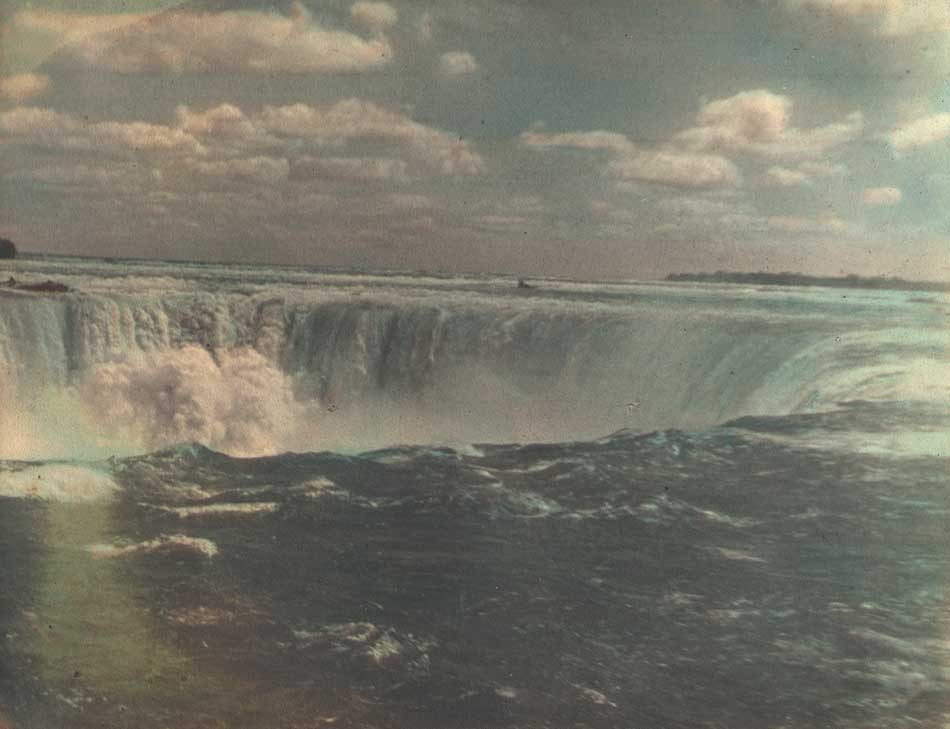 “Niagara Falls”: attributed to Arthur Hammond, American: born England: 1880-1962: hand-colored gelatin silver print mounted to album leaf, ca. 1930-1940: 19.2 x 24.2 | 25.0 x 32.7 cm. To conclude our post is a view of the ultimate Summer Stream: a view showing the Niagara River’s Horseshoe Falls from the Canadian side. From a personal album of nearly 100 photographs attributed to Hammond dating from around 1910-1940. Born in London, photographer Arthur Hammond arrived in America at Ellis Island in New York Harbor on July 31, 1909 and established himself with his own studio in Natick, MA outside Boston by 1912. In 1920, he authored the foundational book "Pictorial Composition in Photography" and became a leading voice for pictorialism in America through his position as associate editor of American Photography magazine that lasted 30 years from 1918-1949. From: PhotoSeed Archive
“Niagara Falls”: attributed to Arthur Hammond, American: born England: 1880-1962: hand-colored gelatin silver print mounted to album leaf, ca. 1930-1940: 19.2 x 24.2 | 25.0 x 32.7 cm. To conclude our post is a view of the ultimate Summer Stream: a view showing the Niagara River’s Horseshoe Falls from the Canadian side. From a personal album of nearly 100 photographs attributed to Hammond dating from around 1910-1940. Born in London, photographer Arthur Hammond arrived in America at Ellis Island in New York Harbor on July 31, 1909 and established himself with his own studio in Natick, MA outside Boston by 1912. In 1920, he authored the foundational book "Pictorial Composition in Photography" and became a leading voice for pictorialism in America through his position as associate editor of American Photography magazine that lasted 30 years from 1918-1949. From: PhotoSeed Archive
By the Stream
Paul Laurence Dunbar (1872-1906)
By the stream I dream in calm delight, and watch as in a glass,
How the clouds like crowds of snowy-hued and white-robed
maidens pass,
And the water into ripples breaks and sparkles as it spreads,
Like a host of armored knights with silver helmets on their heads.
And I deem the stream an emblem fit of human life may go,
For I find a mind may sparkle much and yet but shallows show,
And a soul may glow with myriad lights and wondrous mysteries,
When it only lies a dormant thing and mirrors what it sees.
From the Trenches a Century On
Posted November 2018 in Advertising, History of Photography, Photography, Significant Photographs, Unknown Photographers
For your consideration, we offer a happier vision of patriotic leanings supporting the home-front on this milestone day in history marking the end of World War 1.
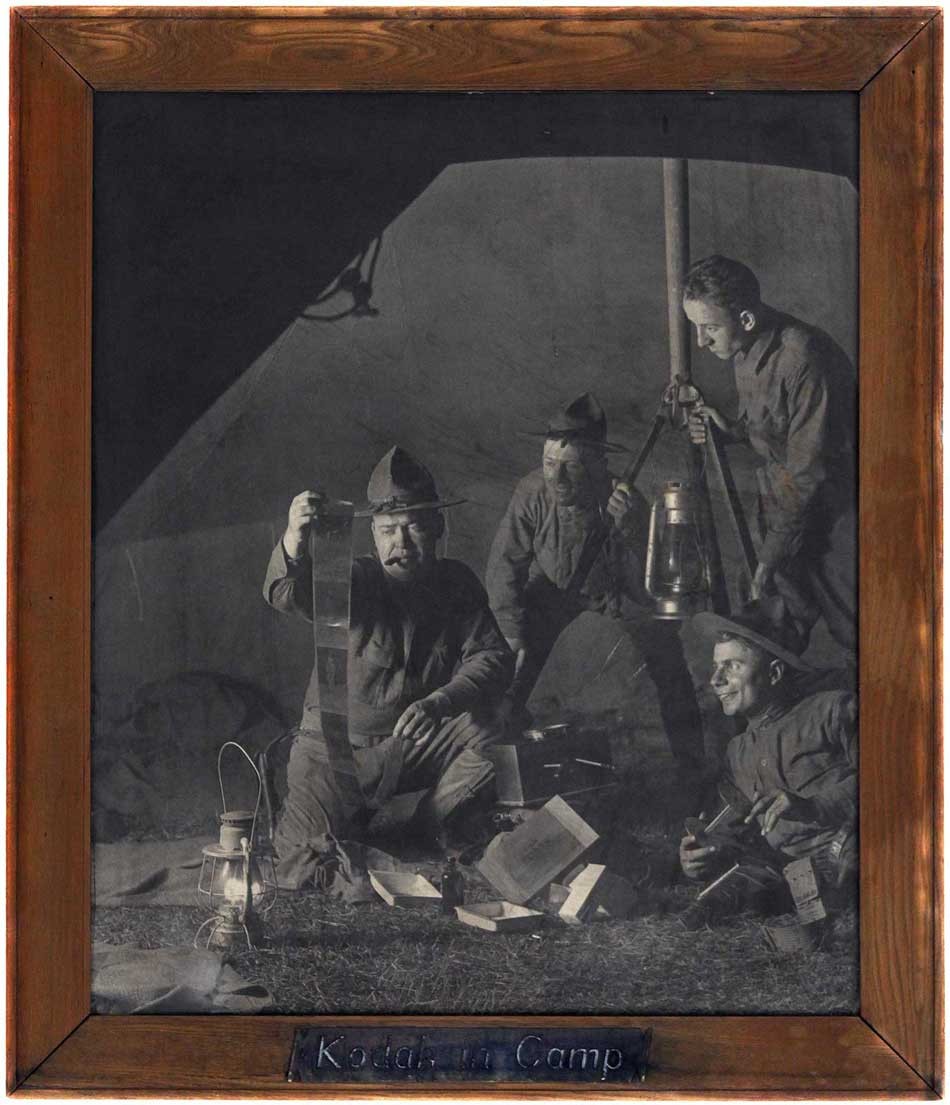 "Kodak in Camp": vintage framed bromide print ca. 1917 by unknown American photographer: Image Dimensions: 71.4 x 60.0 | cm 83.2 x 71.8 cm stained oak frame. This rare mammoth-sized Kodak advertising photograph featuring American “Doughboys” working together developing film in their tent at night was used by the Eastman company in their “Take a KODAK With You” advertising campaign. In late 1917, it appeared in publications including The Saturday Evening Post and The Independent (with which is incorporated Harpers Weekly) From: PhotoSeed Archive
"Kodak in Camp": vintage framed bromide print ca. 1917 by unknown American photographer: Image Dimensions: 71.4 x 60.0 | cm 83.2 x 71.8 cm stained oak frame. This rare mammoth-sized Kodak advertising photograph featuring American “Doughboys” working together developing film in their tent at night was used by the Eastman company in their “Take a KODAK With You” advertising campaign. In late 1917, it appeared in publications including The Saturday Evening Post and The Independent (with which is incorporated Harpers Weekly) From: PhotoSeed Archive
On the Eleventh Hour of the Eleventh Day of the Eleventh Month- November 11, 1918, the signing of the Armistice ending the Great War took place 60 kilometers north of Paris inside a railway carriage parked in the Forest of Compiègne. It has now been 100 years since that fateful day, on that fateful month and on that fateful hour. Sadly, mankind seems doomed to repeat his failures.
But a pivoting to Photography in relation to these weighty issues will always be of interest to the historian.
In 1914, the role of the medium expanded greatly at the outset of World War 1. In addition to photography’s new found power through smaller cameras to document unspeakable human suffering and death by the millions brought about by trench warfare, aerial reconnaissance photography gave countries the ability to monitor troop movements and to devise strategy in nearly real time. And then there was the home-front. The Eastman Kodak Company was certainly not going to let a war get in the way in order to call attention to their brand and sell more product.
Retooling like other large concerns in order to become an essential military contractor, they saw American Doughboys entering the war late in the conflict as brand ambassadors. As proof, the Kodak Vest Pocket camera, which debuted in 1912, found its’ way onto the front lines and trenches of many battlefields-legally or otherwise, and advertising posters hawking the camera as well as this oversized framed bromide print of soldiers for darkroom supplies and film called Kodak in Camp prominently appeared displayed in camera shops throughout the country.
And Kodak went further. As part of their national print advertising campaign dubbed “Take a KODAK with you”, this photo of nighttime developing in camp appeared full page in the pages of the Saturday Evening Post magazine for their August 4, 1917 issue as well as other publications around that time.
But most importantly, we honor the memory today of all the fallen. In a tribute to just one, a Scottish photographer by the name of Nichol Elliot, whose 1917 death in wartime Belgium is memorialized by a volume of his pictorial photographs accompanied by poems written by his wife Alice Elliot, we give her final stanza from An Idyll of Peace:
How swift from summer idylls came the wrench
Of life flung thence, by war and manhood’s will,
To battle roar and glare, or deathly chill
Of watch and warfare in the nightmare trench!
For peace divine man paid diviner price ⎯
In world-wide idyll of high sacrifice.
-Paired with Nichol Elliot photograph: In the Island, Toronto
For additional background on photography and the Great War, check out this New York Times Lens blog post from 2014.
Old Nasty Women
Posted January 2017 in Documentary Photography, History of Photography, New Additions, Significant Photographers, Significant Photographs
The historical photographic record doesn’t flinch when it comes to the importance of women, and I present herewith a short gallery as evidence, many of these photographs taken by women themselves. Mother Earth was surely proud of those millions who turned out in rallies all over the United States and across the World in support of the fairer sex on Saturday. And in Washington, D.C., it was a pointed, diverse, and joyous message presenting the true story of America heard loud and clear countering the utterances of the keynote speaker the day before.
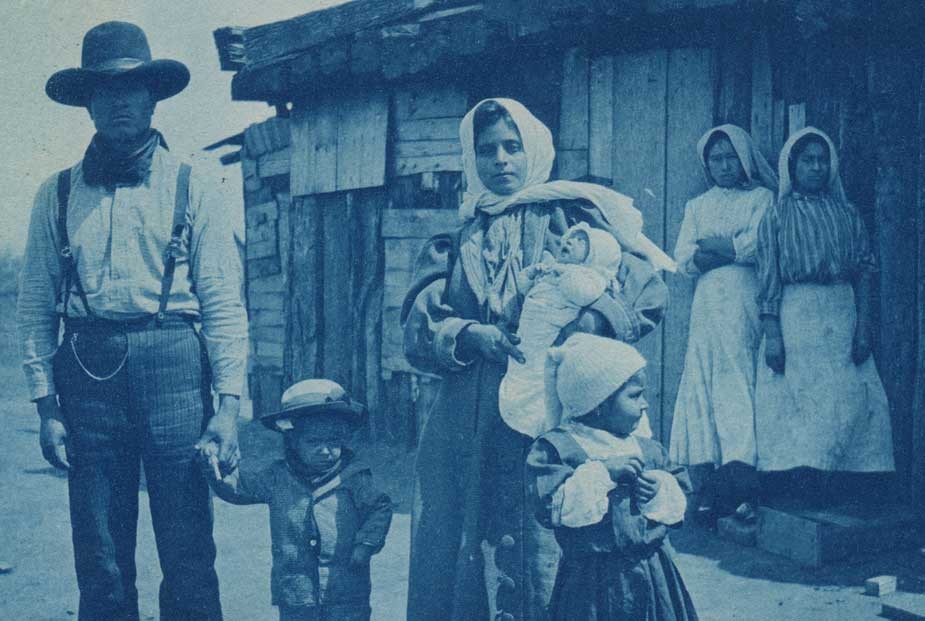 A Message to Washington: "Sweet-faced Little Mother" : Detail: Anonymous American Photographer: 1911: Cyanotype postcard mailed to Washington D.C. from Sweetwater Texas showing a proud Mexican family in front of their Texas & Pacific Railroad section house. 7.4 x 9.9 cm | 8.7 x 13.9 cm: Besides being built with the hard labor of Mexican and other nationalities in the later 19th Century, continued maintenance of American railroads like the "T & P" in places like Texas in the early 20th was often performed by them, with the rail line providing section houses along the track for temporary quarters to live in. Writing to a Mrs. Burnside on the card's verso, the following appears in neat script: "This man came up and asked me to come and take a picture of his baby, "just borned"-When I got there, the whole family wanted to be taken-so here they are the sweet-faced little mother and the baby, not quite 2 weeks old. They are such a happy-hearted class of people." From: PhotoSeed Archive
A Message to Washington: "Sweet-faced Little Mother" : Detail: Anonymous American Photographer: 1911: Cyanotype postcard mailed to Washington D.C. from Sweetwater Texas showing a proud Mexican family in front of their Texas & Pacific Railroad section house. 7.4 x 9.9 cm | 8.7 x 13.9 cm: Besides being built with the hard labor of Mexican and other nationalities in the later 19th Century, continued maintenance of American railroads like the "T & P" in places like Texas in the early 20th was often performed by them, with the rail line providing section houses along the track for temporary quarters to live in. Writing to a Mrs. Burnside on the card's verso, the following appears in neat script: "This man came up and asked me to come and take a picture of his baby, "just borned"-When I got there, the whole family wanted to be taken-so here they are the sweet-faced little mother and the baby, not quite 2 weeks old. They are such a happy-hearted class of people." From: PhotoSeed Archive
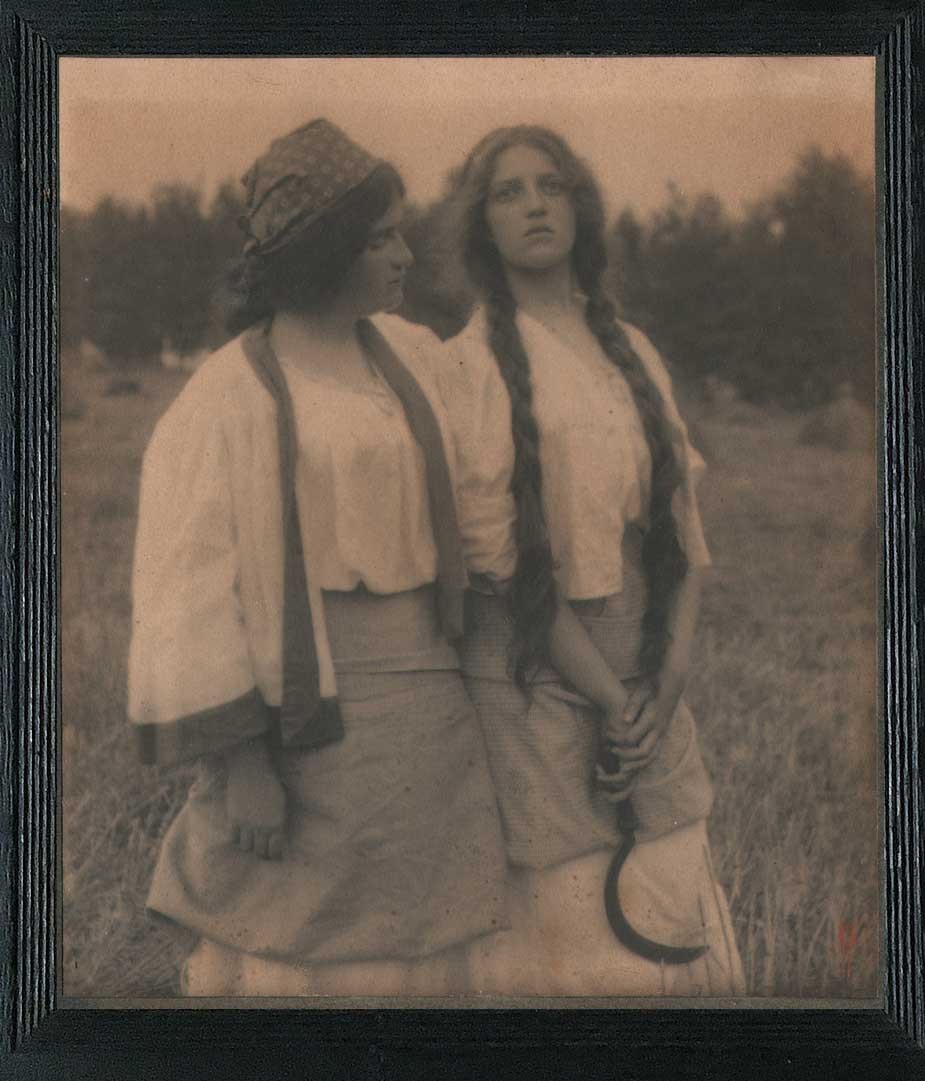 "The Song of the Meadow Lark": Mathilde Weil: American: (1872-1942) ca. 1900: Platinum print mounted on board signed in red with Weil cipher at lower right: 18.4 x 16.0 cm | 19.1 x 16.5 cm: black-painted wood frame: 28.4 x 25.7 cm: In December, 1899, critic Francis J. Ziegler, writing in Brush and Pencil for a review of the Philadelphia Photographic Salon, said of this photograph: "Among Philadelphia's artist photographers one of the most prominent is Miss Mathilde Weil, and her contributions to this exhibition are full of artistic excellence. Her "Song of the Meadow-Lark" has a suggestion of the Orient about it, notwithstanding the fact that the landscape is an American field and the two girls who have stopped in their reaping have American faces. This effect, I think, is due to the long braids of hair which hang down the front of one damsel's bodice, and the white jacket worn by her companion, the trimming of which repeats the same lines in artistic harmony." (p. 113) From: PhotoSeed Archive
"The Song of the Meadow Lark": Mathilde Weil: American: (1872-1942) ca. 1900: Platinum print mounted on board signed in red with Weil cipher at lower right: 18.4 x 16.0 cm | 19.1 x 16.5 cm: black-painted wood frame: 28.4 x 25.7 cm: In December, 1899, critic Francis J. Ziegler, writing in Brush and Pencil for a review of the Philadelphia Photographic Salon, said of this photograph: "Among Philadelphia's artist photographers one of the most prominent is Miss Mathilde Weil, and her contributions to this exhibition are full of artistic excellence. Her "Song of the Meadow-Lark" has a suggestion of the Orient about it, notwithstanding the fact that the landscape is an American field and the two girls who have stopped in their reaping have American faces. This effect, I think, is due to the long braids of hair which hang down the front of one damsel's bodice, and the white jacket worn by her companion, the trimming of which repeats the same lines in artistic harmony." (p. 113) From: PhotoSeed Archive
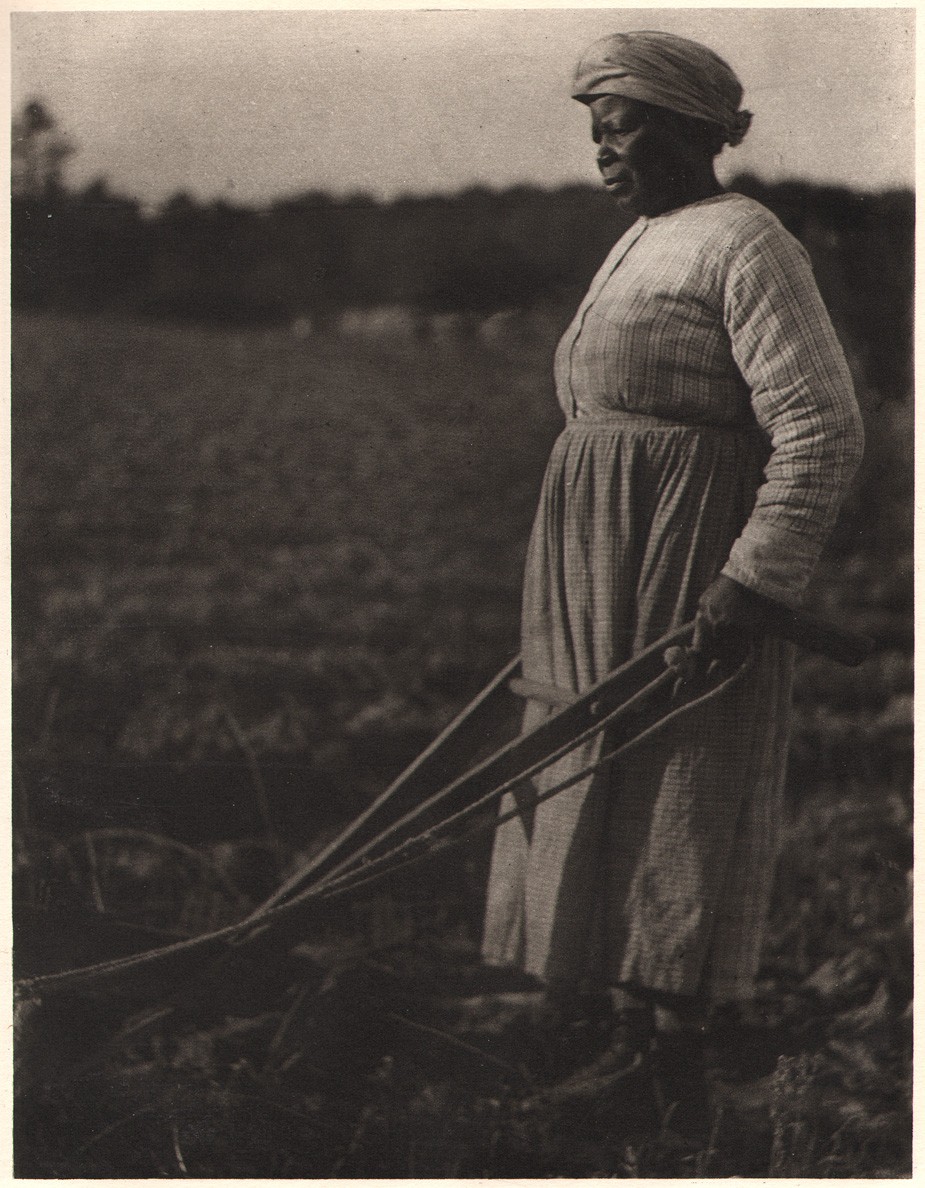 "Woman Behind Plow": Doris Ulmann, American: (1882-1934): 1933: hand-pulled photogravure: Plate 39 from the deluxe volume Roll Jordan Roll: New York: Robert O. Ballou: (text by Julia Peterkin) 21.2 x 16.3 | 28.4 x 20.5 cm: A landmark photographic volume of the 20th Century featuring ethnographic studies and portraits, this volume features 90 full-page copperplate gravures done in the Pictorial manner. Writing for the Amon Carter Museum of American Art in Texas, author Steve Watson describes the volume in part: "The book focuses on the lives of former slaves and their descendants on a plantation in the Gullah coastal region of South Carolina. Peterkin, who won the Pulitzer Prize for her novel Scarlet Sister Mary (Indianapolis: Bobbs-Merrill, 1928), was born in South Carolina and raised by a black nursemaid who taught her the Gullah dialect. She married the heir to Lang Syne, a 2,000-acre cotton plantation, which became the setting for Roll, Jordan, Roll. Ulmann began photographing there in 1929." From: PhotoSeed Archive
"Woman Behind Plow": Doris Ulmann, American: (1882-1934): 1933: hand-pulled photogravure: Plate 39 from the deluxe volume Roll Jordan Roll: New York: Robert O. Ballou: (text by Julia Peterkin) 21.2 x 16.3 | 28.4 x 20.5 cm: A landmark photographic volume of the 20th Century featuring ethnographic studies and portraits, this volume features 90 full-page copperplate gravures done in the Pictorial manner. Writing for the Amon Carter Museum of American Art in Texas, author Steve Watson describes the volume in part: "The book focuses on the lives of former slaves and their descendants on a plantation in the Gullah coastal region of South Carolina. Peterkin, who won the Pulitzer Prize for her novel Scarlet Sister Mary (Indianapolis: Bobbs-Merrill, 1928), was born in South Carolina and raised by a black nursemaid who taught her the Gullah dialect. She married the heir to Lang Syne, a 2,000-acre cotton plantation, which became the setting for Roll, Jordan, Roll. Ulmann began photographing there in 1929." From: PhotoSeed Archive
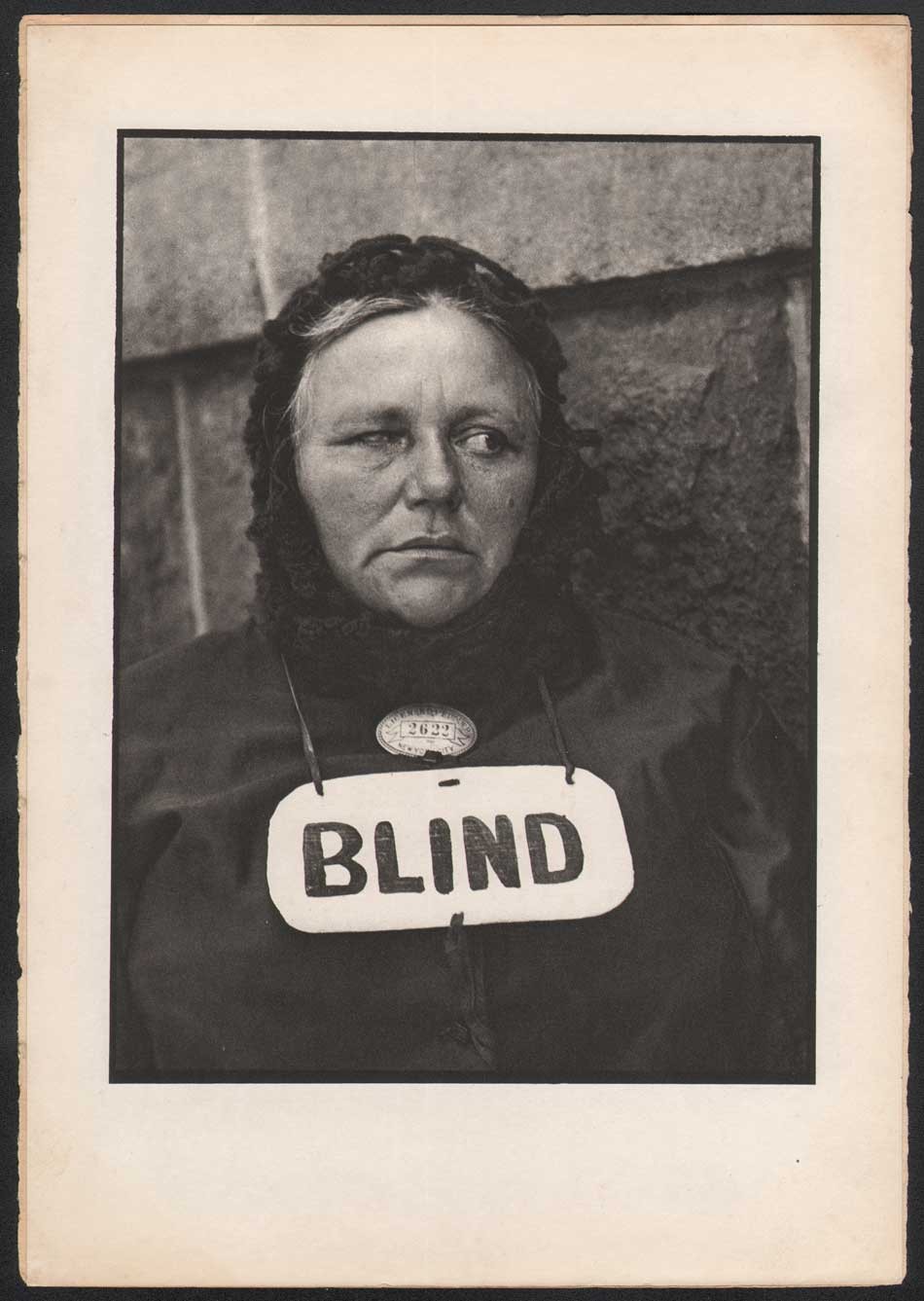 "Photograph-New York": Paul Strand, American: (1890-1976): 1917: hand-pulled photogravure from Camera Work XLIX/L: 22.4 x 16.6 | 29.7 x 20.6 cm: This iconic portrait of a blind woman, who has been issued a peddler's license by the city seen above her sign, was taken by Strand with the aid of either a false or prism lens as part of a series of ground-breaking modernist photographs done on the streets of New York City in the Fall of 1916. Writing the same year this portrait appeared in Camera Work, in August, 1917, an essay on Photography for the journal The Seven Arts concludes with the following observations by Strand-observations that could also certainly apply to the joyful diversity of human beings themselves, as in this case- womankind herself: "The existence of a medium, after all, is its absolute justification, if as so many seem to think, it needs one, and all comparison of potentialities is useless and irrelevant. Whether a water-color is inferior to an oil, or whether a drawing, an etching, or a photograph is not as important as either, is inconsequent. To have to despise something else is a sign of impotence. Let us rather accept joyously and with gratitude everything through which the spirit of man seeks to an ever fuller and more intense self-realization." (pp. 525-26) From: PhotoSeed Archive
"Photograph-New York": Paul Strand, American: (1890-1976): 1917: hand-pulled photogravure from Camera Work XLIX/L: 22.4 x 16.6 | 29.7 x 20.6 cm: This iconic portrait of a blind woman, who has been issued a peddler's license by the city seen above her sign, was taken by Strand with the aid of either a false or prism lens as part of a series of ground-breaking modernist photographs done on the streets of New York City in the Fall of 1916. Writing the same year this portrait appeared in Camera Work, in August, 1917, an essay on Photography for the journal The Seven Arts concludes with the following observations by Strand-observations that could also certainly apply to the joyful diversity of human beings themselves, as in this case- womankind herself: "The existence of a medium, after all, is its absolute justification, if as so many seem to think, it needs one, and all comparison of potentialities is useless and irrelevant. Whether a water-color is inferior to an oil, or whether a drawing, an etching, or a photograph is not as important as either, is inconsequent. To have to despise something else is a sign of impotence. Let us rather accept joyously and with gratitude everything through which the spirit of man seeks to an ever fuller and more intense self-realization." (pp. 525-26) From: PhotoSeed Archive
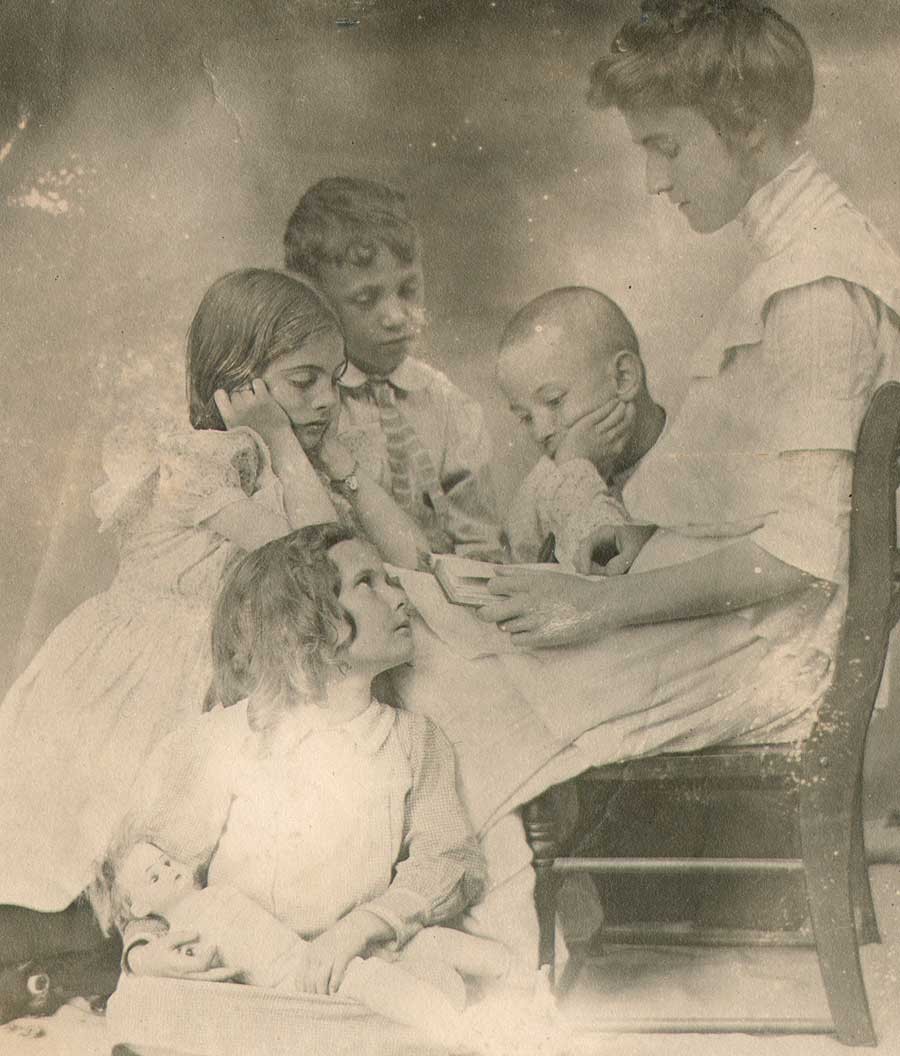 Detail: "Untitled Study of Woman Reading to Children: Juliana Royster, American: ( 1876-1962) ca. 1905-10: Gelatino-Choloride (POP) print: 11.8 x 10.0 cm: An artist who excelled in multiple mediums, Juliana Royster, from Raleigh, North Carolina, learned photography while attending Saint Mary’s School there, and is best known in the modern era for her founding in 1917, along with husband Jacques (born James) Busbee, (1870-1947) the Jugtown Pottery in Seagrove, North Carolina. From: PhotoSeed Archive
Detail: "Untitled Study of Woman Reading to Children: Juliana Royster, American: ( 1876-1962) ca. 1905-10: Gelatino-Choloride (POP) print: 11.8 x 10.0 cm: An artist who excelled in multiple mediums, Juliana Royster, from Raleigh, North Carolina, learned photography while attending Saint Mary’s School there, and is best known in the modern era for her founding in 1917, along with husband Jacques (born James) Busbee, (1870-1947) the Jugtown Pottery in Seagrove, North Carolina. From: PhotoSeed Archive
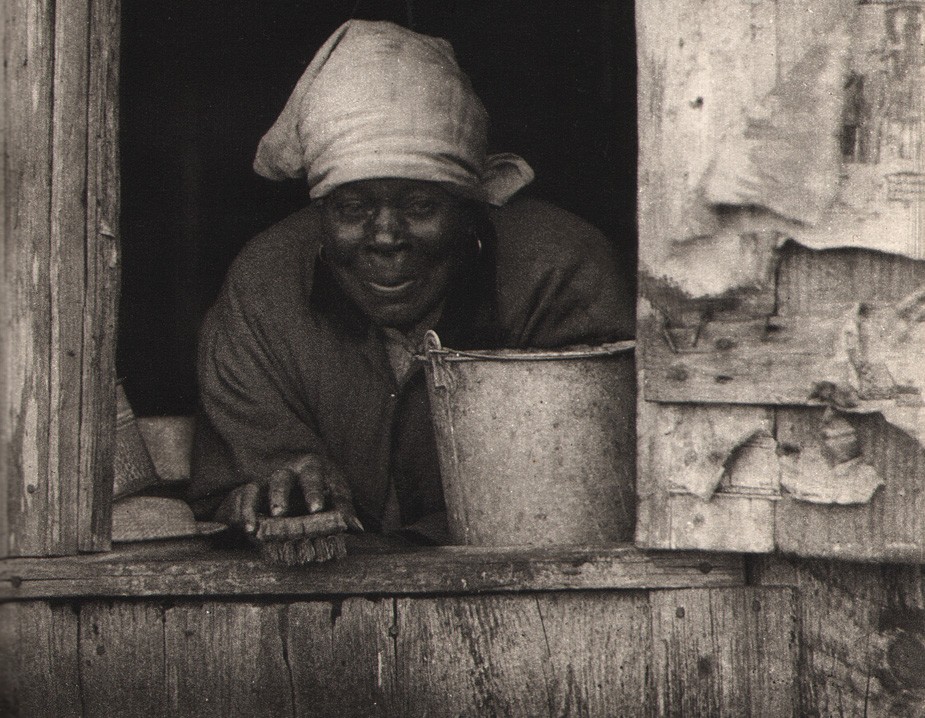 Detail: "Woman with Scrub brush Looking out Window": Doris Ulmann, American: (1882-1934): 1933: hand-pulled photogravure: Plate 66 from the deluxe volume Roll Jordan Roll: New York: Robert O. Ballou: (text by Julia Peterkin) 21.0 x 16.3 | 28.4 x 20.5 cm: A landmark photographic volume of the 20th Century featuring ethnographic studies and portraits, this volume features 90 full-page copperplate gravures done in the Pictorial manner. Writing for the Amon Carter Museum of American Art in Texas, author Steve Watson describes the volume in part: "The book focuses on the lives of former slaves and their descendants on a plantation in the Gullah coastal region of South Carolina. Peterkin, who won the Pulitzer Prize for her novel Scarlet Sister Mary (Indianapolis: Bobbs-Merrill, 1928), was born in South Carolina and raised by a black nursemaid who taught her the Gullah dialect. She married the heir to Lang Syne, a 2,000-acre cotton plantation, which became the setting for Roll, Jordan, Roll. Ulmann began photographing there in 1929." From: PhotoSeed Archive
Detail: "Woman with Scrub brush Looking out Window": Doris Ulmann, American: (1882-1934): 1933: hand-pulled photogravure: Plate 66 from the deluxe volume Roll Jordan Roll: New York: Robert O. Ballou: (text by Julia Peterkin) 21.0 x 16.3 | 28.4 x 20.5 cm: A landmark photographic volume of the 20th Century featuring ethnographic studies and portraits, this volume features 90 full-page copperplate gravures done in the Pictorial manner. Writing for the Amon Carter Museum of American Art in Texas, author Steve Watson describes the volume in part: "The book focuses on the lives of former slaves and their descendants on a plantation in the Gullah coastal region of South Carolina. Peterkin, who won the Pulitzer Prize for her novel Scarlet Sister Mary (Indianapolis: Bobbs-Merrill, 1928), was born in South Carolina and raised by a black nursemaid who taught her the Gullah dialect. She married the heir to Lang Syne, a 2,000-acre cotton plantation, which became the setting for Roll, Jordan, Roll. Ulmann began photographing there in 1929." From: PhotoSeed Archive
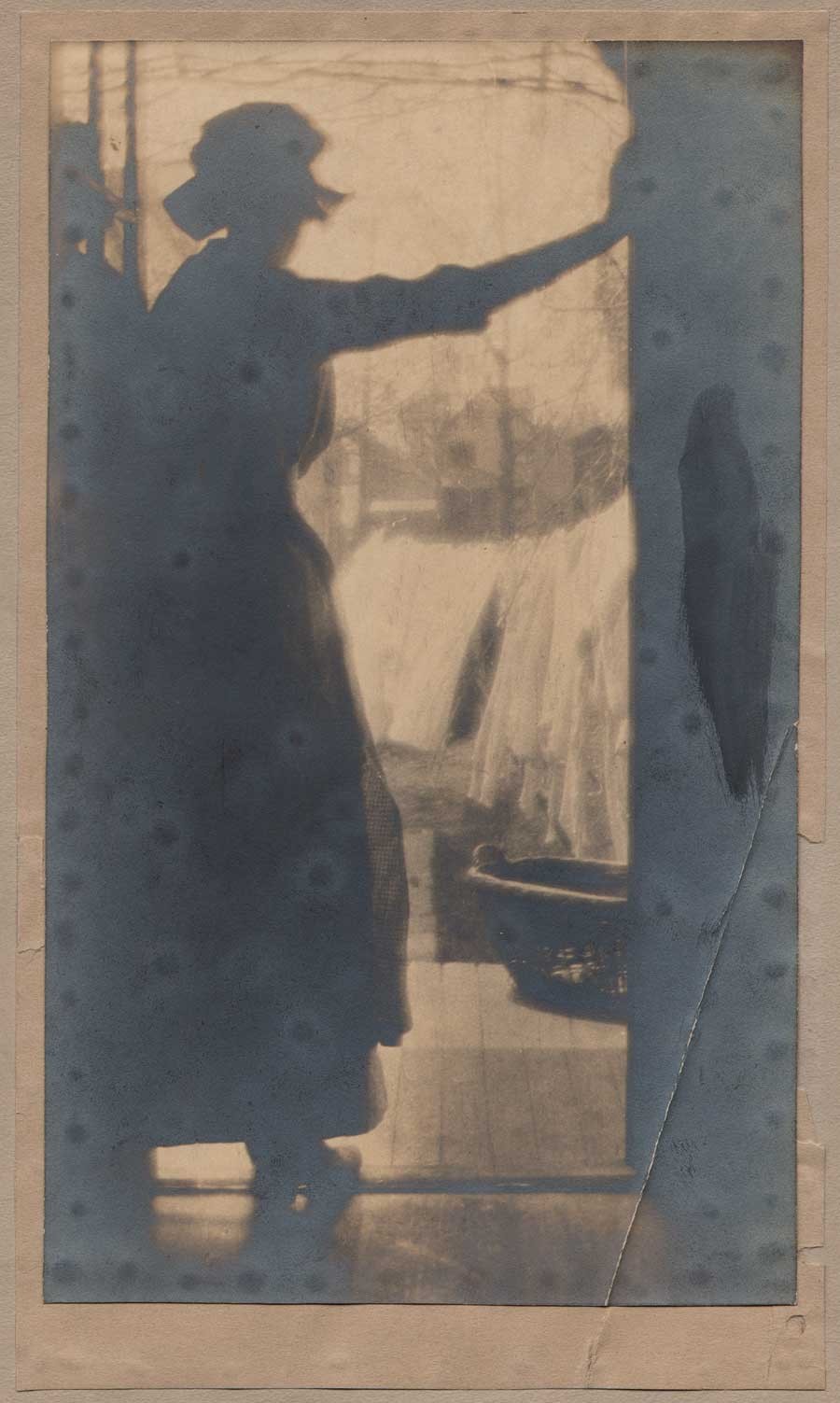 "A Moments Leisure": Ben J. Boyd: American, ( 1881-1958): ca. 1915-20: Gelatin Silver print, mounted: 24.0 x 14.4 | 26.3 x 15.4 | 34.2 x 26.6 cm: Silhouetted in a doorway, a woman takes a break from hanging laundry seen at center in this unusual home-life study depicting the everyday struggle of women done here by long-time Wilkes-Barre, PA resident and Camera Club member Benjamin Joslin Boyd. From: PhotoSeed Archive
"A Moments Leisure": Ben J. Boyd: American, ( 1881-1958): ca. 1915-20: Gelatin Silver print, mounted: 24.0 x 14.4 | 26.3 x 15.4 | 34.2 x 26.6 cm: Silhouetted in a doorway, a woman takes a break from hanging laundry seen at center in this unusual home-life study depicting the everyday struggle of women done here by long-time Wilkes-Barre, PA resident and Camera Club member Benjamin Joslin Boyd. From: PhotoSeed Archive
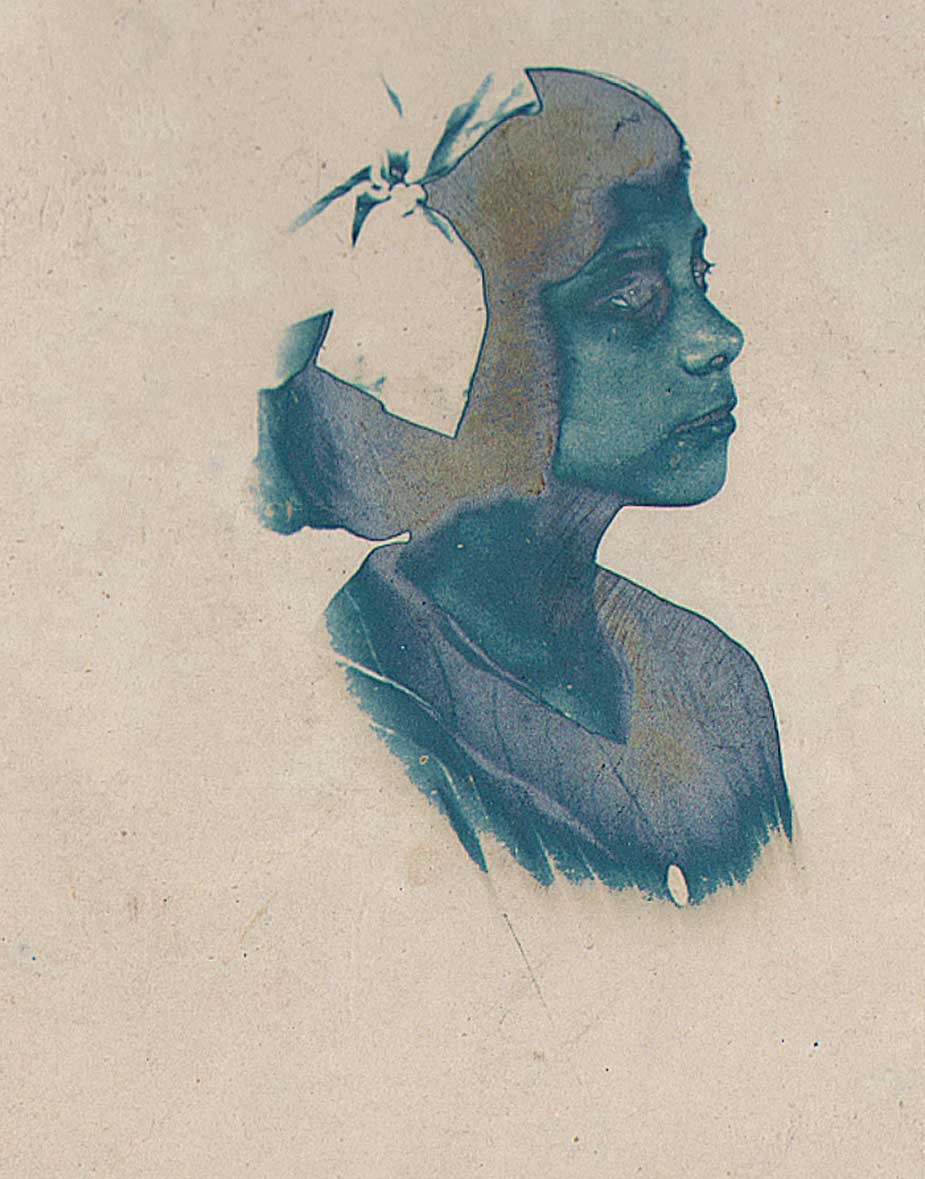 "Female Head Study": unknown, probably American photographer: ca. 1900-20: Reverse negative, Gelatin-silver over Cyanotype photograph, unmounted: 8.7 x 6.2 cm: Whether intentional or not, and for the purposes of this post, this alternative, multi-process study of a young woman is symbolic for a joyous, multi-ethnic celebration of women's diversity everywhere. From: PhotoSeed Archive
"Female Head Study": unknown, probably American photographer: ca. 1900-20: Reverse negative, Gelatin-silver over Cyanotype photograph, unmounted: 8.7 x 6.2 cm: Whether intentional or not, and for the purposes of this post, this alternative, multi-process study of a young woman is symbolic for a joyous, multi-ethnic celebration of women's diversity everywhere. From: PhotoSeed ArchiveStep right up and see the show!
Posted March 2015 in New Additions, Significant Photographs
P.T. Barnum gave me permission. A recent news item that Ringling Bros. and Barnum & Bailey Circus would send their remaining ponderous performing pachyderms to a Florida retirement home by 2018 got me to thinking recently. Did I not possess in my archive one very old mysterious photograph of a stuffed elephant? Sure enough, I did.
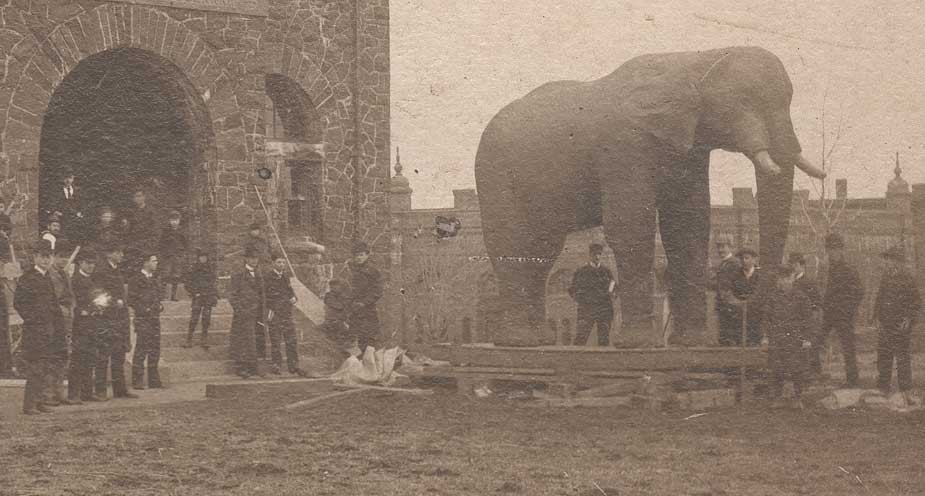 Detail: "Moving Jumbo into Barnum Museum, 1889" (assigned title by Tufts University Archives- see variant:ID: tufts:UA136.002.DO.00823 ): Attributed photographer: Charles Rollins Tucker, American (b. 1868): 1889: mounted brown-toned gelatin silver print on cabinet card: 8.3 x 11.0 cm | 10.8 x 13.2 cm. This rare photograph believed to have been taken on April 3, 1889 posthumously shows the famed circus elephant Jumbo (died 1885) formerly owned by circus showman P.T. Barnum sitting outside the Barnum Museum of Natural History on the Tufts College campus in Medford, Mass. before being placed on display. Vintage photograph from: PhotoSeed Archive.
Detail: "Moving Jumbo into Barnum Museum, 1889" (assigned title by Tufts University Archives- see variant:ID: tufts:UA136.002.DO.00823 ): Attributed photographer: Charles Rollins Tucker, American (b. 1868): 1889: mounted brown-toned gelatin silver print on cabinet card: 8.3 x 11.0 cm | 10.8 x 13.2 cm. This rare photograph believed to have been taken on April 3, 1889 posthumously shows the famed circus elephant Jumbo (died 1885) formerly owned by circus showman P.T. Barnum sitting outside the Barnum Museum of Natural History on the Tufts College campus in Medford, Mass. before being placed on display. Vintage photograph from: PhotoSeed Archive.
Looks kinda important.
Bunch of people standing outside a building… with a really big stuffed elephant.
Now to some Google “research”.
It’s Jumbo!
As in: “Jumbo was the greatest circus attraction in American history.” (1.)
So now I’m more interested in that old photo. But then it dawns on me: several years ago, I had purchased a trove of material taken by an amateur photographer named Charles Rollins Tucker. Never heard of him? Tufts College. Class of 1891. Bachelor of Philosophy with specialties in chemistry and physics, then a Master of Arts from the same institution in 1894. From Stoughton, Massachusetts, Tucker first resided in East Hall (room 26) on the Tufts campus after first matriculating in the Fall of 1887. Trust me. I know a great deal more, and eventually, time willing, you will too. Several photographs of his daughter Dorothy, (also a Tufts graduate) including “Girl with Kodak“ and an earlier study of her photographing her doll have been hiding in plain site on this website for several years now, and I eventually hope to show the progression of her growing up in a wonderful series of images taken by her father.
But now back to the main attraction, that old photograph. Like I said, Barnum would approve.
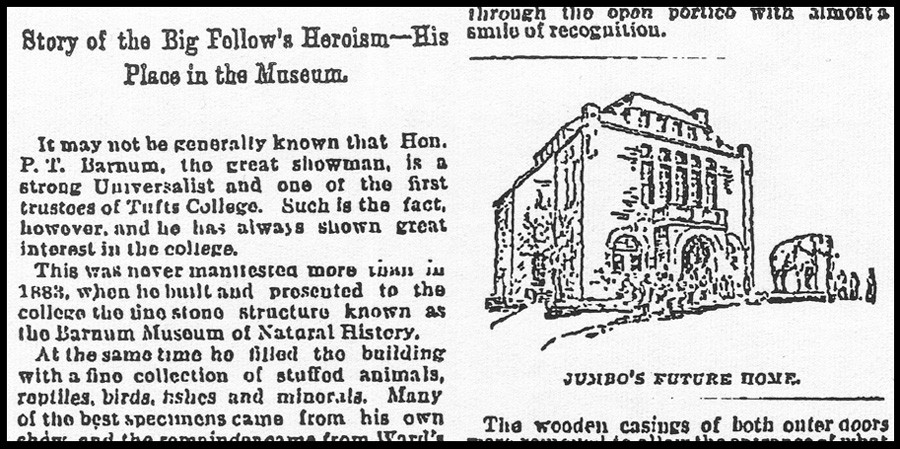 A woodcut taken from the Charles Tucker photograph of Jumbo before being placed on display inside the Barnum Museum of Natural History on the Tufts College campus on April 3, 1889 is one of two accompanying an article written by Tufts graduate and Boston Daily Globe reporter Julien C. Edgerly for the April 4, 1889 edition of the newspaper.
A woodcut taken from the Charles Tucker photograph of Jumbo before being placed on display inside the Barnum Museum of Natural History on the Tufts College campus on April 3, 1889 is one of two accompanying an article written by Tufts graduate and Boston Daily Globe reporter Julien C. Edgerly for the April 4, 1889 edition of the newspaper.
The Particulars
Jumbo, a word synonymous with someone or something very large or huge-especially so in the American lexicon, was an African elephant of immense proportions. According to Wikipedia, he was also the first “international animal superstar” after showman Phineas Taylor Barnum (1810-1891) purchased him from the London Zoo in 1882 for $10,000. However, in September of 1885, after entertaining North American circus audiences for a bit more than 3 years, he came to an inglorious end after being accidentally struck by a freight train after a Canadian performance.
Barnum being Barnum, a little thing like death was certainly not going to get in the way of Jumbo thrilling audiences while continuing to replenish his masters coffers- albeit in a more restrained and static way. An early trustee and munificent benefactor of the school, he gave it $55,000 in 1882 for the establishment of the Barnum Museum of Natural History on the campus, which was completed by 1884. Housing a museum of natural history showcasing a multitude of stuffed circus and zoological animal specimens as well as laboratories and classrooms, arrangements for Jumbo’s remains had been planned even while he was still alive. Overseeing the museum was John Marshall, the first professor of natural history at the school, who had presciently written to Henry A. Ward, Barnum’s taxidermist extraordinaire and owner of the “Natural Science Establishment” in Rochester, N.Y. two weeks before Jumbo’s death:
College Hill. Sep 1. 1885.
Dear Prof. Ward.
We fully expect to have the skin of Jumbo when he dies. Jumbo was excepted when the arrangement was made with the Smithsonian. I should not consider the Barnum Museum complete without this noble animal. It would be the greatest ornament that we could place in the Vestibule, near Mr. Barnum’s bust. Our front door to the Museum is [blank] feet high. You can judge whether the stuffed Jumbo would go in. It is wide enough, I think. Probably it would be necessary to stuff the skin in the vestibule. I have not decided upon the skeleton yet but will endeavor to let you know soon. - I think your offer to Mr. Barnum was $75 in exchange or $50 in money. Would you object to letting the $50 go towards the skulls? -
Yours very truly.
John P. Marshall (2.)
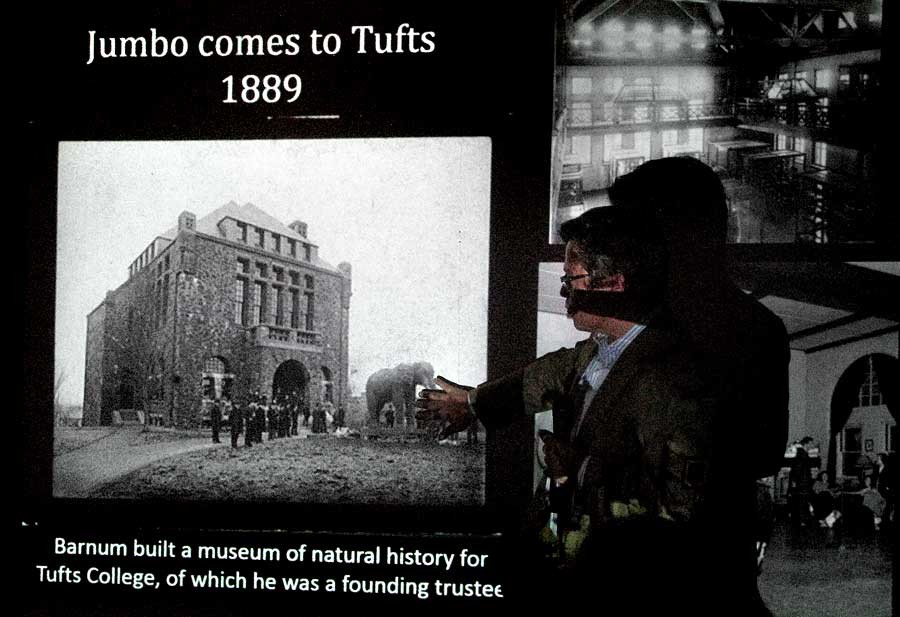 Tufts University Professor of Art History Dr. Andrew McClellan points to the photograph of the stuffed Jumbo before the elephant was placed on display inside the natural history museum on the Tufts campus in 1889 during a public lecture he gave at the Barnum Museum in Bridgeport, CT in April, 2015. In 2014, for the 125th anniversary of the arrival of Jumbo at Tufts, McClellan curated the life story of the famed elephant as part of the exhibit "Jumbo: Marvel, Myth, and Mascot", with the university publishing a pictorial monograph authored by him by the same title. Photo by David Spencer/PhotoSeed Archive
Tufts University Professor of Art History Dr. Andrew McClellan points to the photograph of the stuffed Jumbo before the elephant was placed on display inside the natural history museum on the Tufts campus in 1889 during a public lecture he gave at the Barnum Museum in Bridgeport, CT in April, 2015. In 2014, for the 125th anniversary of the arrival of Jumbo at Tufts, McClellan curated the life story of the famed elephant as part of the exhibit "Jumbo: Marvel, Myth, and Mascot", with the university publishing a pictorial monograph authored by him by the same title. Photo by David Spencer/PhotoSeed Archive
After Jumbo’s demise, Ward was dispatched to Canada in order to secure the animal’s remains, not an easy task. Arriving two days after the accident on Sept. 17, souvenir seekers had to be kept at bay by police:
In addition to the problem of size, Jumbo’s fame caused added complications. Relic seekers had done some damage before Ward arrived, and a policeman had been put on guard to prevent further mutilation. It took Ward, his assistants, and half a dozen butchers from St. Thomas, two days to dissect the elephant and prepare the hide and skeleton for shipment. The hide weighed 1,538 pounds, the bones 2,400 pounds. Coins of many kinds were found in Jumbo’s stomach, and Ward was quoted as having said that “Jumbo was a bank all by himself.” His stomach also contained rivets, a bunch of keys on a ring, a policeman’s whistle, and various ornaments. (3.)
By March of the following year, after his skin had been tanned and “scraped to a uniform thickness and nailed to a huge wooden framework with 74,480 nails”, (4.) Ward’s Natural Science Establishment delivered two finished mounts of Jumbo to Barnum at a reported cost of $1200.00: (5.) one of his skeleton and another for his hide. This stuffed version of Jumbo, after two additional years of touring with The Greatest Show on Earth, eventually made its’ way to Medford and the college via train after Barnum made the decision to (mostly) “retire” him from traveling circus life.
A Rare Survivor
With this mounted cabinet card seemingly the only photographic evidence of his arrival on campus, it must have been quite a sight to see all the steps taken to safely transport Jumbo by train, ferryboat and horse-drawn carriage on his final journey to Tufts. Beginning on Friday, March 29 from his winter home in Bridgeport, CT , Jumbo finally arrived in front of the Barnum museum at the college on Wednesday, April 3, 1889, with the final leg of the journey described as:
…” he was hauled to Tufts by a double team of horses. When that team proved unable to pull him up College Hill, more than 50 Tufts professors and students, aided by some local boys, completed the task.” (6.)
An alternate dispatch from 1888 Tufts graduate Julien C. Edgerly, (1865-1913) a reporter and news editor for the Boston Daily Globe newspaper who witnessed the famed elephants arrival on campus, wrote an article published in the edition for Thursday, April 4, 1889, illustrated by a small woodcut of the mounted cabinet card seen here. Conclusive proof it was taken by Tufts student Charles Rollins Tucker-albeit without being named directly-was included in Edgerly’s article. Some excerpts:
The mounted skin of Jumbo this morning stands in front of the museum on the top of College hill, as shown in the accompanying cuts, one of which shows the animal with a man at his side to give by contrast an idea of his size, and the other shows both Jumbo and the building which, barring the cadence of fortune, is destined to be his last long home. …
After Jumbo made his final journey, pulled by 6 horses up College Hill to the front doors of the Barnum Museum, the carriage he was riding on was “taken apart and drawn away.” … and:
The canvas coverings were removed to allow a student photographer to transfer his image to the plate of the camera. Several views were taken, some with ambitious young men upon the great beast’s back. Then the coverings were replaced and he will stand as lone sentinel till today when he will be placed inside the museum. He will occupy the centre of the large front room, facing the entrance. (7.)
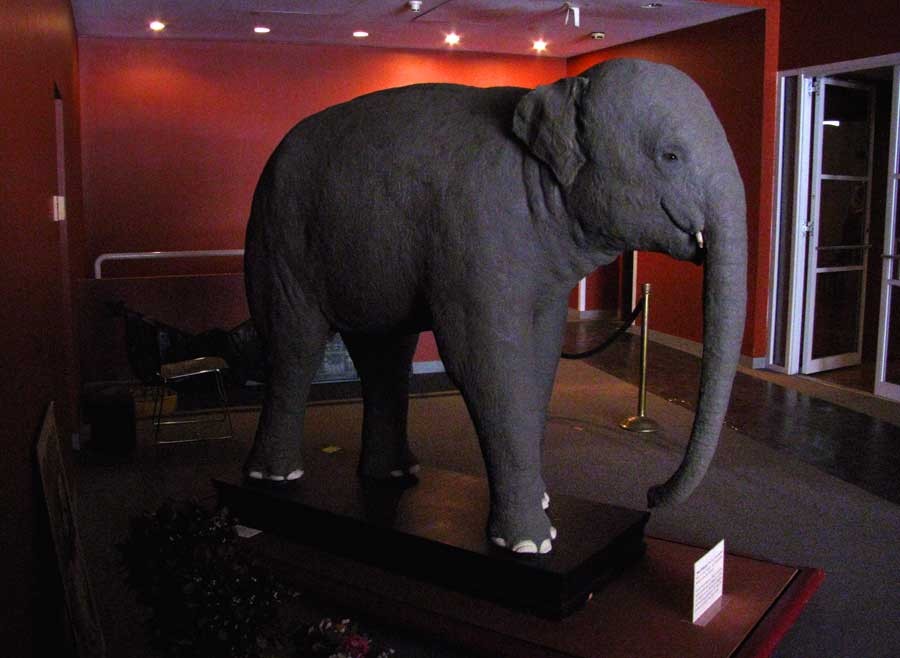 A survivor indeed. Standing nearly 7' and weighing 700 pounds, "Baby Bridgeport" is a preserved Asian elephant that was only the second elephant born in captivity in America owned by P.T. Barnum. Similarly mounted like Jumbo by taxidermist Henry Ward when he died at four years of age in 1886 and originally displayed alongside Jumbo inside the Barnum museum at Tufts in 1889, Baby Bridgeport continues to be a popular attraction for visitors to the Barnum Museum in Bridgeport, CT seen here in April, 2015. Photo by David Spencer/PhotoSeed Archive
A survivor indeed. Standing nearly 7' and weighing 700 pounds, "Baby Bridgeport" is a preserved Asian elephant that was only the second elephant born in captivity in America owned by P.T. Barnum. Similarly mounted like Jumbo by taxidermist Henry Ward when he died at four years of age in 1886 and originally displayed alongside Jumbo inside the Barnum museum at Tufts in 1889, Baby Bridgeport continues to be a popular attraction for visitors to the Barnum Museum in Bridgeport, CT seen here in April, 2015. Photo by David Spencer/PhotoSeed Archive
Professor Marshall, writing in the Annual Report of the President of Tufts College for 1889, also gave an interesting account of Jumbo’s arrival that day, commenting Jumbo had increased visitors to the museum among other observations:
Jumbo was brought to the Barnum Museum on Fast Day of the present year, and moved into the vestibule the following day. All the wood-work was removed from the great arch of the portico, leaving barely room for the entrance of the largest mounted elephant of modern times. It will be taken away, September 20, to be exhibited in London during the coming winter. About the first of April of next year, it will become a permanent attraction of the Museum. During the five months of its exhibition here the number of visitors to the Museum was largely increased. Your attention is again respectfully invited to the need of additional cases for the proper exhibition of specimens which have been accumulating during the past two years.
Respectfully submitted,
JOHN P. MARSHALL,
Director. Tufts College,
September 19, 1889. (8.)
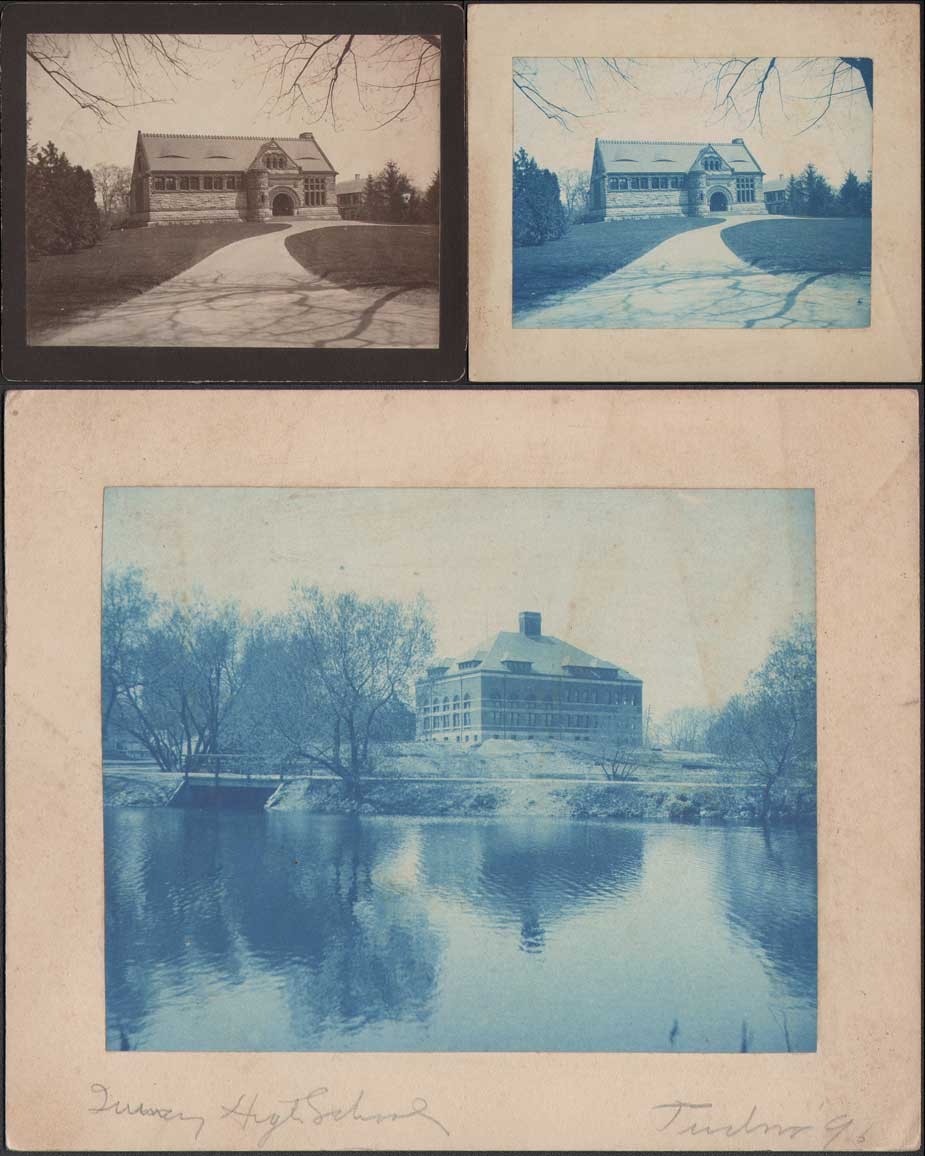 Top left: Exterior entrance view showing the Thomas Crane Public Library (built 1882) by architect Henry Hobson Richardson in Quincy, Mass. : Attributed photographer: Charles Rollins Tucker, American (b. 1868):Vintage brown-toned gelatin silver print on cabinet card: 9.0 x 11.8 cm | 10.8 x 13.2 cm. Top Right: Exterior entrance view showing the Thomas Crane Public Library (built 1882) by architect Henry Hobson Richardson in Quincy, Mass. : Attributed photographer: Charles Rollins Tucker, American (b. 1868): 1896: Vintage cyanotype print on cabinet card: 9.1 x 12.0 cm | 12.7 x 15.2 cm. Bottom: Exterior view of "Quincy High School" with pond in foreground: Signed lower right: "Tucker '96": Charles Rollins Tucker, American (b. 1868):Vintage cyanotype print on cabinet card: 9.4 x 11.9 cm | 12.7 x 15.3 cm. All from: PhotoSeed Archive
Top left: Exterior entrance view showing the Thomas Crane Public Library (built 1882) by architect Henry Hobson Richardson in Quincy, Mass. : Attributed photographer: Charles Rollins Tucker, American (b. 1868):Vintage brown-toned gelatin silver print on cabinet card: 9.0 x 11.8 cm | 10.8 x 13.2 cm. Top Right: Exterior entrance view showing the Thomas Crane Public Library (built 1882) by architect Henry Hobson Richardson in Quincy, Mass. : Attributed photographer: Charles Rollins Tucker, American (b. 1868): 1896: Vintage cyanotype print on cabinet card: 9.1 x 12.0 cm | 12.7 x 15.2 cm. Bottom: Exterior view of "Quincy High School" with pond in foreground: Signed lower right: "Tucker '96": Charles Rollins Tucker, American (b. 1868):Vintage cyanotype print on cabinet card: 9.4 x 11.9 cm | 12.7 x 15.3 cm. All from: PhotoSeed Archive
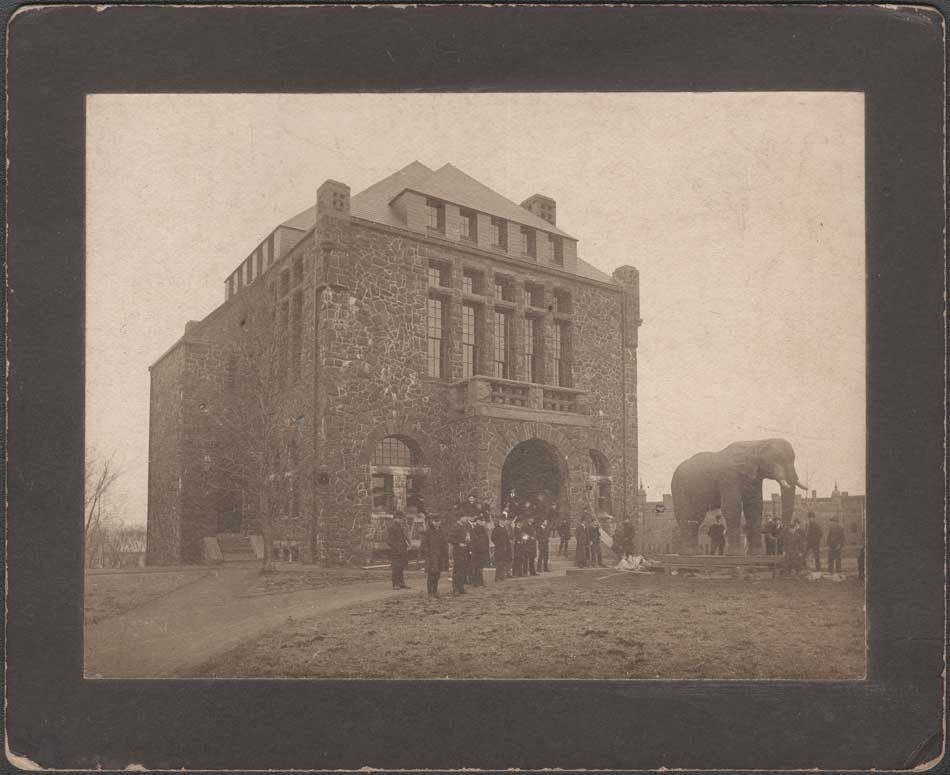 "Moving Jumbo into Barnum Museum, 1889" (assigned title by Tufts University Archives- see variant:ID: tufts:UA136.002.DO.00823 ): Attributed photographer: Charles Rollins Tucker, American (b. 1868): 1889: mounted brown-toned gelatin silver print on cabinet card: 8.3 x 11.0 cm | 10.8 x 13.2 cm. This rare photograph taken on April, 3 1889 posthumously shows the famed circus elephant Jumbo (died 1885) once owned by circus showman P.T. Barnum, now stuffed, sitting outside the Barnum Museum of Natural History on the Tufts College campus in Medford, Mass. before being placed on display. Vintage photograph from: PhotoSeed Archive.
"Moving Jumbo into Barnum Museum, 1889" (assigned title by Tufts University Archives- see variant:ID: tufts:UA136.002.DO.00823 ): Attributed photographer: Charles Rollins Tucker, American (b. 1868): 1889: mounted brown-toned gelatin silver print on cabinet card: 8.3 x 11.0 cm | 10.8 x 13.2 cm. This rare photograph taken on April, 3 1889 posthumously shows the famed circus elephant Jumbo (died 1885) once owned by circus showman P.T. Barnum, now stuffed, sitting outside the Barnum Museum of Natural History on the Tufts College campus in Medford, Mass. before being placed on display. Vintage photograph from: PhotoSeed Archive.
Picking up the Ashes
Jumbo has given back to Tufts, no pun intended, in a Huge way. Period accounts state he was immediately adopted as the school’s new mascot shortly after his arrival in 1889 and continues in that role today at Tufts University. The school website, semantics aside, brags Jumbo is the “only college mascot found in Webster’s Dictionary.” But alas, Jumbo endured a second death, this time by fire in 1975, when faulty wiring lead to a conflagration that gutted the 1884 Barnum museum. But all was not lost. Fortunately, the school’s archives held a section of Jumbo’s tail removed earlier because of students continual penchant for tugging on it, and a university staff member, while the rubble was still smoldering, had the smarts to scoop up some of his ashes that now reside in a Skippy peanut butter jar at the school. (nice trivia question- it’s secured with a Peter Pan Crunchy brand lid) Members of the sports teams on campus are said to rub this jar for good luck before an important game, and students indelible memories of college life at Tufts have been published every year since 1917 in the “Jumbo” yearbook.
With reporter Julien Edgerly’s account of a Tufts student photographer recording Jumbo for posterity in front of the museum on April 3, 1889, my argument and “Conclusive proof” Charles Rollins Tucker was that author working with Edgerly seems credible. For comparison, the Tufts archives holds a photograph dated 1889 showing Jumbo later on exhibit inside the museum credited to noted marine photographer N. L. Stebbins. (Nathaniel Livermore Stebbins-1847-1922) But given Jumbo’s immense fame, why is there no back-mark or other attribution for Stebbins for this exterior view of Jumbo? Surely, like one of his famous yachting studies, Stebbins would have insisted on it!
On his way to becoming a fine pictorialist photographer in the early 20th Century, Charles Tucker took a series of architectural photographs that survive in this archive which further gives credibility to his being responsible for the 1889 exterior Jumbo photograph. These include several examples seen above showing (ca. 1890-95) one of architect Henry Hobson Richardson’s masterpieces, the Thomas Crane Public Library (built 1882) located in Quincy, south of Boston. This is a gelatin silver mounted cabinet card using the same card-stock as the Jumbo photograph as well as a variant mounted cyanotype on a different paper stock. Finally, when he finished with his masters degree in late 1894 at Tufts, Tucker became sub-master until 1896 at Quincy High School- the same town as Richardson’s library. Two of his photographic views of this additionally survive, with a card-mounted, signed cyanotype by him dated 1896 seen here.
Notes:
1. excerpt: Step Right Up! : Bob Brooke presents the history of the circus in America : from: History Magazine: October/November 2001 issue: online version accessed March, 2015.
2. excerpt: Jumbo: by John R. Russell: in: University of Rochester Library Bulletin: vol. III, no. 1: Fall, 1947: River Campus Libraries online resource accessed March, 2015
3. Ibid
4. excerpt: Jumbo: Here and There at Tufts: Medford: Tufts College: Lewis Doane, Editor-in-chief: 1907: p. 44
5. excerpt: Jumbo: by John R. Russell: in: University of Rochester Library Bulletin: vol. III, no. 1: Fall, 1947: River Campus Libraries online resource accessed March, 2015
6. excerpt: Jumbo Matriculates: from: An Elephant’s Tale: Susan Wilson, J69, G75: Tufts online Magazine: Spring, 2002
7. The Boston Daily Globe: Thursday, April 4, 1889: p. 4
8. excerpt: Annual Report of the President of Tufts College: Boston: 1889: p. 36
